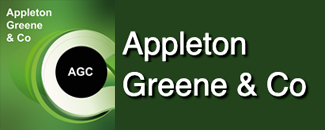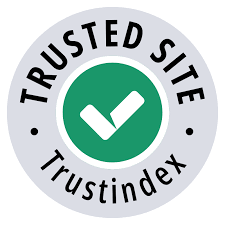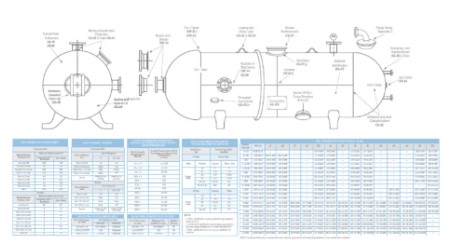Engineering Excellence – Workshop 1 (Stage Gates)

The Appleton Greene Corporate Training Program (CTP) for Engineering Excellence is provided by Mr. Feldhake Certified Learning Provider (CLP). Program Specifications: Monthly cost USD$2,500.00; Monthly Workshops 6 hours; Monthly Support 4 hours; Program Duration 12 months; Program orders subject to ongoing availability.
If you would like to view the Client Information Hub (CIH) for this program, please Click Here
Learning Provider Profile

In order to advance cutting-edge solutions in large-scale initiatives for Fortune 500 companies like MillerCoors, Anheuser Busch, Peabody, Owens Corning, Chrysler, and Boeing, Mr. Feldhake, a consulting engineer with over 30 years of experience, combined his strong understanding of new and emerging technologies like AI/ML and advanced energy systems with product innovation, electrical, and industrial engineering, as well as cross-functional leadership acumen.
A dynamic changemaker who has demonstrated success in persuading stakeholders at all levels and facilitating communication between internal and external parties to strengthen collaborations on the creation and marketing of new products. A skilled strategist who can link R&D goals with long-term business plans and continuously spot opportunities for process improvement, cost reduction, and extra income. Executive leaders create teams and cultures that produce high-caliber projects that cover everything from strategic planning to timely and cost-effective execution.
Several significant process improvement projects, years of field commissioning, SME assistance for the DOE Voucher program, and a novel patented neural network technology that learns in real time are among Mr. Feldhake’s own accomplishments. Mr. Feldhake keeps coming up with new ideas to improve performance and energy efficiency.
MOST Analysis
Mission Statement
The primary mission of this first workshop is to get a high-level grasp of what stages a project goes through. From large industrial projects spanning many years and with multi-million dollar budgets to smaller one-off in-house solutions to solve some immediate set of needs, the project stages are designed for the stakeholder to manage the outcome of the project. Therefore, it is important to understand the justifications, activities, and actions that should be taken during these project phases. Once reviewed, your team will assess your starting point and begin to focus the group on what steps are needed to align your organization along these lines.

Objectives
01. To define what a ‘conceptual’ level design is for your organization. Define who should be involved in these endeavors and the required minimum documents to generate.
02. To define how a project shall be teamed and managed in your organization once a project is undertaken from the conceptual stage.
03. Each project is different but requires certain metrics that will define its success. Whether it has a financial impact on operations or improving the quality of a product, criteria should be clearly stated. The goal here is to build into your organization the options for which a project should be undertaken.
04. Basic design is a sufficient design process to confirm the conceptual benefits. Define what the minimum set of documents should be provided in this stage.
05. As the project develops, a set of acceptance or performance criteria develops. Define how this criteria will be managed and presented.
06. Detailed design by most standards has the project design at 75% to 85% completion. This should include all aspects of the project, not just the obvious parts. Define what makes for a 100% design completed project and determine what percentage the completion should be for your organization.
07. Construction is itself a mini-project involving complex sequencing, organization and local ordinances. A clear definition on how projects will be managed in this phase is important for the stakeholders and project team.
08. Commissioning any new project involves tedious activities and checks that ensure the project deliverables are being met. Clear rules for executing commissioning along with supporting cast should be stated for the company.
09. Once a project, that might involve outside resources is commissioned, the company can now use the asset. However, there will be a performance and quality acceptance period for which the company needs to focus on to ensure the asset is what was expected.

Strategies
01. Defining something that starters undefined takes some creativity and experience with your product or service. Even new comers would require experience with similar products or services to be effective. Think through what minimum rules should apply for the definition of a concept, who should work on such projects, and what the stakeholders need to answer to decide to engage further.
02. Project work is very fulfilling but takes time to complete effectively. Once an organization has decided to go down the rabbit hole and execute a project, it behooves the group to support the project until a successful end. Staffing and supporting your project can also involve external subject matter experts (SME), temporary contractors or permanent employees assigned to other tasks as well.
03. Typically, projects either fall into two (or three) categories: 1) Financial or 2) Quality (or 3) Safety). The business process should clearly provide fields for team members to complete on each of these categories. This provides a clear path on which decision makers can base their decisions.
04. Projects take many forms, therefore the team members should clearly understand what deliverables are necessary for the stakeholders. This might include additional simulations, design calculations, basic layouts, and footprints.
05. Projects can involve multiple contractors and disciplines that speak different languages. Having a great set of tools, or predetermined matrices to build a set of criteria would be very helpful for the project team.
06. Since projects can effect many departments, provide additional metrics, or affect downstream and upstream processes, a completed project should consider all things company.
07. A clear understanding about how the company will conduct construction projects or phases will be critical to company success. Safety measures may be a concern for some projects, but some may need work areas for build-and-test exercises.
08. During commissioning, the timing of activities is very important to support other activities. Scheduling these into an hourly or daily timetable will be important. It is also critical that all the T’s and crossed and I’s dotted in the craftsmanship of the project. Checks should be such to verify all this.
09. Where commissioning is focused on the operation and function of the asset, acceptance is the company’s validation phase that ensures quality and performance criteria like rates, waste and recipes are met.
Tasks
01. Create a document clearly outlining what a conceptual project looks like for your organization. Define the who and provide the necessary authority for the execution. Finally, create the document examples that must be provided to conclude the conceptual effort and begin the stakeholder decision process. Add a couple ‘for instance’ examples of what a small vs large project might look like.
02. Define clearly in a document options for staffing the project moving on from the conceptual stage. Also, clearly define the roles and responsibilities of each of the departments in your organization and again provide the authority by which this will become practice.
03. Define how each success category shall be completed, managed, and presented to the stakeholder as one of the project deliverables.
04. Define a minimum set of documents that correspond to an effective basic design. Definitions can include ‘initial’ and ‘preliminary’ words and include items like sample code, calculations, etc.
05. Define an acceptance criteria matrix that provides the project team with assignable and contractually negotiable items to accept work and craftsmanship.
06. Define the final set of documents that make up a project and clearly state in what condition the document should be for a completed detail design stage. 06. Project types can provide clarity since not all projects will have the same types of documents.
07. Define what a construction project looks like for your company and determine the best resources, practices and methods for a safe and effective phase.
08. Define the planning documentation for a successful project commissioning. Planning for materials, tests, and interdepartmental support should be made clear.
09. At this stage, the company should be taking on the project assets and working it into production planning. Define how this transition will happen and what pre-steps the company should plan for.
Introduction

The Conceptual, Basic, Detailed Design, Construction, Commissioning, and Acceptance phases are the six stages that comprise the Stage-Gate engineering process. These phases are completed in the order listed above. As a consequence of the implementation of a waterfall methodology, these stages have been developed, each of which serves a single primary objective. In the majority of instances, a management team, steering committee, or governance board is the entity that decides whether or not to proceed at each gate. Some of the projections and pieces of information that are taken into consideration throughout the decision-making process include the business case, costs, the risk analysis, and the availability of the resources that are required.
The formulation and alignment of project goals, in addition to the implementation of suitable handoffs, are also necessary for each stage of the project. When the project is in the conceptual stage, for instance, even though it is possible that all of the details are unknown, the project team and the stakeholders should make an effort to determine whether there is any science that has not been established and/or find a solution to the problem as effectively as they can before moving on to the next stage. Throughout the entirety of the detail design stage, checks should be carried out to guarantee that all of the components that are necessary for the completion of the project as well as the infrastructure that is required have been prepared for.
While it is possible that certain engineering projects do not call for a staged plan, there are other instances in which the job may consist solely of resolving an immediate technical issue. Sometimes it is not required to take a phased strategy. On the other hand, even at this degree of activity, there should be a protocol in place to assist in ensuring that the exercise is successful. In subsequent conversations, more complicated topics, such as Process Improvement Teams (PIT), are brought up in response to these circumstances.
It will be necessary to make use of a variety of resources at various times in order to successfully coordinate these duties. It is possible that one of the most persuasive justifications for the employment of the stage-gate approach is the fact that it uses it to determine who is responsible for what and when, presenting a clear plan of action for the company and its stakeholders. Because of this procedure, the firm is able to become more efficient, and it also offers the required pre-work that must be completed before engagement. Since a project may also involve outside resources, vendors, and crafts as well, this process helps streamline the business and provides the necessary pre-work that must be done prior to engagement.
When discussing the stage-gate methodology, it’s important to recognize that while its structured framework can indeed create a sense of rigidity, it also serves a vital purpose in managing risk and ensuring that resources are allocated effectively. One way to counter the argument that it slows down innovation is to highlight that the method allows for clear checkpoints and decision-making processes. This can actually enhance focus and steer teams toward strategic goals, ultimately preventing wasted time on projects that are not viable. Furthermore, by identifying potential issues early in the process, teams can address challenges before they escalate, potentially saving time and resources in the long run.
The agility of an agile approach is certainly appealing for many projects, especially those in fast-paced environments where adaptability is crucial. It’s worth noting that an agile methodology can empower teams to respond to market demands quickly and iterate based on real-time feedback. However, some projects—especially larger or more complex ones—may require the structured oversight that stage-gate provides to align cross-functional teams and ensure that all aspects of the project are carefully examined. In this case, a blended approach that incorporates elements of both methodologies might offer the flexibility needed while maintaining the strategic oversight necessary for successful outcomes.
Finally, it is a valid point that smaller projects or those with clear, immediate objectives may not require the extensive planning that stage-gate entails. For such initiatives, a lighter touch might be appropriate—perhaps leveraging simplified checkpoints or adaptations of the framework that still allow for accountability without the full breadth of detail. The key is recognizing the specific context of each project. Allowing teams the freedom to choose a planning strategy that aligns with the scale and urgency of their objectives can lead to greater efficiency and faster results without undermining the integrity of the project’s goals.
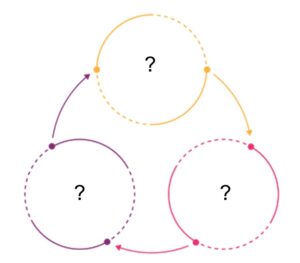
The Basic Process
After the commissioning and validation phases, the conceptual stage of any project—whether it entails a new product, process, or manufacturing enhancement—may be the most exciting. The Stage-Gate protocol works well for smaller, less distributive projects, even if it is usually utilized for bigger capital projects. As much as anything else, teamwork is essential to the project’s success. Depending on your business, you might have all or part of the necessary organization, but other businesses might not. Several organizational principles will be briefly reviewed in this course, along with how they function and/or combine to create a coherent working group.
There are many different types of metrics and different purposes for them. A process’s potential perception is determined by one set of criteria, and whether something qualifies is determined by another. We will talk about the many measures that are needed going ahead in this session. These indicators ought to have a direct bearing on software components, business processes, or industrial processes and direct the actions of your project management team.
 Project Costing
Project Costing
Project estimation is compiling information on the time, costs, and components of the project and arranging it so that interested parties may grasp it simply. This course will eventually cover several elements of the estimating process as well as techniques your company may apply and build upon. Project pricing is more art than science; it requires many skill sets, in-depth knowledge of your supply chain, and an awareness of how trades like software programmers or boilermakers function. Understanding the functioning of the supply chain is maybe one of the most important components of project costing.
Design Mode
The project team can go on to the following phase, known as the Basic Design, after the project has been initiated and received funding from the stakeholders. This phase is significant for a number of crucial reasons. The stage should first cover all necessary disciplines and produce a basic set of designs for each. Second, a thorough cost analysis of the designs should be carried out after they are comparatively finished. At this stage, key design elements, functionality, interactivity, and project success metrics will all be evident. These now serve as the foundation for your acceptance criteria, which may be used to draft the contracts you have with your suppliers and contractors. Actually, it is best to wait until this point in the process before drafting intricate contracts for the purchase of machinery, procedures, or tradecraft.
Acceptance Criteria
There will be a clear understanding of the key design elements, functionalities, and interactions that emerge as the project moves through the phases. This will be the foundation for your acceptance criteria. These criteria will be used to seed the contractual papers that will be created between you and your contractors and vendors. It is best to wait until the basic and detailed phases of the process to develop complex contractual agreements for purchasing equipment or processes.
Actually, these purchases ought to wait until the basic step is finished. Nonetheless, it is beneficial to consult with your vendors and subcontractors while creating the fundamental design. This is carried out in order to gather data and guarantee the project’s success.
Acceptance Criteria, which may include manufacturing rates and quality points, can also be client-driven, meaning that the client sets the requirements. As the project progresses, it could be beneficial to record further supporting documentation with the customer, given that some of these were generated earlier in the sales or concept stage.
To illustrate this, let’s look at a situation where the customer wants to maintain a certain level of minimal waste for a new package that the manufacturer cuts out of cardboard. There is a chance that the project concept may have recommended a particular pattern or design, but this may have been changed during the basic design stage to either increase the amount of waste or ensure that the amount of garbage is manageable. Following that, the client would want to approve this new pattern in order to allow the project team to proceed with their development without any more intervention.
Up to the construction phase, the detailed design step is the longest. This could include a variety of designs, computations, papers, verified computer code, procedures, and project-specific standards, depending on the type of project. Creating a constructable package with a set of deliverables that can be checked for completeness is the goal of the detailed design stage. It’s thrilling to finish a project’s design and enter the building phase. Like other phases, this construction phase can easily blend in with your other phases, but this should not confuse the process; rather, it should highlight the reasons why it should be strictly followed.
A Safety Moment
Managers ensure construction safety. It comes from equipment use, worker protection, site inspections, and risk assessments. Construction safety depends on area safety and health regulations.
 Improving construction safety decreases safety risks and helps meet workplace safety and health laws. Safety incidents can cost the company a lot of money and ruin its reputation with industry professionals and regulators.
Improving construction safety decreases safety risks and helps meet workplace safety and health laws. Safety incidents can cost the company a lot of money and ruin its reputation with industry professionals and regulators.
Medical and legal fees are other direct costs of injuries or sickness. Indirect expenses include training replacement staff, equipment or property maintenance, decreased production, and low worker morale.
Construction safety boosts worker, management, and executive confidence. Trust reduces workplace miscommunication and conflict. Construction safety improves worker productivity. Workers work safely and effectively when employers train and protect them. This is best for construction site induction.
10 Common Construction Safety Risks
Construction is one of the most dangerous industries, therefore safety managers may need to know what to watch out for to keep workers safe. Risk-specific checklists can be used by construction safety managers using mobile inspection apps.
1. Slips, falls, trips
Fall, slip, and trip accidents often involve ladders and heights. Preventing such fatalities requires ladder safety, a top ten OSHA violation.
2. Gears Move
Bystanders are at risk from scaffolds and ladders, but some are immovable. Transport, construction, and load-lifting equipment pose greater safety dangers than scaffolds and ladders.
3. Height Work
Working at heights is construction above 2 meters. A leading source of preventable workplace injuries and deaths globally.
4. Handle manually
Workplace manual handling includes lifting, lowering, carrying, and moving.
5. Noise
Noise as a construction safety issue seems odd, but data demonstrate otherwise.
Electricity 6.
Electricity causes the deadliest construction accident: electrocution.
7. Hand-arm oscillation
Hand-arm vibration syndrome (HAVS) irreversibly damages hand nerves and blood vessels.
8. Falling Trenches
Narrow underground excavation is trench. Collapsing trenches or cave-ins kill the most excavation workers, according to OSHA.
9. Dust
Blasting, cutting, drilling, grinding, and polishing bricks, tiles, concrete, and mortar creates silica dust.
10. Asbestos
Occupational asbestos exposure kills over 200,000 people worldwide, whereas asbestos-related diseases kill 12,000–15,000 Americans.
Completing the Project
The process of putting your project into action and creating something starts as building draws to a close. The procedures to commission your system, production line, or service are essentially the same, even if your project does not involve any hardware or electro-mechanical components. The necessary stages will be in line with most projects because your organization is using the stage-gate process as your primary engineering method. Additionally, most of the material is still highly applicable, even though research projects are not covered in this course.
The project’s acceptance stage is distinct from the commissioning stage. The client’s use and operation of the new system, as well as the system’s product quality, are the focus of this phase. Depending on the market, this may also involve last-minute validation tests to solidify the commissioning stage before the system is used to create a marketable product.
During this session, you will begin to understand the complex nature of the engineering cycle and start documenting what your process might look like. As the course develops, this scope and business process plan will become precise and substantial.

History
A lack of planning by the project execution team was found in multiple studies conducted during capital project governance reviews. This is due because of a lack of understanding the process of what makes a good project. Although a project team may be highly skilled, unless the company is fully onboard with the project and its execution, the team can flounder and fail.
Enterprise risk management and other procedures that center on their main business are areas in which many organizations excel. However, managing technically complicated, deadline-driven Capital programs may not be a simple task for the same tools that lead a bottom-line-focused business. Project owners who employ strong governance practices tailored to the requirements of the capital project delivery process are the most likely to meet their cost, schedule, performance, and quality objectives, according to our experience advising on the planning and execution of capital projects across a variety of industries.
Controlling budget overruns and financial limitations is another concern. Poor cost controls are partly to blame for the estimated 69% of capital projects that go over budget by more than 10%. It is possible to detect possible issues that can lead to cost overruns before they become irreparable by collecting data to support precise project budgets and forecasts, regularly monitoring performance against the forecast, and revising the prediction when new information becomes available. The longer an issue persists in a project, the more difficult it is to control the budget. The visibility, governance, and structure needed to spot any problems and make necessary adjustments to keep projects within budget can be obtained by putting in place an efficient project and portfolio management technology platform.
In many investigations that were carried out during governance evaluations of capital projects, it was discovered that the project execution team did not exercise sufficient planning. The reason for this is that there is a lack of comprehension of the process of what constitutes a successful project. In spite of the fact that a project team may possess a high level of expertise, the team may encounter difficulties and failure if the firm does not fully support the project and its implementation.
Enterprise risk management and other procedures that are centered on the organization’s primary business are areas in which many firms possess exceptional capabilities. On the other hand, the same tools that are used to lead a firm that is focused on the bottom line might not be able to handle the challenge of managing technically difficult and deadline-driven capital initiatives. Experience shows that the planning and execution of capital projects across a variety of industries has shown that project owners who employ strong governance practices that are tailored to the requirements of the capital project delivery process are the most likely to meet their cost, schedule, performance, and quality objectives. Project owners who do not employ such practices are less likely to meet their objectives.

Case Study – Brandenburg Airport in Berlin
It took 30 years and almost $8 billion to build the Berlin Brandenburg Airport (BER), which was once intended as a project to rejuvenate unified Germany after the war.
October 2011 was the planned opening date, and work started in 2006.
But by the time the airport opened for business on October 31, 2020, the expenses had skyrocketed.
 What then transpired throughout these fourteen years?
What then transpired throughout these fourteen years?
The fact that no general contractor was initially hired didn’t help, to start, but the following were the primary reasons for cost overruns:
● Unfeasible design modifications
● Inadequate spatial planning
● A malfunctioning fire safety system
● Mismanagement in general
When addressing someone who argues that the success of capital projects is primarily influenced by external factors such as market conditions and regulatory changes, it’s essential to acknowledge the validity of their perspective. External factors undoubtedly play a significant role, but it’s equally important to emphasize that effective planning and organizational support can mitigate some of these risks. For instance, a well-prepared organization is more likely to adapt to market fluctuations and navigate regulatory hurdles. By developing a robust risk management strategy and fostering a culture of adaptability, organizations can better position themselves to respond to these external challenges. Therefore, while external factors are influential, the internal capabilities and proactive measures of an organization are equally critical in determining the success of capital projects.
In considering whether the expertise of the project team is as pivotal as the collaboration and communication between stakeholder groups, it’s vital to recognize the interconnectedness of these elements. Expertise undoubtedly provides the technical knowledge necessary to execute tasks effectively; however, without strong collaboration and communication, even the most skilled individuals may struggle to align their efforts with the project’s overall goals. Stakeholder engagement fosters a shared understanding of objectives, facilitates the exchange of ideas, and encourages innovation. It is through dynamic interactions among diverse team members that solutions are often generated, and potential issues can be addressed promptly. Therefore, while expertise is important, the synergy created through collaboration and communication can significantly enhance project outcomes.
To a reader who believes that governance practices can introduce unnecessary layers of bureaucracy that obstruct timely decision-making in capital project execution, it’s important to provide a balanced view. Good governance is essential for accountability, transparency, and strategic alignment in projects. However, it’s true that overly rigid governance frameworks can hinder progress and lead to frustration. The key is to strike a balance—establish governance practices that ensure oversight and risk management while also allowing for flexibility and responsiveness. Streamlining processes and empowering project teams to make certain decisions can help maintain momentum. Ultimately, governance should serve as a framework for guidance and support rather than as a barrier. By engaging in regular reviews of governance structures, organizations can optimize their approach to ensure it meets the dynamic needs of capital project execution.
Another challenge is the management of budget overruns and the constraints imposed by fiscal constraints. One of the factors that contributes to the estimated 69% of capital projects that go over budget by more than 10% is the lack of effective cost management measures. By collecting data to support exact project budgets and forecasts, routinely checking performance against the forecast, and modifying the prediction when new information becomes available, it is possible to discover potential difficulties that can lead to cost overruns before they become irreparable. This can be accomplished by gathering data. One of the most challenging aspects of managing a project’s budget is the length of time that an issue continues to exist. Through the implementation of an effective technology platform for project and portfolio management, it is possible to acquire the visibility, governance, and structure that are required to identify any issues and make the necessary adjustments in order to maintain projects within their budgetary constraints.
While it’s true that unforeseen economic changes or regulatory shifts can impact projects, project managers still have a critical role in mitigating these risks. It’s essential for project managers to conduct thorough risk assessments and develop contingency plans to prepare for potential external disruptions. Engaging stakeholders early and regularly reassessing project conditions can help identify new risks. Additionally, effective communication and flexibility in project planning can help teams adapt to unforeseen challenges without falling significantly over budget. Emphasizing proactive management can show that, while external factors may be influential, there are still avenues for control and mitigation.
It’s also important to recognize that cost management strategies often need to be tailored to specific contexts and industries. For instance, what works in construction might not be as effective in software development due to their fundamentally different processes and risk profiles. Understanding the unique challenges of each industry can guide the adaptation of cost management measures. To enhance the applicability of proposed solutions, a thorough analysis of industry-specific factors should be considered. Moreover, continuous feedback loops and learning from past projects in varied industries can inform improvement and foster the development of more universally relevant strategies over time.

Future Outlook
An excellent foundation from which to learn and document these methods has been provided over the past one hundred years, which has made it possible to investigate and publish improved methods for project management. In the event that a process is not clearly defined, however, other issues will gain precedence and put pressure on the company’s aims. This process will be driven by a number of causes, including changes in labor, such as worker education and background; the availability of new technology that can aid engineers; and concerns about sustainability and energy management, all of which play a role in driving this process.
The ability of a well-defined corporate program to serve as a basis for growth while simultaneously giving an amazing platform for reacting to changing conditions is something that is not only possible but also likely. Since you are generating living documents that outline how to carry out your capital projects, consider this effort to be an investment when you begin to have a better understanding of the engineering process and the benefits of having a well-laid plan. This is because you are developing documents that explain how to construct your capital projects.
Executive Summary

Chapter 1: Conceptual Stage
The conceptual stage of a project is probably the most exciting part of the process when contrasted with the commissioning and validation phases. This is because the excitement of creating something new is a part of the conceptual stage. That being stated, this holds true whether the project in issue entails improving the production method, developing a new procedure, or creating a new product. The Stage-Gate approach is a fantastic option for comparatively smaller projects that need less distribution, even if it is frequently used for larger capital projects. This is due to the Stage-Gate method’s efficiency and flexibility. This is specifically because the protocol is a great choice for both types of projects.
Type of Projects The Stage Gate Process is Useful On
● Commercial Construction Projects
● Industrial Construction Projects
● Process Improvement & Efficiency Projects
Understanding the deliverables that should be provided for each of these many project kinds is one of the biggest challenges that one must overcome in terms of communicating the project to stakeholders. If project teams were permitted to produce documentation independently, they would do so by drawing on their prior project expertise and experience as well as the data they had learned from their academic courses. It’s possible that the stakeholders won’t get the visibility or knowledge they need to make decisions that are best for them if these papers don’t clearly relate to the stage of the project type. This is due to the fact that the stakeholders must be able to make choices that will benefit them the most.
Here are some documents that should be part of any conceptual stage project:
Business Case (Doc) – An explanation of the approach for stakeholders, future team members, and supporting cast members and departments is included in this master planning paper.
Conceptual Layouts (CAD, Xls, Draw, etc.) – This document should show the project’s calculations, layouts, design thoughts, and graphics. It should also be simple and easy to change.
Cost Analysis (Xls) – Although early in the process, this cost analysis should be complete as possible to help stakeholders view the commitments needed to achieve the goals of the project.
Business Case Justification (Xls) – For the different stakeholders, this document is the main source of help. It clearly states that the project is being conducted for a number of reasons, including financial, quality, and safety considerations, and it provides a succinct explanation of the costs and benefits.
Other Supporting Documents – Marketing statistics, product prototypes, information about the situation’s actuality, and pertinent scientific publications or study are other materials that offer support.
The idea behind this course is that marketing has already assessed the level of interest and demand for this new product. This serves as the foundation for this course. It is important to distinguish this effort from what is sometimes called the “Engineering Stage.” In fact, sales engineers are often involved in the process of creating and developing new products in collaboration with the customer when it comes to product and solution vendors.
After everything is said and done, the project management team should be actively offering your business a value engineering services during the design process. Even if a subcontractor is used to design the specifics, these companies should offer alternatives that will reduce expenses, streamline the process, and improve the safety of your product.

Chapter 2: Project Team
Working together with other people or companies is just as crucial to the completion of a project as engaging in any other activity. Depending on the type of your company, you may possess some or all of the necessary organization and skills, while other companies may not. This is in contrast to other businesses’ circumstances.Here are some important organizational structures to understand.
The Manufacturing Organization
A typical top-down organizational structure is frequently used by a company that operates a manufacturing facility in charge of producing physical goods like food or widgets. Most of the time, this structure is employed. A division manager or vice president, who is responsible for supervising the management of numerous departments, such as production, quality, technical services, and other departments, is at the highest level of the organizational structure. The facility might be split up into several areas, including wet and dry processes, which call for different talent pools.
The Matrix Organization
There are many different kinds of organizational structures that have been utilized in the business world for a very long time. One of these structures is the matrix organization in the business sector. Within this organization, there are two unique sides: the side that deals with projects and the side that deals with departments. Both of these sides are completely separate from one another. The project side is responsible for managing the individual projects and the staff members who are working on them, in the same way as department managers are liable for monitoring the day-to-day technical and administrative obligations of their staff members. In other words, the project side is accountable for managing every single project.
Project Management Organization
Within project organizations, project managers (PMs), who frequently report to a director or lead of the project management department, should be in charge of leading project teams. The project manager is in charge of making sure that the projects are completed in accordance with the rules that the organization has set, in addition to making sure that they are scheduled and paid for. The project manager is in charge of choosing team members who will handle the technical aspects of any project by collaborating with departments. These individuals will represent each of the departments that are anticipated to be represented.
Member Empowerment
The extent to which your project team and contractors feel empowered to make choices and take action is one of the elements that contributes to the project’s overall success. They will be highly motivated and encouraged to take part in activities if they feel that they are a part of the team, that they are helping the process, and that they are making a difference. However, even with the best of intentions, this can be a finicky thing that is difficult to control.
Team Communications
Among the many essential tasks that the project management team must perform, communication is one of the most important. This category includes everything from telling people about the specifics of the project and its goals to reminding them of the deadlines for completing specific tasks. The team and the efficacy that the project management team is trying to oversee may suffer greatly if the personal touch is left out.
In the case that the project moves forward, even if just in its early phases, the team may consist of both temporary and permanent individuals. The team may develop into a sizable organization that can fulfill all technical specifications throughout the design and construction stages.

Chapter 3: Defining Metrics
There are many different approaches and numerous motivations for defining or specifying metrics. One set of metrics is used to assess eligibility, while another set of metrics is used to establish how a process is measured in order to evaluate whether or not something is valid. We will talk about the various measures that are necessary to move forward within the parameters of this session. It should be clear that these metrics affect software components, industrial processes, or commercial activities. Additionally, they ought to serve as the motivation for your project management team’s future operations.
Product Metrics
Key performance indicators (KPIs) will be implemented for new goods, processes, and solutions. These key performance indicators will verify that your product is functioning properly and offering a benefit to clients. These key performance indicators (KPIs) can be numerous, with information made public or kept confidential, or with only one or two measurements. All of these solutions are possible. The key performance indicators (KPIs) should be the primary focus of any project, and the business case should include a detailed overview of these KPIs.
The vast majority of industrial processes rely on instruments and sensors. These instruments supply the control system and the operator with system indications and Process Values (PVs) while they operate. Using these PVs, the control system is able to read and then supply the required control functions in order to keep the process within the engineering constraints that have been set. On the other hand, it is possible that the same PVs do not deliver the values required by the business unit to measure success. This is something to consider.
Performance Metrics
Performance metrics typically include the contractual points that specify how well a piece of hardware or software component should work in order to meet the requirements of the contract. Although performance metrics usually entail a contract, their nature is similar to that of product metrics. These steps, which are included in the contract, serve to keep the contractor and the stakeholders united. They act as the binding agent that holds everything in place.
Project Gate Metrics
With regard to your engineering project, it is crucial that these metrics clearly define what constitutes a finished stage. The metric should, first and foremost, clearly indicate the current design level of the project at its current stage in relation to the review process that was occurring at the time. Depending on the product or industry, these are some typical levels, but they may differ significantly from one another.
More Metrics
For the team responsible for project management, there are other indicators that may be evaluated and monitored during the project. These metrics can offer significant and significant advantages. There are several formats available for these, and they are usually quite accurate in terms of the owners and the industry they operate in. Action item lists or bug lists are an excellent technique that may be used to keep track of details, increase the likelihood of success, and significantly improve the project’s overall quality.

Chapter 4: Basic Design
After the project has been launched and the stakeholders have provided financial support, the project team can proceed to the next stage of the project, known as the Basic Design. This stage is important for several basic reasons, some of which are outlined below. First and foremost, the stage must be able to integrate all of the necessary disciplines and produce a basic set of designs for each of them. Second, a comprehensive cost analysis of the design must be conducted after it has been largely finished.
Modeling
The modeling technologies used by experts and engineers have advanced significantly in the last few years. Limitations and operational factors can be tested through the process of establishing and executing mathematical models and simulations. Furthermore, 3D models of robots and industrial areas can be built to verify their appropriateness and functionality. Automatic software testing can be carried out with software tools, which can even generate code based on previously verified code segments.
Software Modeling
Within the realm of software engineering, the process of constructing abstract representations of software systems is considered to be one of the most significant components of software modeling. The utilization of representations is done with the purpose of making analysis, design, and communication more straightforward. As a consequence, this ultimately leads to an improvement in the development process, which eventually results in a better software product.
Types of Models:
● Software Process Models
● Design Models
● Data Models
● Behavior Models
User Requirements Specification
One of the elements that is seen to be among the most important at this point is a User Requirements Specification, or URS for short. It is impossible to overestimate the significance of this document in terms of gathering all of the project’s functionality, user needs, and quality points. It is crucial to recognize that the users in this context encompass all stakeholders who have an interest in, are necessary for, or are responsible for the profit and loss related to the finished product. It is necessary to comprehend this.
Technical standard
A technical standard is a formal document that provides standardized engineering or technical criteria, methodologies, processes, and practices. There are many different types of technical standards. The purpose of these documents is to ensure that various technical systems are compatible with one another and consistent with one another. When it comes to technical systems, technical standards are norms or requirements that have been established in advance and are set in advance.
Protocols
In the context of technology, a protocol is a set of uniform guidelines or practices that govern how information is sent and received. This guarantees precise and efficient communication between devices. Protocols, which resemble a common language, are used by computers and other devices to communicate with one another over a network. The devices are able to understand and decipher each other’s signals thanks to these protocols.
Project Budgets
This stage is typically the cause of a project’s failure, owing to exceeding its budget, or it may be the result of an accident that occurred during this stage. When taking into consideration the conditions, it is of the utmost importance that the complete project be represented, and not just a component of it or another project in particular. It is of the utmost importance to pay careful consideration to the following: processes that take place upstream and downstream, new or expanded utility requirements, activities that are associated with information technology or soft technology, and new departmental implications.

Chapter 5: Acceptance Criteria
There will be a clear understanding of the project success metrics, significant design elements, functions, and interactions at this stage, when your project has completed the basic design phase. This will be the foundation for your acceptance criteria for the time being. These criteria will be used to seed the contractual papers that will be created between you and your contractors and vendors. It is best to wait until this phase of the process to develop complex contractual agreements for the purchase of equipment, processes, or techniques. Actually, these purchases ought to wait until the basic step is finished.
Codes, Specifications, Regulations & Standards
Additionally, standards-driven acceptability criteria may be taken into consideration. Make that the electrician you employ complies with local or regional codes, such as the International Electrical Code (IEC) 60364 or the National Electrical Code (NEC). The producer of a newly constructed vessel would have to confer with an unbiased inspector to ensure that the vessel complies with the requirements of a particular ASME section or division. These organizations and standards are in place to help the industry as a whole, as well as to give your project teams useful and illuminating information.
Specialized Databases
The American National Standards Institute (ANSI) offers more useful information and indexes standards released by different organizations. Read-only access to International Codes, such as those issued by the International Code Council for building, zoning, energy saving, and property management, is provided by the ICC. Codes and standards issued by the American Society of Heating, Refrigeration, and Air-Conditioning Engineers are available for read-only access through the ASHRAE repository. The Institute of Electrical and Electronics Engineers publishes IEEE standards. Specific workplace safety norms and standards, including safeguards for whistleblowers and the documentation of workplace injuries, are provided by OSHA Law and Regulations for employment in general industry, construction, maritime, and agriculture.
The target audience might be informed of the acceptance criteria by using company papers or references. For instance, a business magazine that discusses Process Safety Management (PSM), lockout-tagout-tryout (LOTOTO), or other safety regulations may be cited in the document you use to draft your contract. It is possible to present these documents only once in order to receive departmental approval. It is feasible to insert references in the boilerplate text of your contract papers. Adding project-specific requirements to the main body of the contract agreements is a simple procedure that may be completed with ease.
Because of this, acceptance criteria are thought to have come from a variety of sources that are responsible for the project’s advancement. It is feasible to exert control over the project’s workmanship, scope, and cost by including these codes and standards, safety, project-specific, and client needs into the project. By establishing goals to maintain team focus and, thus, lessen ambiguity about the project’s objective, the criteria can also help restrict the project’s scope from growing.
What is most crucial about the criteria is that they include a set of goals that will specify when the project is finished. The removal of uncertainty and the provision of a progress indicator are two of the many reasons why this could be extremely beneficial to a project team. The criteria also act as a standard for the company’s operators, consumers, and stakeholders when it comes to project completion.

Chapter 6: Detailed Design
The detailed design stage, which precedes the building phases, is the one that takes the longest to complete. This could include a wide range of project-specific designs, calculations, papers, validated computer code, protocols, and standards. This is something that may change based on the kinds of projects being worked on. Instead of aiming for a completely finished design, the goal is to have a thoroughly thought-out infrastructure. The fact that this is the case suggests that all of the requirements for quality, connectivity, safety, security, utilities, space, and rates of consumption and output are met.
From Lab to Production
Pharmaceutical manufacturing is a complex process that requires a great deal of expertise to guarantee the development of high-quality, safe, and effective products. Technology transfer, which comprises communicating the knowledge, methods, and procedures developed during research and development (R&D) to the production team and facility, is an essential stage in the manufacturing of pharmaceuticals.
For the production of drug products, an organization hires a Chemistry Manufacturing Control (CMC) specialist whose main duty is to oversee the technology transfer from the R&D team to the Contract Manufacturing Organization (CMO) team and facility.
The process of technology transfer involves a number of critical steps, all of which need to be managed with great care in order to guarantee a successful transfer. In order to ensure that the transfer is successful, careful management is required. Incorporated within these procedures are:
>> Developing a thorough plan for technology transfer is the first step in the planning and preparation process.
>> Developing and refining the manufacturing process means making sure the process is robust, repeatable, and meets the desired standards for product quality.
>> Developing and Verifying Analytical Methods.
>> The Reporting and Documentation Procedures
>> Execution of Training and Transfer.
Process Modeling and Calculations
It is possible that the project could benefit greatly from the validation of calculations or process models. It would be more beneficial to have validated math that is being depended upon in order to support all of the work that has been done thus far, as well as the work that will be done in the later stages and the following construction phases. This would be the case since it would be viewed as highly advantageous and boost stakeholder confidence. Furthermore, this should be accomplished in the early idea stage if it is feasible, but without details about the process design, it might not be possible to produce a quality model at that time.
Completing the Stage
A comprehensive assessment of the detailed design package should be carried out by the project team and stakeholders when the detailed stage finishes. It is highly recommended that this evaluation cover the complete strategy and be rather thorough and in-depth. It is necessary to follow a variety of steps, such as maintaining action item logs, closely reviewing and annotating designs, and even obtaining approval from departments that support the modification.

Chapter 7: Construction Phases
When a project’s design phase is finished, there is a lot of excitement surrounding the transition to the building phase. On the other hand, the company must follow a standard operating procedure, which will greatly help your firm if it is done with care. However, the organization should be following the plan even though the project may proceed through certain later stages with unfinished designs.
General Contractors
A general contractor is a manager of construction who works for a client, usually at the suggestion of an engineer or architect. General contractors are usually responsible for project coordination, although they can also be building designers and construction foremen, who manage a group of employees. A general contractor must first assess the project-specific documents and the scope of work (SOW). Renovations require a site visit in order to better comprehend the proposed undertaking.
A general contractor is responsible for providing all of the materials, personnel, equipment (including large equipment and tools), and services needed to complete the project. General contractors often use specialized subcontractors to finish all or a portion of the construction job. While hiring subcontractors and personnel, the general contractor is responsible for keeping an eye on the quality of their work.
Construction Packages
The terms of delivery and the building statement of work are being finalized at the start of the script. There is also a mention of work being made. It is the “Construction Package” that is sent out after all the design review comments from the detailed design stage have been taken care of. Before filing their bids, subcontractors can look over the design package that has already been reviewed and start working on their proposals. It is important to remember that they can look over any changes that have been made. The construction package, on the other hand, is the document that is used to sign the deal.
Types of Projects
Among the most common forms of construction contracts are bulk sum (fixed price), cost-plus, time and materials, unit price, design-build, and guaranteed maximum price (GMP) contracts. The benefits and drawbacks of each of these many contract forms are determined by taking into account the specific needs of the owner and the type of project being completed.
Scheduling
During the building stages of the project, especially as it gets closer to completion, the plan becomes an increasingly important tool for making sure that everyone is on the same page. The people in charge of the project need to have a schedule so they can keep an eye on how things are going. Now the goal is to regulate what might be called “organized confusion.” This phrase was thought up and written in reaction to a situation that is described as having a lot of confusion and good results. There is another thing that this word can be used for, and that is a state of logical progress within a plan.
Working Safely
Construction safety is upheld by safety managers. It is the outcome of risk assessments, site inspections, worker protection, and appropriate equipment use. Construction safety depends on adherence to local safety and health regulations.
In addition to lowering safety risks and incidents, improving construction safety may be done primarily to comply with workplace safety and health regulations. Safety incidents and risks can cost a business a lot of money and harm its standing with regulators and industry experts.

Chapter 8: Commissioning Stages
As the building gets closer to completion, the idea will be put into action, which will lead to the creation of a product or service. The steps you need to take to start up your system, production line, or service are usually the same, even if your project doesn’t contain any hardware or electromechanical parts. This is because the steps needed for approval are the same. There are steps that need to be taken that will work for most projects because your company uses the Stage-Gate method as its main planning process. Additionally, even though this course doesn’t specifically cover research projects, a lot of the information presented here is still very useful for those.
Working Safely Redux
No one person is responsible for making sure that workers are safe, which is also known as having safe working conditions. There is no doubt that the person needs to understand and follow the rules of the company and the project. However, the organization’s policy should not leave any room for choice. There are a lot of different skills and risks that come with business projects, and not all staff members are familiar with them. It might be necessary to hold daily safety meetings right from the start of the building project to keep everyone up to date on what’s going on.
It’s very important to talk a lot during commissioning. There are five official ways to communicate: speaking, body language, writing, listening, and seeing. All of them are very important during commissions. It’s recommended that you get these just right, but the most important thing is to get the right mix. For instance, when a small team is working on a plan, they should get together and talk about the plan and the order of things using speaking, body language, listening, and seeing. This will not only help the whole team, but it will also give them strength. But if you’re trying to coordinate a big group of people from different companies or departments, the team method works great. But for bigger, more complicated plans, you need a written follow-up to make sure everything is clear.
Layers
Any project can be studied by first looking at it in terms of the layers on which it depends. The soil must be in good condition at the same time that buildings must be positioned on a firm foundation. An electromechanical system needs a foundation and utilities that can supply the necessary electricity in order to function properly. It could be necessary to have a background database that can handle the demand for a software system to succeed. Similar to this, a strong protocol is required for a telecommunications product to succeed, in addition to diagnostic capabilities. Commissioning these layers is discussed in detail.
Construction Work Completing as Commissioning Ramps Up
When they are involved in the building process, workers are frequently concerned with making sure they can produce high-quality work at scale in order to meet the demands of the timetable. Teams of workers who are well-balanced can accomplish large volumes of work while meeting predetermined objectives. The craftsmen depend on those with greater experience to complete the project once the construction is almost complete. They collaborate with the commissioning resources to successfully complete the construction, making sure that every facet of the project is carefully examined.

Chapter 9: Acceptance Stage
The final phase of the project is called the acceptance stage, and it is distinct from the commissioning stage. The main goals of this step of the process are the customer’s ability to operate and utilize the new system as well as the caliber of the output that the system produces. All throughout this course, there has been discussion of initiatives that involve the production of a product or service. Even in cases where the project is a third-party design, the product should still go through some form of owner acceptance stage before large production runs are authorized.
Pre-Planning – Before going into the acceptance stage, it was said that the company should have planned for the people who would use the new system and how it would work. This planning should not have been done by the project team.
Validation – It is likely that you will have to confirm the system in order to meet state reporting requirements if you work in the medical or high-security fields. This is because the state wants you to send in and keep certain records. It’s possible that this will include more complicated IQOQPQ processes. This will make the process take longer and have patterns that are harder to change.
Hand-Off – The process of giving over the system is quick and not too formal. This starts happening as soon as the operations team takes over the system and gives their OK. At this point, the workers and the team in charge of managing the project step back and let operations run the system.
Production Ramp-Up – Depending on how complicated the system is, making it more productive might take a little longer than planned. At this point, the benefits of the whole process start to become real, according to what was said earlier.
Product Quality – Without a question, the quality of the end result is directly linked to the success of both your client and your business. Even though this class is all about using advanced engineering methods to complete projects or improve the quality of projects, that doesn’t mean that the final grade will be high.
Continuous Production – Once your company has finished getting used to the new system and is happy with how it works and the quality of the products it makes, it will start continuous production.
Project Close Out – The time has come to finish the project successfully now that the entire punch list has been completed and production has been taken over by operations. A detailed list of the prices has also been made, and there are no accounts payable or receivable that are connected to the project. A session to review the project and talk about what was learned should be set up whenever it is thought to be necessary to do so.
Curriculum
Engineering Excellence – Workshop 1 – Stage Gates
- Conceptual Stage
- Project Team
- Defining Metrics
- Basic Design
- Acceptance Criteria
- Detailed Design
- Construction Phases
- Commissioning Stages
- Acceptance Stage
Distance Learning

Introduction
Welcome to Appleton Greene and thank you for enrolling on the Engineering Excellence corporate training program. You will be learning through our unique facilitation via distance-learning method, which will enable you to practically implement everything that you learn academically. The methods and materials used in your program have been designed and developed to ensure that you derive the maximum benefits and enjoyment possible. We hope that you find the program challenging and fun to do. However, if you have never been a distance-learner before, you may be experiencing some trepidation at the task before you. So we will get you started by giving you some basic information and guidance on how you can make the best use of the modules, how you should manage the materials and what you should be doing as you work through them. This guide is designed to point you in the right direction and help you to become an effective distance-learner. Take a few hours or so to study this guide and your guide to tutorial support for students, while making notes, before you start to study in earnest.

Study environment
You will need to locate a quiet and private place to study, preferably a room where you can easily be isolated from external disturbances or distractions. Make sure the room is well-lit and incorporates a relaxed, pleasant feel. If you can spoil yourself within your study environment, you will have much more of a chance to ensure that you are always in the right frame of mind when you do devote time to study. For example, a nice fire, the ability to play soft soothing background music, soft but effective lighting, perhaps a nice view if possible and a good size desk with a comfortable chair. Make sure that your family know when you are studying and understand your study rules. Your study environment is very important. The ideal situation, if at all possible, is to have a separate study, which can be devoted to you. If this is not possible then you will need to pay a lot more attention to developing and managing your study schedule, because it will affect other people as well as yourself. The better your study environment, the more productive you will be.
Study tools & rules
Try and make sure that your study tools are sufficient and in good working order. You will need to have access to a computer, scanner and printer, with access to the internet. You will need a very comfortable chair, which supports your lower back, and you will need a good filing system. It can be very frustrating if you are spending valuable study time trying to fix study tools that are unreliable, or unsuitable for the task. Make sure that your study tools are up to date. You will also need to consider some study rules. Some of these rules will apply to you and will be intended to help you to be more disciplined about when and how you study. This distance-learning guide will help you and after you have read it you can put some thought into what your study rules should be. You will also need to negotiate some study rules for your family, friends or anyone who lives with you. They too will need to be disciplined in order to ensure that they can support you while you study. It is important to ensure that your family and friends are an integral part of your study team. Having their support and encouragement can prove to be a crucial contribution to your successful completion of the program. Involve them in as much as you can.

Successful distance-learning
Distance-learners are freed from the necessity of attending regular classes or workshops, since they can study in their own way, at their own pace and for their own purposes. But unlike traditional internal training courses, it is the student’s responsibility, with a distance-learning program, to ensure that they manage their own study contribution. This requires strong self-discipline and self-motivation skills and there must be a clear will to succeed. Those students who are used to managing themselves, are good at managing others and who enjoy working in isolation, are more likely to be good distance-learners. It is also important to be aware of the main reasons why you are studying and of the main objectives that you are hoping to achieve as a result. You will need to remind yourself of these objectives at times when you need to motivate yourself. Never lose sight of your long-term goals and your short-term objectives. There is nobody available here to pamper you, or to look after you, or to spoon-feed you with information, so you will need to find ways to encourage and appreciate yourself while you are studying. Make sure that you chart your study progress, so that you can be sure of your achievements and re-evaluate your goals and objectives regularly.
Self-assessment
Appleton Greene training programs are in all cases post-graduate programs. Consequently, you should already have obtained a business-related degree and be an experienced learner. You should therefore already be aware of your study strengths and weaknesses. For example, which time of the day are you at your most productive? Are you a lark or an owl? What study methods do you respond to the most? Are you a consistent learner? How do you discipline yourself? How do you ensure that you enjoy yourself while studying? It is important to understand yourself as a learner and so some self-assessment early on will be necessary if you are to apply yourself correctly. Perform a SWOT analysis on yourself as a student. List your internal strengths and weaknesses as a student and your external opportunities and threats. This will help you later on when you are creating a study plan. You can then incorporate features within your study plan that can ensure that you are playing to your strengths, while compensating for your weaknesses. You can also ensure that you make the most of your opportunities, while avoiding the potential threats to your success.
Accepting responsibility as a student
Training programs invariably require a significant investment, both in terms of what they cost and in the time that you need to contribute to study and the responsibility for successful completion of training programs rests entirely with the student. This is never more apparent than when a student is learning via distance-learning. Accepting responsibility as a student is an important step towards ensuring that you can successfully complete your training program. It is easy to instantly blame other people or factors when things go wrong. But the fact of the matter is that if a failure is your failure, then you have the power to do something about it, it is entirely in your own hands. If it is always someone else’s failure, then you are powerless to do anything about it. All students study in entirely different ways, this is because we are all individuals and what is right for one student, is not necessarily right for another. In order to succeed, you will have to accept personal responsibility for finding a way to plan, implement and manage a personal study plan that works for you. If you do not succeed, you only have yourself to blame.

Planning
By far the most critical contribution to stress, is the feeling of not being in control. In the absence of planning we tend to be reactive and can stumble from pillar to post in the hope that things will turn out fine in the end. Invariably they don’t! In order to be in control, we need to have firm ideas about how and when we want to do things. We also need to consider as many possible eventualities as we can, so that we are prepared for them when they happen. Prescriptive Change, is far easier to manage and control, than Emergent Change. The same is true with distance-learning. It is much easier and much more enjoyable, if you feel that you are in control and that things are going to plan. Even when things do go wrong, you are prepared for them and can act accordingly without any unnecessary stress. It is important therefore that you do take time to plan your studies properly.
Management
Once you have developed a clear study plan, it is of equal importance to ensure that you manage the implementation of it. Most of us usually enjoy planning, but it is usually during implementation when things go wrong. Targets are not met and we do not understand why. Sometimes we do not even know if targets are being met. It is not enough for us to conclude that the study plan just failed. If it is failing, you will need to understand what you can do about it. Similarly if your study plan is succeeding, it is still important to understand why, so that you can improve upon your success. You therefore need to have guidelines for self-assessment so that you can be consistent with performance improvement throughout the program. If you manage things correctly, then your performance should constantly improve throughout the program.
Study objectives & tasks
The first place to start is developing your program objectives. These should feature your reasons for undertaking the training program in order of priority. Keep them succinct and to the point in order to avoid confusion. Do not just write the first things that come into your head because they are likely to be too similar to each other. Make a list of possible departmental headings, such as: Customer Service; E-business; Finance; Globalization; Human Resources; Technology; Legal; Management; Marketing and Production. Then brainstorm for ideas by listing as many things that you want to achieve under each heading and later re-arrange these things in order of priority. Finally, select the top item from each department heading and choose these as your program objectives. Try and restrict yourself to five because it will enable you to focus clearly. It is likely that the other things that you listed will be achieved if each of the top objectives are achieved. If this does not prove to be the case, then simply work through the process again.
Study forecast
As a guide, the Appleton Greene Engineering Excellence corporate training program should take 12-18 months to complete, depending upon your availability and current commitments. The reason why there is such a variance in time estimates is because every student is an individual, with differing productivity levels and different commitments. These differentiations are then exaggerated by the fact that this is a distance-learning program, which incorporates the practical integration of academic theory as an as a part of the training program. Consequently all of the project studies are real, which means that important decisions and compromises need to be made. You will want to get things right and will need to be patient with your expectations in order to ensure that they are. We would always recommend that you are prudent with your own task and time forecasts, but you still need to develop them and have a clear indication of what are realistic expectations in your case. With reference to your time planning: consider the time that you can realistically dedicate towards study with the program every week; calculate how long it should take you to complete the program, using the guidelines featured here; then break the program down into logical modules and allocate a suitable proportion of time to each of them, these will be your milestones; you can create a time plan by using a spreadsheet on your computer, or a personal organizer such as MS Outlook, you could also use a financial forecasting software; break your time forecasts down into manageable chunks of time, the more specific you can be, the more productive and accurate your time management will be; finally, use formulas where possible to do your time calculations for you, because this will help later on when your forecasts need to change in line with actual performance. With reference to your task planning: refer to your list of tasks that need to be undertaken in order to achieve your program objectives; with reference to your time plan, calculate when each task should be implemented; remember that you are not estimating when your objectives will be achieved, but when you will need to focus upon implementing the corresponding tasks; you also need to ensure that each task is implemented in conjunction with the associated training modules which are relevant; then break each single task down into a list of specific to do’s, say approximately ten to do’s for each task and enter these into your study plan; once again you could use MS Outlook to incorporate both your time and task planning and this could constitute your study plan; you could also use a project management software like MS Project. You should now have a clear and realistic forecast detailing when you can expect to be able to do something about undertaking the tasks to achieve your program objectives.

Performance management
It is one thing to develop your study forecast, it is quite another to monitor your progress. Ultimately it is less important whether you achieve your original study forecast and more important that you update it so that it constantly remains realistic in line with your performance. As you begin to work through the program, you will begin to have more of an idea about your own personal performance and productivity levels as a distance-learner. Once you have completed your first study module, you should re-evaluate your study forecast for both time and tasks, so that they reflect your actual performance level achieved. In order to achieve this you must first time yourself while training by using an alarm clock. Set the alarm for hourly intervals and make a note of how far you have come within that time. You can then make a note of your actual performance on your study plan and then compare your performance against your forecast. Then consider the reasons that have contributed towards your performance level, whether they are positive or negative and make a considered adjustment to your future forecasts as a result. Given time, you should start achieving your forecasts regularly.
With reference to time management: time yourself while you are studying and make a note of the actual time taken in your study plan; consider your successes with time-efficiency and the reasons for the success in each case and take this into consideration when reviewing future time planning; consider your failures with time-efficiency and the reasons for the failures in each case and take this into consideration when reviewing future time planning; re-evaluate your study forecast in relation to time planning for the remainder of your training program to ensure that you continue to be realistic about your time expectations. You need to be consistent with your time management, otherwise you will never complete your studies. This will either be because you are not contributing enough time to your studies, or you will become less efficient with the time that you do allocate to your studies. Remember, if you are not in control of your studies, they can just become yet another cause of stress for you.
With reference to your task management: time yourself while you are studying and make a note of the actual tasks that you have undertaken in your study plan; consider your successes with task-efficiency and the reasons for the success in each case; take this into consideration when reviewing future task planning; consider your failures with task-efficiency and the reasons for the failures in each case and take this into consideration when reviewing future task planning; re-evaluate your study forecast in relation to task planning for the remainder of your training program to ensure that you continue to be realistic about your task expectations. You need to be consistent with your task management, otherwise you will never know whether you are achieving your program objectives or not.
Keeping in touch
You will have access to qualified and experienced professors and tutors who are responsible for providing tutorial support for your particular training program. So don’t be shy about letting them know how you are getting on. We keep electronic records of all tutorial support emails so that professors and tutors can review previous correspondence before considering an individual response. It also means that there is a record of all communications between you and your professors and tutors and this helps to avoid any unnecessary duplication, misunderstanding, or misinterpretation. If you have a problem relating to the program, share it with them via email. It is likely that they have come across the same problem before and are usually able to make helpful suggestions and steer you in the right direction. To learn more about when and how to use tutorial support, please refer to the Tutorial Support section of this student information guide. This will help you to ensure that you are making the most of tutorial support that is available to you and will ultimately contribute towards your success and enjoyment with your training program.
Work colleagues and family
You should certainly discuss your program study progress with your colleagues, friends and your family. Appleton Greene training programs are very practical. They require you to seek information from other people, to plan, develop and implement processes with other people and to achieve feedback from other people in relation to viability and productivity. You will therefore have plenty of opportunities to test your ideas and enlist the views of others. People tend to be sympathetic towards distance-learners, so don’t bottle it all up in yourself. Get out there and share it! It is also likely that your family and colleagues are going to benefit from your labors with the program, so they are likely to be much more interested in being involved than you might think. Be bold about delegating work to those who might benefit themselves. This is a great way to achieve understanding and commitment from people who you may later rely upon for process implementation. Share your experiences with your friends and family.

Making it relevant
The key to successful learning is to make it relevant to your own individual circumstances. At all times you should be trying to make bridges between the content of the program and your own situation. Whether you achieve this through quiet reflection or through interactive discussion with your colleagues, client partners or your family, remember that it is the most important and rewarding aspect of translating your studies into real self-improvement. You should be clear about how you want the program to benefit you. This involves setting clear study objectives in relation to the content of the course in terms of understanding, concepts, completing research or reviewing activities and relating the content of the modules to your own situation. Your objectives may understandably change as you work through the program, in which case you should enter the revised objectives on your study plan so that you have a permanent reminder of what you are trying to achieve, when and why.
Distance-learning check-list
Prepare your study environment, your study tools and rules.
Undertake detailed self-assessment in terms of your ability as a learner.
Create a format for your study plan.
Consider your study objectives and tasks.
Create a study forecast.
Assess your study performance.
Re-evaluate your study forecast.
Be consistent when managing your study plan.
Use your Appleton Greene Certified Learning Provider (CLP) for tutorial support.
Make sure you keep in touch with those around you.

Tutorial Support

Programs
Appleton Greene uses standard and bespoke corporate training programs as vessels to transfer business process improvement knowledge into the heart of our clients’ organizations. Each individual program focuses upon the implementation of a specific business process, which enables clients to easily quantify their return on investment. There are hundreds of established Appleton Greene corporate training products now available to clients within customer services, e-business, finance, globalization, human resources, information technology, legal, management, marketing and production. It does not matter whether a client’s employees are located within one office, or an unlimited number of international offices, we can still bring them together to learn and implement specific business processes collectively. Our approach to global localization enables us to provide clients with a truly international service with that all important personal touch. Appleton Greene corporate training programs can be provided virtually or locally and they are all unique in that they individually focus upon a specific business function. They are implemented over a sustainable period of time and professional support is consistently provided by qualified learning providers and specialist consultants.
Support available
You will have a designated Certified Learning Provider (CLP) and an Accredited Consultant and we encourage you to communicate with them as much as possible. In all cases tutorial support is provided online because we can then keep a record of all communications to ensure that tutorial support remains consistent. You would also be forwarding your work to the tutorial support unit for evaluation and assessment. You will receive individual feedback on all of the work that you undertake on a one-to-one basis, together with specific recommendations for anything that may need to be changed in order to achieve a pass with merit or a pass with distinction and you then have as many opportunities as you may need to re-submit project studies until they meet with the required standard. Consequently the only reason that you should really fail (CLP) is if you do not do the work. It makes no difference to us whether a student takes 12 months or 18 months to complete the program, what matters is that in all cases the same quality standard will have been achieved.

Support Process
Please forward all of your future emails to the designated (CLP) Tutorial Support Unit email address that has been provided and please do not duplicate or copy your emails to other AGC email accounts as this will just cause unnecessary administration. Please note that emails are always answered as quickly as possible but you will need to allow a period of up to 20 business days for responses to general tutorial support emails during busy periods, because emails are answered strictly within the order in which they are received. You will also need to allow a period of up to 30 business days for the evaluation and assessment of project studies. This does not include weekends or public holidays. Please therefore kindly allow for this within your time planning. All communications are managed online via email because it enables tutorial service support managers to review other communications which have been received before responding and it ensures that there is a copy of all communications retained on file for future reference. All communications will be stored within your personal (CLP) study file here at Appleton Greene throughout your designated study period. If you need any assistance or clarification at any time, please do not hesitate to contact us by forwarding an email and remember that we are here to help. If you have any questions, please list and number your questions succinctly and you can then be sure of receiving specific answers to each and every query.
Time Management
It takes approximately 1 Year to complete the Engineering Excellence corporate training program, incorporating 12 x 6-hour monthly workshops. Each student will also need to contribute approximately 4 hours per week over 1 Year of their personal time. Students can study from home or work at their own pace and are responsible for managing their own study plan. There are no formal examinations and students are evaluated and assessed based upon their project study submissions, together with the quality of their internal analysis and supporting documents. They can contribute more time towards study when they have the time to do so and can contribute less time when they are busy. All students tend to be in full time employment while studying and the Engineering Excellence program is purposely designed to accommodate this, so there is plenty of flexibility in terms of time management. It makes no difference to us at Appleton Greene, whether individuals take 12-18 months to complete this program. What matters is that in all cases the same standard of quality will have been achieved with the standard and bespoke programs that have been developed.
Distance Learning Guide
The distance learning guide should be your first port of call when starting your training program. It will help you when you are planning how and when to study, how to create the right environment and how to establish the right frame of mind. If you can lay the foundations properly during the planning stage, then it will contribute to your enjoyment and productivity while training later. The guide helps to change your lifestyle in order to accommodate time for study and to cultivate good study habits. It helps you to chart your progress so that you can measure your performance and achieve your goals. It explains the tools that you will need for study and how to make them work. It also explains how to translate academic theory into practical reality. Spend some time now working through your distance learning guide and make sure that you have firm foundations in place so that you can make the most of your distance learning program. There is no requirement for you to attend training workshops or classes at Appleton Greene offices. The entire program is undertaken online, program course manuals and project studies are administered via the Appleton Greene web site and via email, so you are able to study at your own pace and in the comfort of your own home or office as long as you have a computer and access to the internet.
How To Study
The how to study guide provides students with a clear understanding of the Appleton Greene facilitation via distance learning training methods and enables students to obtain a clear overview of the training program content. It enables students to understand the step-by-step training methods used by Appleton Greene and how course manuals are integrated with project studies. It explains the research and development that is required and the need to provide evidence and references to support your statements. It also enables students to understand precisely what will be required of them in order to achieve a pass with merit and a pass with distinction for individual project studies and provides useful guidance on how to be innovative and creative when developing your Unique Program Proposition (UPP).
Tutorial Support
Tutorial support for the Appleton Greene Engineering Excellence corporate training program is provided online either through the Appleton Greene Client Support Portal (CSP), or via email. All tutorial support requests are facilitated by a designated Program Administration Manager (PAM). They are responsible for deciding which professor or tutor is the most appropriate option relating to the support required and then the tutorial support request is forwarded onto them. Once the professor or tutor has completed the tutorial support request and answered any questions that have been asked, this communication is then returned to the student via email by the designated Program Administration Manager (PAM). This enables all tutorial support, between students, professors and tutors, to be facilitated by the designated Program Administration Manager (PAM) efficiently and securely through the email account. You will therefore need to allow a period of up to 20 business days for responses to general support queries and up to 30 business days for the evaluation and assessment of project studies, because all tutorial support requests are answered strictly within the order in which they are received. This does not include weekends or public holidays. Consequently you need to put some thought into the management of your tutorial support procedure in order to ensure that your study plan is feasible and to obtain the maximum possible benefit from tutorial support during your period of study. Please retain copies of your tutorial support emails for future reference. Please ensure that ALL of your tutorial support emails are set out using the format as suggested within your guide to tutorial support. Your tutorial support emails need to be referenced clearly to the specific part of the course manual or project study which you are working on at any given time. You also need to list and number any questions that you would like to ask, up to a maximum of five questions within each tutorial support email. Remember the more specific you can be with your questions the more specific your answers will be too and this will help you to avoid any unnecessary misunderstanding, misinterpretation, or duplication. The guide to tutorial support is intended to help you to understand how and when to use support in order to ensure that you get the most out of your training program. Appleton Greene training programs are designed to enable you to do things for yourself. They provide you with a structure or a framework and we use tutorial support to facilitate students while they practically implement what they learn. In other words, we are enabling students to do things for themselves. The benefits of distance learning via facilitation are considerable and are much more sustainable in the long-term than traditional short-term knowledge sharing programs. Consequently you should learn how and when to use tutorial support so that you can maximize the benefits from your learning experience with Appleton Greene. This guide describes the purpose of each training function and how to use them and how to use tutorial support in relation to each aspect of the training program. It also provides useful tips and guidance with regard to best practice.
Tutorial Support Tips
Students are often unsure about how and when to use tutorial support with Appleton Greene. This Tip List will help you to understand more about how to achieve the most from using tutorial support. Refer to it regularly to ensure that you are continuing to use the service properly. Tutorial support is critical to the success of your training experience, but it is important to understand when and how to use it in order to maximize the benefit that you receive. It is no coincidence that those students who succeed are those that learn how to be positive, proactive and productive when using tutorial support.
Be positive and friendly with your tutorial support emails
Remember that if you forward an email to the tutorial support unit, you are dealing with real people. “Do unto others as you would expect others to do unto you”. If you are positive, complimentary and generally friendly in your emails, you will generate a similar response in return. This will be more enjoyable, productive and rewarding for you in the long-term.
Think about the impression that you want to create
Every time that you communicate, you create an impression, which can be either positive or negative, so put some thought into the impression that you want to create. Remember that copies of all tutorial support emails are stored electronically and tutors will always refer to prior correspondence before responding to any current emails. Over a period of time, a general opinion will be arrived at in relation to your character, attitude and ability. Try to manage your own frustrations, mood swings and temperament professionally, without involving the tutorial support team. Demonstrating frustration or a lack of patience is a weakness and will be interpreted as such. The good thing about communicating in writing, is that you will have the time to consider your content carefully, you can review it and proof-read it before sending your email to Appleton Greene and this should help you to communicate more professionally, consistently and to avoid any unnecessary knee-jerk reactions to individual situations as and when they may arise. Please also remember that the CLP Tutorial Support Unit will not just be responsible for evaluating and assessing the quality of your work, they will also be responsible for providing recommendations to other learning providers and to client contacts within the Appleton Greene global client network, so do be in control of your own emotions and try to create a good impression.
Remember that quality is preferred to quantity
Please remember that when you send an email to the tutorial support team, you are not using Twitter or Text Messaging. Try not to forward an email every time that you have a thought. This will not prove to be productive either for you or for the tutorial support team. Take time to prepare your communications properly, as if you were writing a professional letter to a business colleague and make a list of queries that you are likely to have and then incorporate them within one email, say once every month, so that the tutorial support team can understand more about context, application and your methodology for study. Get yourself into a consistent routine with your tutorial support requests and use the tutorial support template provided with ALL of your emails. The (CLP) Tutorial Support Unit will not spoon-feed you with information. They need to be able to evaluate and assess your tutorial support requests carefully and professionally.
Be specific about your questions in order to receive specific answers
Try not to write essays by thinking as you are writing tutorial support emails. The tutorial support unit can be unclear about what in fact you are asking, or what you are looking to achieve. Be specific about asking questions that you want answers to. Number your questions. You will then receive specific answers to each and every question. This is the main purpose of tutorial support via email.
Keep a record of your tutorial support emails
It is important that you keep a record of all tutorial support emails that are forwarded to you. You can then refer to them when necessary and it avoids any unnecessary duplication, misunderstanding, or misinterpretation.
Individual training workshops or telephone support
Please be advised that Appleton Greene does not provide separate or individual tutorial support meetings, workshops, or provide telephone support for individual students. Appleton Greene is an equal opportunities learning and service provider and we are therefore understandably bound to treat all students equally. We cannot therefore broker special financial or study arrangements with individual students regardless of the circumstances. All tutorial support is provided online and this enables Appleton Greene to keep a record of all communications between students, professors and tutors on file for future reference, in accordance with our quality management procedure and your terms and conditions of enrolment. All tutorial support is provided online via email because it enables us to have time to consider support content carefully, it ensures that you receive a considered and detailed response to your queries. You can number questions that you would like to ask, which relate to things that you do not understand or where clarification may be required. You can then be sure of receiving specific answers to each individual query. You will also then have a record of these communications and of all tutorial support, which has been provided to you. This makes tutorial support administration more productive by avoiding any unnecessary duplication, misunderstanding, or misinterpretation.

Tutorial Support Email Format
You should use this tutorial support format if you need to request clarification or assistance while studying with your training program. Please note that ALL of your tutorial support request emails should use the same format. You should therefore set up a standard email template, which you can then use as and when you need to. Emails that are forwarded to Appleton Greene, which do not use the following format, may be rejected and returned to you by the (CLP) Program Administration Manager. A detailed response will then be forwarded to you via email usually within 20 business days of receipt for general support queries and 30 business days for the evaluation and assessment of project studies. This does not include weekends or public holidays. Your tutorial support request, together with the corresponding TSU reply, will then be saved and stored within your electronic TSU file at Appleton Greene for future reference.
Subject line of your email
Please insert: Appleton Greene (CLP) Tutorial Support Request: (Your Full Name) (Date), within the subject line of your email.
Main body of your email
Please insert:
1. Appleton Greene Certified Learning Provider (CLP) Tutorial Support Request
2. Your Full Name
3. Date of TS request
4. Preferred email address
5. Backup email address
6. Course manual page name or number (reference)
7. Project study page name or number (reference)
Subject of enquiry
Please insert a maximum of 50 words (please be succinct)
Briefly outline the subject matter of your inquiry, or what your questions relate to.
Question 1
Maximum of 50 words (please be succinct)
Maximum of 50 words (please be succinct)
Question 3
Maximum of 50 words (please be succinct)
Question 4
Maximum of 50 words (please be succinct)
Question 5
Maximum of 50 words (please be succinct)
Please note that a maximum of 5 questions is permitted with each individual tutorial support request email.
Procedure
* List the questions that you want to ask first, then re-arrange them in order of priority. Make sure that you reference them, where necessary, to the course manuals or project studies.
* Make sure that you are specific about your questions and number them. Try to plan the content within your emails to make sure that it is relevant.
* Make sure that your tutorial support emails are set out correctly, using the Tutorial Support Email Format provided here.
* Save a copy of your email and incorporate the date sent after the subject title. Keep your tutorial support emails within the same file and in date order for easy reference.
* Allow up to 20 business days for a response to general tutorial support emails and up to 30 business days for the evaluation and assessment of project studies, because detailed individual responses will be made in all cases and tutorial support emails are answered strictly within the order in which they are received.
* Emails can and do get lost. So if you have not received a reply within the appropriate time, forward another copy or a reminder to the tutorial support unit to be sure that it has been received but do not forward reminders unless the appropriate time has elapsed.
* When you receive a reply, save it immediately featuring the date of receipt after the subject heading for easy reference. In most cases the tutorial support unit replies to your questions individually, so you will have a record of the questions that you asked as well as the answers offered. With project studies however, separate emails are usually forwarded by the tutorial support unit, so do keep a record of your own original emails as well.
* Remember to be positive and friendly in your emails. You are dealing with real people who will respond to the same things that you respond to.
* Try not to repeat questions that have already been asked in previous emails. If this happens the tutorial support unit will probably just refer you to the appropriate answers that have already been provided within previous emails.
* If you lose your tutorial support email records you can write to Appleton Greene to receive a copy of your tutorial support file, but a separate administration charge may be levied for this service.

How To Study

Your Certified Learning Provider (CLP) and Accredited Consultant can help you to plan a task list for getting started so that you can be clear about your direction and your priorities in relation to your training program. It is also a good way to introduce yourself to the tutorial support team.
Planning your study environment
Your study conditions are of great importance and will have a direct effect on how much you enjoy your training program. Consider how much space you will have, whether it is comfortable and private and whether you are likely to be disturbed. The study tools and facilities at your disposal are also important to the success of your distance-learning experience. Your tutorial support unit can help with useful tips and guidance, regardless of your starting position. It is important to get this right before you start working on your training program.
Planning your program objectives
It is important that you have a clear list of study objectives, in order of priority, before you start working on your training program. Your tutorial support unit can offer assistance here to ensure that your study objectives have been afforded due consideration and priority.
Planning how and when to study
Distance-learners are freed from the necessity of attending regular classes, since they can study in their own way, at their own pace and for their own purposes. This approach is designed to let you study efficiently away from the traditional classroom environment. It is important however, that you plan how and when to study, so that you are making the most of your natural attributes, strengths and opportunities. Your tutorial support unit can offer assistance and useful tips to ensure that you are playing to your strengths.
Planning your study tasks
You should have a clear understanding of the study tasks that you should be undertaking and the priority associated with each task. These tasks should also be integrated with your program objectives. The distance learning guide and the guide to tutorial support for students should help you here, but if you need any clarification or assistance, please contact your tutorial support unit.
Planning your time
You will need to allocate specific times during your calendar when you intend to study if you are to have a realistic chance of completing your program on time. You are responsible for planning and managing your own study time, so it is important that you are successful with this. Your tutorial support unit can help you with this if your time plan is not working.
Keeping in touch
Consistency is the key here. If you communicate too frequently in short bursts, or too infrequently with no pattern, then your management ability with your studies will be questioned, both by you and by your tutorial support unit. It is obvious when a student is in control and when one is not and this will depend how able you are at sticking with your study plan. Inconsistency invariably leads to in-completion.
Charting your progress
Your tutorial support team can help you to chart your own study progress. Refer to your distance learning guide for further details.
Making it work
To succeed, all that you will need to do is apply yourself to undertaking your training program and interpreting it correctly. Success or failure lies in your hands and your hands alone, so be sure that you have a strategy for making it work. Your Certified Learning Provider (CLP) and Accredited Consultant can guide you through the process of program planning, development and implementation.
Reading methods
Interpretation is often unique to the individual but it can be improved and even quantified by implementing consistent interpretation methods. Interpretation can be affected by outside interference such as family members, TV, or the Internet, or simply by other thoughts which are demanding priority in our minds. One thing that can improve our productivity is using recognized reading methods. This helps us to focus and to be more structured when reading information for reasons of importance, rather than relaxation.
Speed reading
When reading through course manuals for the first time, subconsciously set your reading speed to be just fast enough that you cannot dwell on individual words or tables. With practice, you should be able to read an A4 sheet of paper in one minute. You will not achieve much in the way of a detailed understanding, but your brain will retain a useful overview. This overview will be important later on and will enable you to keep individual issues in perspective with a more generic picture because speed reading appeals to the memory part of the brain. Do not worry about what you do or do not remember at this stage.
Content reading
Once you have speed read everything, you can then start work in earnest. You now need to read a particular section of your course manual thoroughly, by making detailed notes while you read. This process is called Content Reading and it will help to consolidate your understanding and interpretation of the information that has been provided.
Making structured notes on the course manuals
When you are content reading, you should be making detailed notes, which are both structured and informative. Make these notes in a MS Word document on your computer, because you can then amend and update these as and when you deem it to be necessary. List your notes under three headings: 1. Interpretation – 2. Questions – 3. Tasks. The purpose of the 1st section is to clarify your interpretation by writing it down. The purpose of the 2nd section is to list any questions that the issue raises for you. The purpose of the 3rd section is to list any tasks that you should undertake as a result. Anyone who has graduated with a business-related degree should already be familiar with this process.
Organizing structured notes separately
You should then transfer your notes to a separate study notebook, preferably one that enables easy referencing, such as a MS Word Document, a MS Excel Spreadsheet, a MS Access Database, or a personal organizer on your cell phone. Transferring your notes allows you to have the opportunity of cross-checking and verifying them, which assists considerably with understanding and interpretation. You will also find that the better you are at doing this, the more chance you will have of ensuring that you achieve your study objectives.
Question your understanding
Do challenge your understanding. Explain things to yourself in your own words by writing things down.
Clarifying your understanding
If you are at all unsure, forward an email to your tutorial support unit and they will help to clarify your understanding.
Question your interpretation
Do challenge your interpretation. Qualify your interpretation by writing it down.
Clarifying your interpretation
If you are at all unsure, forward an email to your tutorial support unit and they will help to clarify your interpretation.

Qualification Requirements
The student will need to successfully complete the project study and all of the exercises relating to the Engineering Excellence corporate training program, achieving a pass with merit or distinction in each case, in order to qualify as an Accredited Engineering Excellence Specialist (AEES). All monthly workshops need to be tried and tested within your company. These project studies can be completed in your own time and at your own pace and in the comfort of your own home or office. There are no formal examinations, assessment is based upon the successful completion of the project studies. They are called project studies because, unlike case studies, these projects are not theoretical, they incorporate real program processes that need to be properly researched and developed. The project studies assist us in measuring your understanding and interpretation of the training program and enable us to assess qualification merits. All of the project studies are based entirely upon the content within the training program and they enable you to integrate what you have learnt into your corporate training practice.
Engineering Excellence – Grading Contribution
Project Study – Grading Contribution
Conceptual Stages – 15 %
Project Team – 10 %
Defining Metrics – 12 %
Basic Design – 10 %
Acceptance Criteria – 11 %
Detailed Design – 10 %
Construction Phases – 10 %
Commissioning Phases – 12 %
Acceptance Stage – 10 %
TOTAL GRADING: 100 %
Qualification grades
A mark of 90% = Pass with Distinction.
A mark of 75% = Pass with Merit.
A mark of less than 75% = Fail.
If you fail to achieve a mark of 75% with a project study, you will receive detailed feedback from the Certified Learning Provider (CLP) and/or Accredited Consultant, together with a list of tasks which you will need to complete, in order to ensure that your project study meets with the minimum quality standard that is required by Appleton Greene. You can then re-submit your project study for further evaluation and assessment. Indeed you can re-submit as many drafts of your project studies as you need to, until such a time as they eventually meet with the required standard by Appleton Greene, so you need not worry about this, it is all part of the learning process.
When marking project studies, Appleton Greene is looking for sufficient evidence of the following:
Pass with merit
A satisfactory level of program understanding
A satisfactory level of program interpretation
A satisfactory level of project study content presentation
A satisfactory level of Unique Program Proposition (UPP) quality
A satisfactory level of the practical integration of academic theory
Pass with distinction
An exceptional level of program understanding
An exceptional level of program interpretation
An exceptional level of project study content presentation
An exceptional level of Unique Program Proposition (UPP) quality
An exceptional level of the practical integration of academic theory
Preliminary Analysis
Online Article
“Stage Gate process: How to prevent project risk
Team Asana, February 27th, 2024
By including gates, or areas for review, throughout your project plan, the Stage Gate process—also known as the phase gate process—is a methodology that enhances project outcomes and reduces risk. Although it may be applied to any complex project, this framework is most frequently utilized for product development initiatives.
Enhancing decision-making and project results is the aim of the Stage Gate approach. Mistakes in your project might compound and become more difficult to correct if you don’t identify them early on. However, you will be able to see mistakes more easily and take immediate corrective action if you regularly consult your project plan as you go through it. As team members collaborate on project activities, having several checkpoints also helps to maintain clarity.
Projects are divided into phases by the process, and the gates that separate each phase act as checkpoints. Using this framework, you will break down the tasks involved in your project into phases according to significant benchmarks. Next, ascertain the requirements for every phase. Before proceeding to the next phase, confirm that your project satisfies these requirements.”
If you would like to know more, Click Here

Online Article
“Stage Gate Process: All You Need to Know
intellectsoft, February 26, 2024
A project management method called the “Stage Gate Process” divides projects into discrete phases and places decision points (or “gates”) in between. Although it’s not the most popular method, businesses can utilize it in software development.
The New Product Development (NPD) procedures of significant pharmaceutical and aerospace corporations are where the Stage Gate methodology first appeared in the 1960s. These sectors worked on intricate initiatives that involved a lot of resources, risk management, and legal obstacles. These projects could be divided into manageable stages using the Stage Gate process template, which also included explicit guidelines for go/no-go judgments.”
If you would like to know more, Click Here

Online Article
“How Should You Organize Manufacturing?
by Robert H. Hayes and Roger W. Schmenner, From the Magazine (January 1978)
A company’s main orientation, pattern of diversification, attitude toward growth, and choice amongst competitive strategies are some of the features that contribute to the formation of the company’s corporate strategy and, consequently, its manufacturing strategy. The manufacturing division of a corporation is responsible for arranging its structure and administration in such a way as to reinforce the corporate goals that have been defined once the fundamental attitudes or priorities have been established. By analyzing the extremes of “product-focused” and “process-focused” companies, the authors demonstrate the emergence of a “manufacturing mission” in which the organization of manufacturing provides support for the requirements of management.”
If you would like to know more, Click Here

Online Article
“Construction Safety: A Practical Guide
SafetyCulture. Published March 31, 2021. Accessed May 15, 2025.
Increasing safety in the building site may be done at first to follow health and safety rules, but there are many other reasons to put safety first, such as lowering the number of accidents and safety hazards. This is very important because safety risks and accidents can hurt the company’s image with people in the same field and with government agencies that oversee businesses. They can also cost the company a lot of money.
Under OSHA rules in the US, the worst punishment for almost all types of violations is $13,653 per breach. It costs over ten times as much to break OSHA rules willfully or more than once, with a maximum punishment of $136,532 per violation. On the other hand, accidents that hurt or sicken people have both direct and indirect costs. It is predicted by OSHA that employers pay almost $1 billion a week just for direct workers’ compensation costs.
If you would like to know more, Click Here

Online Article
“8 Biggest Cost Overruns Happened in Construction
Tool Tracking Software. Published October 31, 2024. Accessed May 15, 2025.
When costs go over budget, it’s terrible for both the project budget and your bottom line. The worst part is that they will happen at some point. The good news is that it gets easier to deal with cost overruns and lower building risks as you gain experience. Also, there are a lot of lessons to be learned from the problems that famous building projects have had.”
If you would like to know more, Click Here

Available Books
“The New Product Process: The Stage-Gate Game Plan
Cooper, Robert, Books & Book Chapters (PDF) • 41 pages • 2001-05-24
This is a chapter from the Perseus book. Professor Robert Cooper of McMaster University illustrates the importance of constant product development for business growth and provides strategies for increasing the likelihood of success in his book Winning at New Products, Third Edition, which was published by Basic Books and distributed by Perseus Books. The author’s Stage-Gate, a method for bringing new goods to market swiftly and successfully, is implemented in six chapters, the first of which is titled Chapter 5: The New Product Process: The Stage-Gate Game Plan. This chapter introduces the most recent iteration of Stage-Gate, a road map for product creation from start to finish.”
If you would like to know more, Click Here
Course Manuals 1-9
Course Manual 1: Conceptual Stage
When compared to the commissioning and validation stages of a project, it is likely that the conceptual stage is the most exciting element of the ordeal. This is because the conceptual stage involves the euphoria of creating something new. That being said, this is the case regardless of whether the project in question involves the creation of a new product, the development of a procedure, or the enhancement of the production process. Although the Stage-Gate method is often employed for more substantial capital projects, it is also a great choice for relatively smaller projects that require less distribution. This is because the Stage-Gate method is both flexible and efficient. Specifically, this is due to the fact that the protocol is an excellent option for both kinds of projects. When it comes to the projects that are listed below, this technique is a perfect fit:
Commercial Construction Projects
Typical Categories of Commercial Construction Projects and Their Types include new office spaces, business parks, and company headquarters as examples of office buildings. New eateries, cafés, and food courts represent the restaurant and food service industry. Hotel chains, resorts, and other types of lodging establishments fall under lodging facilities. Mixed-use developments are construction projects that include residential, commercial, and recreational areas. Educational institutions can be categorized into three types: schools, colleges, and universities. Sports facilities include gymnasiums, arenas, and athletic centers. Medicinal establishments consist of hospitals, clinics, and medical offices. Various types of industrial buildings encompass distribution centers, manufacturers, and warehouses. Infrastructure involves the construction of roads, bridges, tunnels, and other public works projects. Retail facilities include new retail developments, shopping centers, and department shops. Lastly, portable power stations provide a dependable source of electricity for off-grid excursions, unexpected emergencies, or situations where access to a power grid is restricted.
 Typical Categories of Industrial Construction Projects
Typical Categories of Industrial Construction Projects
3D printing is a technique that enables the development of intricate, individualized items and structures, hence minimizing the amount of waste and costs that are associated with manufacturing. Portable power stations provide a dependable source of electricity for off-grid excursions, unexpected emergencies, or circumstances in which access to a power grid is restricted. In comparison to conventional lithium-ion batteries, solid-state batteries have the ability to charge more quickly and have a longer lifespan. This presents a significant opportunity for developments in the field of electric vehicles as well as other applications. eVTOL stands for electric vertical takeoff and landing aircraft, and it is these aircraft that are bringing about a revolution in urban air mobility by providing a new way to travel in locations that are crowded. Intelligent Factories: The incorporation of technology such as the Internet of Things (IoT), data analytics, and augmented reality (AR) is changing manufacturing into “smart factories,” which is boosting both efficiency and decision-making. Advanced robots with greater dexterity and artificial intelligence capabilities have the ability to automate difficult activities and interact with their surroundings in a more natural way. This has the potential to improve both efficiency and safety in a variety of industries. The term “lab-grown meat” refers to meat that is grown in a laboratory environment without the necessity for the slaughter of animals. This type of meat presents a potential solution to issues relating to food security and the environment. Vehicles that run on electricity: Automobiles such as the Chevrolet Bolt minimize reliance on fossil fuels and lower pollutants, which contribute to a transportation system that is more environmentally friendly. Wearable devices like smart glasses provide a novel approach to interacting with information and technology, and they have the potential to be utilized in a variety of different industrial sectors. The technology known as Augmented Reality Travel Guide gives consumers the ability to explore new locations in a manner that is both more immersive and participatory. This technology blurs the barriers between the digital and physical worlds, enabling new possibilities for entertainment, education, and training. Mixed reality headsets are at the forefront of this innovative technology.
 Process Improvement & Efficiency Projects
Process Improvement & Efficiency Projects
Streamlining processes involves making a process more efficient by identifying and removing phases that aren’t necessary. Improved waste reduction refers to the process of identifying and removing waste from operations, such as wasted time, resources, or effort. Enhancing communication and cooperation focuses on improving interactions between teams and departments to ensure that everyone is operating from the same playbook. Increasing the visibility and transparency of processes means making processes more visible so that individuals understand what needs to be done and how they can contribute. Accelerating the onboarding process aims to streamline the onboarding of new employees to make it more efficient and quicker. Reduced production defects involve implementing quality control procedures to decrease defects and improve product quality. Optimizing resource allocation ensures that resources are allocated effectively to avoid bottlenecks and delays. Improved workplace safety includes implementing safety rules and training to create a secure working environment, which can be crucial. Reducing waiting times focuses on identifying and eliminating the causes of delays in processes. Lower production costs result from implementing process changes that lead to cost savings in production. Improving customer service entails enacting process improvements that enhance service quality and customer satisfaction. Shortening the sales cycle involves implementing enhancements that lead to quicker sales processes. Improved financial processes refer to implementing changes that enhance financial management. Increasing the efficiency of human resource management means applying innovations that improve HR practices. Improved product quality comes from implementing process enhancements that yield higher quality products. Improved delivery times are achieved through process improvements that result in faster deliveries. Reducing the number of billing cycles means implementing changes to facilitate quicker billing processes. Finally, improved manufacturing efficiencies involve implementing innovations that enhance production efficiency.
Commercial Product Projects
Household and automobile mats that are long-lasting are a product option that is both practical and convenient. Zoom is an online conferencing application that is hosted in the cloud and enables users to virtually communicate with one another through the use of voice, video, and chat. The number of sales of extensions and accessories for power tools continues to rise. Philips Hue is a smart lighting solution that provides control that is both simple and comprehensive.
In the realm of communications, one of the most significant obstacles that one must face is acquiring an understanding of the deliverables that should be supplied for each of these numerous types of projects. In the event that project teams were allowed to generate documentation on their own, they would do so by utilizing the knowledge and experience they had gained from previous projects, in addition to the information they had obtained via their academic studies. If these papers do not have a clear link with the stage of the project type, then it is likely that the stakeholders will not receive the visibility or information that they require in order to make decisions that are in their best interests. This is because the stakeholders need to be able to make decisions that are in their best interests. If, for example, a project team were to construct a case for a new production line by utilizing material and proposal information obtained from a product vendor, it is quite possible that they would disregard other upstream and downstream items that are necessary for a complete line. This is because their focus would be on the information that they had from the product vendor. This is due to the fact that the information collected from the product vendor is mostly concentrated on the subject matter of the proposal and the product.
The purpose of this workshop is to provide an explanation of the most fundamental problem, and its mission is to encourage businesses to develop standards that will be utilized to make the execution of projects easier. For the purpose of demonstrating the level of sophistication and significance that is required for each phase, we will make use of the following list of deliverables throughout the duration of this session. This list will be expanded upon as necessary. It should be crystal clear by the time this session is complete how all of this works together for your team to meet the specific set of deliverables that you have requested the team to do once this session is over.
What would happen if we gave project teams the authority to produce their own documentation? Would this encourage creativity and innovation rather than constraining them? Providing project teams with the autonomy to produce their own documentation has the potential to boost creative output and innovative thinking. When teams are given the freedom to build their own documentation processes, they may experiment with a variety of approaches and formats that are suitable for their particular requirements and experiences. It is possible that this flexibility will result in the creation of novel ideas and solutions, which may ultimately lead to improvements in the outcomes of the project. In addition to this, it gives members of the team the ability to take responsibility for their work, which increases their level of involvement in the documentation process. Because of this ownership, the team may become more engaged and driven, and they may also be more eager to experiment and adapt, which will ultimately contribute to the development of a culture that values innovation and continual improvement. There are many different ways that creative methods to tackle new challenges can be implemented; nevertheless, the business process and summary documents covered in this class are of the utmost importance. These creative documents can easily be incorporated into the necessary backgrounds and supporting materials.
Should we be concerned that the process of standardizing deliverables could result in a one-size-fits-all approach that does not take into consideration the specific requirements of various projects? The practice of standardizing deliverables does, in fact, run the risk of becoming a strategy that is universally applicable but does not adequately address the specific requirements of different projects. Every project has its own specific environment, aims, and audience, and a rigorous documentation format may fail to take into account these nuances. We run the risk of unintentionally reducing the efficiency and significance of the documentation if we impose a defined set of deliverables through our actions. The ability to customize deliverables gives teams the ability to personalize their documents to the particular difficulties they confront and the stakeholders they serve. Because of this, they would be able to convey the spirit of their work in a manner that is more applicable and accessible, which would ultimately lead to a larger level of success for the project. When it comes to establishing a standard for what, why, and how something should be performed, business processes are often developed. This is not a difference between innovative military strategies to destroy an enemy stronghold; rather, it is a plan on how to explain to all of the leaders concerned how things would unfold.
It’s possible that certain stakeholders might value a more adaptable approach to documentation, one that gives teams the opportunity to modify their work based on their own unique perspectives and experiences. Because it enables teams to contribute insights that are directly informed by their experiences and the changing circumstances of the project, a more flexible approach to documentation can be quite valuable for stakeholders. This is because it allows for the provision of insights. When it comes to documentation, stakeholders frequently place a high value on documents that do not merely adhere to a predetermined structure but instead provide context and emphasize important lessons learnt along the route. The adaptation of the documentation can result in a more comprehensive and intelligent document that more effectively answers the requirements and anticipations of the stakeholders. Furthermore, when project teams are presented with the opportunity to modify documentation in real time, it has the potential to generate a communication flow that is more responsive and dynamic. This, in turn, can improve collaboration and eventually increase stakeholders’ confidence in the direction the project is headed. Because we place a high value on adaptability, we recognize that projects are in a state of flux and that efficient documentation can accurately reflect this reality. It is unfortunate that this may result in misunderstandings and confusion owing to the fact that it is possible that the entire team will be unable to comprehend the complexities of the plan. Misinterpretations have occurred across groups as a result of the fact that it did not adhere to the previous template, lacking details that were required by one group, and so on. As said previously, communication is the most important aspect of this situation.
Deliverable Matrix:
Here are some documents that should be part of any conceptual stage project:
Business Case (Doc) – a document that is used for master planning and provides an explanation of the strategy for stakeholders, future team participants, and supporting cast members and departments. There should be no space for uncertainty in the document in question, and it should be as detailed as is humanly possible. It is necessary to divide this document into sections (for instance, Electrical Power, Data Requirements, Architecture, and so on) in order to arrange the data and ensure that all of the scientific information that is necessary for the project is easily accessible in the market.
 Conceptual Layouts (CAD, Xls, Draw, etc.) – This document should be of a straightforward and easily editable kind, and it should display the illustrations, computations, layouts, and design concepts for the project. Additionally, it should incorporate the project’s design concepts. In spite of the fact that these models may be a component of the ideas that are being given, it is feasible to incorporate 3D models into the layouts or documents that are being created. It is recommended that this be between 25 and 35 percent complete, depending on the degree of difficulty of the procedure or product.
Conceptual Layouts (CAD, Xls, Draw, etc.) – This document should be of a straightforward and easily editable kind, and it should display the illustrations, computations, layouts, and design concepts for the project. Additionally, it should incorporate the project’s design concepts. In spite of the fact that these models may be a component of the ideas that are being given, it is feasible to incorporate 3D models into the layouts or documents that are being created. It is recommended that this be between 25 and 35 percent complete, depending on the degree of difficulty of the procedure or product.
Cost Analysis (Xls) – At this stage of the process, it is extremely unlikely that the team has a complete comprehension of all the expenses that are associated with a project that has been completed in its entirety; simply, the team has not yet completed the project. It is possible that this is one of the significant sources of dissatisfaction for chief executive officers and chief financial officers. This is due to the fact that it is impossible to tell for sure unless you actually construct it. In the upcoming session, which will be named “Project Costing,” we will go into greater detail regarding the numerous possible ways that may be followed in order to achieve this goal.
Business Case Justification (Xls) – This document serves as the primary supporting document for the various stakeholders. It gives a concise explanation of the costs and advantages, and it makes it abundantly obvious that the project is being undertaken for a variety of reasons, including financial, quality, and safety considerations. The stakeholders should be provided with a single, streamlined fill-in-the-blanks document for each project that they are responsible for completing.
Other Supporting Documents – Other documents that provide support include relevant scientific papers or research, product prototypes, information about the reality of the situation, and marketing statistics.
This course is designed on the concept that marketing has already determined the demand and interest for this new product. This is the basis upon which this course is created. There is a distinction to be made between this work and what is commonly referred to as the “Engineering Stage.” As a matter of fact, when it comes to product and solution suppliers, it is a typical practice for sales engineers to be involved in the process of producing and developing new goods in partnership with the customer. Although this does not imply that these initiatives will not result in the need for smaller projects that are considered to be “pilots” and require a complete engineering effort, it does suggest that this should be incorporated into any strategic planning that the organization is continuously working on.
One might argue that relying on marketing alone may overlook critical insights from the engineering stage in product development. It’s essential to recognize that marketing and engineering serve different but complementary roles in product development. While marketing provides insights into customer needs and market trends, engineering brings technical expertise and an understanding of product functionality. Over-reliance on marketing can lead to a situation where a product is developed based solely on perceived consumer preferences, potentially resulting in technical pitfalls or a product that doesn’t perform as expected. Engaging with engineering teams throughout the process can ensure that marketing strategies align with what is feasible and technically sound, thereby creating a more cohesive product that meets customer needs effectively.
In the process of product creation, it is possible to claim that depending solely on marketing may cause one to overlook important insights that come from the engineering stage. It is of the utmost importance to acknowledge that engineering and marketing operate in distinct but complementary capacities during the product development process. Engineering contributes technical skills and an understanding of product functionality, whilst marketing provides insights into the demands of customers and trends in the market. An excessive dependence on marketing can result in a situation in which a product is designed purely on the basis of the preferences that are considered to be held by consumers. This could potentially lead to technical difficulties or a product that does not operate as planned. It is possible to guarantee that marketing plans coincide with what is realistic and technically sound by engaging with engineering teams throughout the process. This will result in the creation of a product that is more unified and successfully satisfies the needs of customers to a greater extent.
Even with established demand, pilot projects serve a crucial role in validating assumptions and understanding user interactions with the product in a controlled setting. It allows for real-world testing and feedback that can highlight unforeseen issues or areas for improvement prior to a larger launch. Implementing pilot projects also supports risk management by providing an opportunity to make adjustments based on actual user experiences rather than theoretical projections. This iterative process can enhance product quality and ultimately lead to greater customer satisfaction and market success.
Furthermore, there are those opposed to sales engineers in early stages for any number of reasons like effectiveness and return on value. While it’s true that involving sales engineers at stages could introduce additional layers of complexity or slow down the decision-making process, their expertise can be invaluable in identifying customer needs and ensuring that the product aligns with market expectations. A balanced approach may involve strategically integrating sales engineers at key points in the development cycle where their insights can provide the most value. By adopting a targeted approach, teams can leverage the strengths of sales engineers without compromising the efficiency of the development process. This way, innovation can proceed with a comprehensive understanding of market dynamics while maintaining an agile development timeline.
At the conclusion of everything that has been said and done, your team ought to be actively providing a value engineering service back to your company throughout the course of the design process. Even in the event that a subcontractor is employed for the design of the details, these businesses should supply options that will cut costs, simplify the method, and make your product safer. The team that is in charge of project management should also actively motivate the team to think of value, work efficiently, and produce comprehensive solutions. This is in addition to the previous point.

Case Study 1 – Conceptual Stage
A world class beverage provider wanted to be the first to market for a new refrigerated delivery system for its product. Based on marketing, this new product delivery system was going to greatly impact the market due to its conceptual benefits. A small pilot project was developed to create samples to verify the market, and a larger conceptual stage was initiated to conceive an at-scale manufacturing line that involved new processes, delivery systems, power, and control, along with a unique new-style packaging line.

The delivery-specific team approach worked out well as this shortened the time frame a conceptual stage effort would have normally taken. Effective leadership provided the necessary sequencing, and the project was efficiently approved with minor modifications. The project went from concept to commissioning phases in one of the quickest in the industry, as strict adherence to this framework provided grounds for the stakeholders to manage the project.

Exercise 1 – A New Idea
Group Size: Entire group

Course Manual 2: Project Team
When it comes to the accomplishment of a project, working together with other individuals or businesses is just as important as participating in any other activity. You might have part or all of the essential organization and talents required, depending on the nature of your firm, whereas other businesses might not have. This contrasts with the situation of other businesses. Throughout the duration of this class, a number of different organizational principles will be briefly discussed, along with how they operate and/or how they work together to form a cohesive working group.
The Manufacturing Organization
An organization that runs a manufacturing plant that is responsible for the production of tangible products like food or a widget will often use a standard top-down organizational structure. This structure is used in the majority of cases. At the very pinnacle of the organizational structure is a division or company manager or vice president, who is accountable for overseeing the management of many departments, including production, quality, technical services, and further departments. It is possible that the facility will be divided into multiple sections, such as wet and dry processes, which require separate talent pools. This talent pool will serve as the foundation around which the organization will be built. Due to the existence of different communication routes and established areas for accountability, this time-honored organization is able to work successfully.
A typical facility organization might look like this:
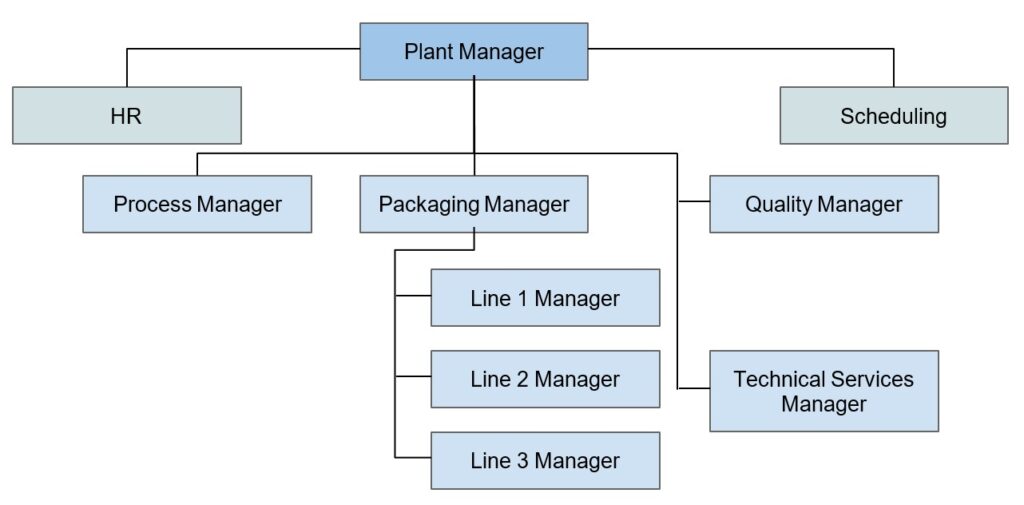
The plant manager would have middle-level managers for various areas of operations, quality and technical services managers, and then small administrative staff for human resources and scheduling. The plant manager would have full control over the profit and loss statement for operations and would report to the Chief Operating Officer (COO) of the company. The plant manager and his teams are able to successfully run the facility with the assistance of these administrative staffs.
Under this sort of organization, the Technical Services Manager is in charge of directing the execution of engineering projects. This manager would also be responsible for providing the facility with engineering professionals to support it. Within the context of any given project, the facility managers take on the role of stakeholders, with a committed member of the team serving as the project manager.
Larger firms, which typically have more than one site, employ a smaller number of technical services personnel and have a matrix-like organization that is utilized to carry out capital projects at all of their locations from a central location. This type of organization is significantly more complex and requires strong governance in order to function effectively.
In arguing down these structures, one could state that a top-down organization can stifle innovation and flexibility and point out that such systems can create bottlenecks in decision-making. In dynamic manufacturing environments, where rapid responses to market changes are crucial, a rigid hierarchy may hinder communication and slow down the implementation of new ideas. To counter this argument, one could emphasize that a clear chain of command can provide direction and ensure accountability, which may be beneficial in high-stakes situations. However, organizations can adopt hybrid models that incorporate feedback loops from lower levels, fostering innovation while retaining the structure necessary for efficient operations.
Relying too heavily on middle management in the decision-making process could also lead to a number of challenges. While middle managers may contribute valuable insights from their frontline experience, an overemphasis on their role can result in a disconnect from the overall strategic vision of the organization. This could lead to slower decision-making and a diluted implementation of strategies as messages traverse multiple layers. Moreover, if middle management is not adequately empowered to make decisions, it can create frustration among employees and diminish morale. A balanced approach that empowers individuals at various levels and fosters open communication can mitigate these risks.
When discussing the effectiveness of a matrix organization, it’s important to recognize that this structure may indeed cater better to larger firms that must navigate the complexities of multiple sites and diverse market demands. Advocates of matrix organizations argue that they promote flexibility and responsive decision-making by allowing teams to collaborate across functions. However, critics may point out that such systems can create confusion regarding authority and accountability, potentially leading to conflicts between project and functional managers. Ultimately, the effectiveness of a matrix structure depends on the organization’s culture and the people within it, as well as their ability to communicate and work collaboratively across various lines. It may also be worth considering that while matrix organizations can provide adaptability, they require strong leadership and clearly defined processes to ensure alignment and efficiency.
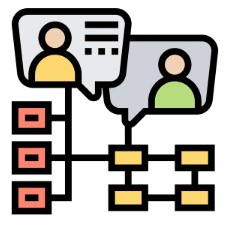
The Matrix Organization
The matrix organization is one of the different types of organizational structures that have been used in the business world for a very long time. There are two distinct sides that exist inside this organization: the side that deals with projects and the side that deals with departments. In the same manner that department managers are accountable for monitoring the day-to-day technical and administrative responsibilities of their staff members, the project side is in charge of managing the individual projects and the staff members who are working on them.
A department might have as few as three or four individuals working in it, or it might have hundreds of people working in it. It all depends on the circumstances. Due to the fact that departments will assign people to a project based on the requirements of the project, the individual assignments serve as the basis for undertaking project management.
Enterprises that are focused on providing services, such as engineering and accounting firms, are examples of the kinds of organizations that leverage this organizational structure. Manufacturing companies and service-oriented enterprises are also examples.
Is there something wrong with dual reporting relationships? Critics often highlight the potential for confusion and conflict arising from dual reporting relationships within a matrix organization. To address this concern, it’s essential to emphasize the importance of clear communication and defined roles. Establishing well-defined boundaries around responsibilities and expectations can significantly mitigate confusion. Regular check-ins and team meetings can help facilitate open dialogue, ensuring that team members understand their priorities and how they align with both project and departmental goals. Additionally, promoting a culture of collaboration and conflict resolution can empower employees to navigate the complexities of dual reporting more effectively, turning potential conflicts into opportunities for growth and innovation. The main purpose of the matrix organization is that one side of the matrix focuses on the project and project goals, while the other side focuses on the technical execution. Although this can lead to disagreements, it is an effective way to create an open platform for problem-solving.
Should simpler structures for certain projects be considered? It’s true that the matrix organization doesn’t suit every project or context. In scenarios where projects have clear, straightforward objectives and limited cross-functional dependencies, a simpler organizational structure can be more effective. For example, in smaller teams or projects with fewer complexities, a traditional hierarchical approach may enhance efficiency and clarity. It’s important to assess the specific needs and dynamics of each project, recognizing that flexibility in organizational structure can lead to more effective outcomes. By remaining open to alternative structures, organizations can tailor their approach to best fit the project’s requirements and the team’s capabilities. However, this would work best with more experienced people with deep experience with all aspects of the company.
What about those concerned about accountability in a matrix organization? Concerns regarding accountability in a matrix structure often stem from the blurred lines of responsibility that dual reporting can create. To counter these claims, it’s crucial to establish a framework for accountability that distinguishes between departmental roles and project responsibilities. This can be achieved through clear performance metrics aligned with both project and departmental objectives, allowing for better tracking of individual contributions. Regular performance reviews and feedback sessions can also reinforce accountability by ensuring that employees receive recognition and constructive feedback for their work. By creating a culture that values accountability and transparency, organizations can effectively navigate the complexities of a matrix structure while maintaining clarity in responsibility. One of the most important goals project management has is building the team with the departments; this closes most of these gaps and creates a cohesive and responsible team.
Project Management Organization
Project Managers (PM), who often report to a project management department lead or director, should be in charge of guiding project teams within project organizations. In addition to ensuring that the projects are paid for and scheduled, the project manager is responsible for ensuring that the project is carried out in line with the regulations that the organization has established. It is the responsibility of the project manager to work with departments to select members of the team who will be responsible for carrying out the technical parts of any project. Every one of the departments that are expected to be represented will be represented by these persons.
The idea that the project manager should be responsible for everything is not unheard of in the context of small firms; in fact, there are situations in which this technique is beneficial to the organization. Although other members of the company’s workers are able to concentrate on the day-to-day activities, the project manager is able to concentrate on the new project. On the other hand, this is inconceivable unless the PM is provided with assistance whenever it is requested.
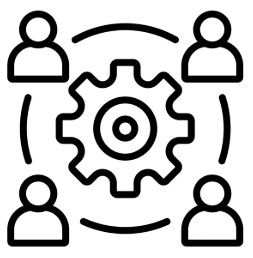
Member Empowerment
One of the factors that adds to the overall success of the project is the degree to which members of your project team and contractors feel empowered to make decisions and take action. If they believe that they are a part of the team, that they are contributing to the process, and that they are making a difference, then they will have a high level of motivation, and they will be pushed to participate in activities. Nevertheless, this can be a finicky thing that is tough to govern, even when efforts are made with the best of intentions. All of the following are some quick guide points that ought to be applied for the advantage of the project management team as well as the stakeholders.Establish Clearly Defined Objectives
The establishment of well-defined objectives is the cornerstone of any initiative that is successful. Having a comprehensive understanding of both the project goals and the larger company goals is of the utmost importance for every member of the team. Spend some time making sure that these objectives are successfully communicated to all of the individuals that are engaged, making sure that there is no space for misunderstanding or confusion. It is possible to clarify how individual responsibilities contribute to these goals through regular check-ins, which can assist reinforce the significance of these roles.
Recognize and Communicate the Vision
It is essential for the team to have a clear understanding of the project’s purpose in order to keep their motivation and level of alignment high. In your explanation, please explain how this initiative adds to the overall performance of the organization. Not only does a well-crafted vision statement serve as a guiding star, but it also serves as a source of inspiration, which helps to create a sense of belonging and motivates individuals of the team to contribute their best work. Vision statements can help eliminate personality clashes and increase the chance of innovation in the project.
Provide constructive criticism
Feedback that is both constructive and encouraging is absolutely necessary in order to cultivate a positive environment for the team. Provide feedback at crucial junctures, preferably within the context of a team activity in which cooperation is actively encouraged. Keep in mind that while it is essential to address technical aspects in order to make improvements, it is equally as crucial to recognize victories and breakthroughs during this process. Improving one’s attitude boosts morale, which in turn boosts productivity and increases job satisfaction.
Encourage the Employees
To empower members of the team, encourage them to take on hard activities that challenge their capabilities and provide them the opportunity to grow. They not only gain valuable experience as a result of this, but it also helps them feel like they have grown and achieved something positive. You should make sure that they have opportunities to work together with their coworkers, since this can result in the development of new ideas and improved solutions. Additionally, it is essential to strike a balance; in order to prevent burnout, it is important to encourage people to manage their professional responsibilities while still preserving their personal lives.
Never ask someone to do something that you would not do yourself
Integrity in leadership can be demonstrated by establishing a standard that you are willing to uphold yourself. Embracing this principle helps to foster an environment that values accountability and respect. When members of a team observe their leader participating in the same activities or challenges, it helps to cultivate trust and increases the cohesiveness of the team.
Give Benefits or Special Privileges to Employees Who Put in Extra Effort
The most effective method for motivating members of a team is to acknowledge and recognize those who have worked hard. Demonstrating appreciation for their work, whether it be through the provision of minor perks, recognition programs, or real benefits, conveys the message that their contributions are valued. A boost in morale and an increase in loyalty to the organization can result from this.
Request Your Opinions
Participation is necessary for a dynamic that is successful inside a team. Ensure that it is a routine practice to ask for feedback from every single member of the team. Establish a setting in which everyone is at ease expressing their opinions, and in addition, make sure that you take their feedback seriously. By showing appreciation for their contributions, you foster open communication and a commitment to ongoing progress.
By setting an example
Try to imagine how you would like to be led, and then try to model your behavior after that. When leadership is proactive and supportive, it is capable of producing the greatest results. Building trust with your team and encouraging them to follow your lead can be accomplished by being present and available to them. In order to establish the framework for success while also encouraging others to take ownership of their tasks, it is important to lead from a position of strength.
Facilitate Collaboration
Create meeting schedules that are flexible enough to accommodate all members of the team in order to foster an atmosphere that encourages collaboration. Make it a top priority to make sure that everyone has the chance to express their thoughts and participate in the conversations that are taking place. In order to foster a sense of belonging and validate the contributions of every member of the team, you should actively track and address the points that have been brought up. This will result in more creative ideas and a culture that is cohesive within the team. It is possible to establish an environment that is productive and harmonious inside the team by putting these methods into action. This environment will drive success and nurture personal and professional development for all members of the team.
Team Communications
The team that is in charge of managing the project is responsible for a number of vital duties, one of the most crucial of which is communications. Everything from informing persons about the particulars of the project and the vision for it to alerting them of the dates when particular items are necessary and should be accomplished is included in this category. It is possible that omitting the personal touch can be highly detrimental to the team and the effectiveness that the project management team is attempting to manage. This is despite the fact that some businesses make an effort to formalize these conversations by utilizing formal communication or team software solutions such as Monday.com or Trello.
When it comes to establishing communication points for your project team on a weekly or monthly basis, the most efficient technique is to hold meetings of the team. By participating in these sessions, the members are able to speak with one another, bring up any issues or concerns that they may have, measure the real progress that has been made, monitor the cohesiveness of the team, and create a relationship with the other members of the team. In addition, it provides the most efficient opportunity for member employment within the context of a team atmosphere, which has the potential to be contagious.
What is the effectiveness of formal communication tools? While formal communication tools, such as emails and project management software, can be effective in conveying information and delegating tasks, they often lack the personal touch that frequent meetings provide. Meetings facilitate real-time dialogue, allowing team members to clarify misunderstandings and foster relationships in a way that written communication may not achieve. Moreover, meetings can serve as a platform for brainstorming and collaborative problem-solving, which can enhance creativity and team cohesion. Therefore, while formal tools are valuable, they should complement, rather than replace, regular team interactions. Remember, the value of the output of any formal system is the summation of the value of the inputs, and the inputs might need to be several times more voluminous to achieve a good output.
Should we be concerned about overwhelming team members? It’s an important point to recognize that some team members may feel overwhelmed by an excess of meetings. Too many scheduled discussions can lead to meeting fatigue, potentially hindering productivity and team morale. To address this concern, it’s crucial to strike a balance—ensuring that meetings are purposeful, concise, and necessary. Implementing practices like setting clear agendas, limiting the number of meetings, or utilizing asynchronous communication for certain updates may help alleviate feelings of being overwhelmed, allowing team members to feel more engaged and productive. Most importantly, meetings achieve results by removing doubt, reducing a member’s information vacuum, and working with a team, which is another form of a team-building exercise.
With remote work so pervasive today, how does in-person interaction work? Critics may argue that relying too heavily on in-person interactions in a remote work environment could lead to misunderstandings and miscommunication, as nuances in tone and body language can be lost. However, the value of face-to-face communication—whether in person or through video conferencing—should not be underestimated. These interactions can enhance relationship-building and foster trust amongst team members, which is crucial for effective collaboration. To mitigate the risk of miscommunication, teams can establish clear communication protocols, encourage feedback, and incorporate tools that promote transparency and understanding. By combining both in-person and digital communication strategies, teams can create a more cohesive work environment while minimizing the risks of miscommunication.
The Life of a Team
Lastly, a group that is solely focused on a single topic or a collection of initiatives has its own distinct existence. It is possible that the team will initially consist of a member who has performed some front-end work in order to build a concept or discover an opportunity earlier. It’s possible that this individual has a very strong understanding of the problem-solution dilemma, but they lack the technical abilities necessary to carry out the activity to its maximum potential. Once a project manager has been assigned the responsibility of developing a business case for the project, the team will expand as required.
In the event that the project is carried out, even if just through the initial stages, the team can have members who are permanent and/or who are temporary. It is possible that the team will grow into a large group that is capable of meeting all of the necessary technical requirements during the phases of design and construction. It is typical for these members of the team to remain active until the later phases of commissioning are completed, after which they shift their attention to other important projects. The project manager and key individuals would then stay active until all the stakeholders and operations were satisfied.

Case Study 2 – Project Team
During a large capital expansion project, new buildings, equipment, and automation were required. Downstream processes were also largely impacted by the addition of the expansion and new line. In fact, this new project was so large that its intrusivity for ongoing daily operations was very extreme and sensitive.
 Anhusier Busch (AB) executed a project that must maintain production while a new brew line was created in parallel to one of its existing brew lines. The new brew line then sent brews to an existing fermentation cellar. On top of all this new production, the automation platform was being upgraded in both the brew line and fermentation process cells. Leveraging AB’s stellar engineering group, the multi-year project was able to be designed, built, and new production added without interruption to the existing production.
Anhusier Busch (AB) executed a project that must maintain production while a new brew line was created in parallel to one of its existing brew lines. The new brew line then sent brews to an existing fermentation cellar. On top of all this new production, the automation platform was being upgraded in both the brew line and fermentation process cells. Leveraging AB’s stellar engineering group, the multi-year project was able to be designed, built, and new production added without interruption to the existing production.
AB’s world-class engineering team had strong project management and stakeholder input along with technical execution from its process, mechanical, and electrical engineering teams. All necessary support teams for IT, quality, brewing technology, and outside contractors made for seamless enterprise. In fact, the project management team was complimented by local project team members and construction managers.

Exercise 2 – Object Pass
Group Size: Entire group

Course Manual 3: Defining Metrics
The definition or specification of metrics can be done in a variety of different methods and for a variety of different reasons. In order to identify whether or not something is valid, one set of metrics is used to establish how a process is measured, while another set of metrics is utilized to determine eligibility. Within the framework of this workshop, we will discuss the many sorts of metrics that are required moving forward in order to go forward. It should be evident that these measurements have an impact on business operations, industrial processes, or software components. Furthermore, they should be the driving force behind how your project management team will continue to operate in the future.
Product Metrics
The implementation of key performance indicators (KPI) is going to take place for new products, processes, or solutions. These key performance indicators will demonstrate that your product is operating effectively and providing some advantage to customers. These key performance indicators (KPIs) can be numerous, the information can be made public or kept confidential, or they can be summed up by just one or two measurements. All of these options are possible. The key performance indicators (KPIs) should be the major emphasis of each and every project, and the business case should include a comprehensive summary of these KPIs.
 For instance, the percentage of the product that is produced by your production line is an illustration of this concept. In the majority of instances, the term “yield” encompasses the quantity of a product that is capable of being sold as a consequence of the production process. When the yield is lower than what is desired, it is possible to carry out a project in order to raise the value of the asset. Due to the fact that this yield percentage would have an impact on the financial records of your organization, any improvement would be of interest to the stakeholders that are located within the corporation. One of the more meaningful indicators for many organizations is yield, which is a leading, not lagging, indication since it can be easily monitored at the time of production.
For instance, the percentage of the product that is produced by your production line is an illustration of this concept. In the majority of instances, the term “yield” encompasses the quantity of a product that is capable of being sold as a consequence of the production process. When the yield is lower than what is desired, it is possible to carry out a project in order to raise the value of the asset. Due to the fact that this yield percentage would have an impact on the financial records of your organization, any improvement would be of interest to the stakeholders that are located within the corporation. One of the more meaningful indicators for many organizations is yield, which is a leading, not lagging, indication since it can be easily monitored at the time of production.
Instruments and sensors are utilized in the bulk of the processes that are carried out in industrial settings. These instruments provide the control system and the operator with indicators and Process Values (PVs) of the system that is currently functioning during the operation of the system. Through the utilization of these PVs, the control system is able to read and then supply the relevant control functions in order to maintain the process within the engineering restrictions that have been specified. On the other hand, it is likely that same PVs do not provide the values that are necessary for the business unit to evaluate success. This is something that should be considered. An excellent instance of this idea is the manufacture of chocolate through the use of a batch method. Toasting, grinding, mixing, heating, and cooling are some of the activities that are typically involved in this system. In addition, all of the components are measured and combined together. Once it is complete, the mixture is moved on to the subsequent step, which is the packaging procedure. Despite the fact that the mix system would feature PVs for ingredients, weights, temperature, and other essential information, it would not have an instrument to measure how completely the sugar went into solution, which would have an impact on the smoothness and texture of the final output. In the majority of instances, a step is necessary in order to return a sample to a laboratory for additional analysis before the product is made available for sale. This is done in order to ensure that nothing is missed. This particular measurement is a key performance indicator (KPI) that is of great significance, and it is monitored in the batch data.
 Percent yield is only one factor in the complex world of customer satisfaction. Yield can be an important measure of efficiency, but it might not capture the full picture. For instance, a high yield could be achieved by compromising on certain quality aspects, which could ultimately affect customer satisfaction and loyalty. It’s essential to incorporate a balanced set of KPIs that include metrics for quality, customer feedback, and market trends. By doing so, we create a more holistic approach to evaluating product performance that aligns with customer expectations and fosters sustainable success.
Percent yield is only one factor in the complex world of customer satisfaction. Yield can be an important measure of efficiency, but it might not capture the full picture. For instance, a high yield could be achieved by compromising on certain quality aspects, which could ultimately affect customer satisfaction and loyalty. It’s essential to incorporate a balanced set of KPIs that include metrics for quality, customer feedback, and market trends. By doing so, we create a more holistic approach to evaluating product performance that aligns with customer expectations and fosters sustainable success.
Stakeholders not agreeing on which KPIs are most relevant is a valid concern as well. Different departments or individuals might prioritize various goals based on their perspectives and responsibilities. For example, while the finance team might focus on cost-related KPIs, the marketing team might emphasize customer engagement metrics. It’s crucial to engage in collaborative discussions to ensure that all voices are heard, and to arrive at a consensus that aligns with the overall strategic goals of the organization. This could lead to the development of a comprehensive KPI framework that incorporates diverse viewpoints and reflects the multifaceted nature of success.
In response to someone who believes that a focus on KPIs could produce a narrow view of success, let us highlight the importance of maintaining a balance between quantitative metrics and qualitative insights. While KPIs can provide valuable data-driven insights, they should not be the sole determinant of success. Broader strategic goals and long-term vision are critical to ensuring a sustainable path forward. Organizations should strive to embrace a more integrated approach where KPIs are a part of a broader strategy that includes innovation, employee engagement, and community impact. By combining analytical data with qualitative assessments, companies can create a richer understanding of success that aligns with their long-term objectives.
One further example of a key performance indicator (KPI) is the percentage of customers who continue to use a product or service. These indicators garner a considerable lot of attention because of the significance of retention for organizations that deliver professional services like accounting or legal services. It is possible to create a project that would once again have an effect on the financial statements of the firm in order to achieve the goal of increasing the proportion of clients who continue to buy your products. Considering that the retention rate is not originally realized, this signal would be considered to be lagging.
As an example, the percentage of loyal consumers that a firm maintains over a specified amount of time is referred to as the customer retention rate. As an illustration, if your company begins the year with ten customers and then loses two of them, then your retention rate is eighty percent on average.
First things first: in order to assess client retention, you will need to determine the exact time frame that you want to focus on measuring. Each year, every three months, every month, or every week, some businesses do employee retention assessments. This data may even be viewed on a daily basis by software as a service (SaaS) organizations that operate in a fast-paced environment and have user bases that experience significant and rapid fluctuations.
Immediately after you have settled on a particular time period, you will be required to collect the following information:
● At the conclusion of a specified time period, the total number of consumers (Ce)
● Over the course of the time period, the total number of new clients (Cn)
● The total number of subscribers at the beginning of a certain time period (Cs).
Following the completion of this information gathering process, you will be able to calculate your customer retention rate by entering your figures into the formula for client retention:
Customer retention rate = [(Ce-Cn)÷Cs] x 100
Performance Metrics
The contractual points that describe how well a piece of hardware or software component should function in order to fulfill the specifications of the contract are generally included in performance metrics. The nature of performance metrics is analogous to that of product metrics; however, performance metrics typically involve a contract. The contractor and the stakeholders are held together by these measures, which are incorporated into the contract. They serve as the adhesive that keeps everything together.
It is possible that performance metrics will be an essential component of the larger solution, or they may be a component statistic that is directly related to the objectives that are special to the project. When it comes to a palletizer, which is used to place finished products on pallets for the purpose of storage and shipment, the speed of the unit helps the entire line produce the right quantity of goods in a single day when the project is running. This is because the palletizer is used to place finished items, a measurable variable or KPI, on pallets, completing the manufacturing cycle. Within the context of this case, the contractor is just accountable for the metric speed of the unit rather than being responsible for the complete line.
Does performance metrics incentivize contractors to prioritize short-term results over long-term quality or sustainability? Possibly, so it’s crucial to examine the implications of the metrics used to evaluate performance. While quantifiable metrics like speed and cost savings can drive immediate efficiencies, they may inadvertently encourage practices that sacrifice quality or fail to consider sustainable methods. For example, if contractors are solely rewarded based on speed, they may cut corners in material selection or neglect maintenance protocols. Thus, establishing a more comprehensive set of performance metrics that includes long-term quality, environmental impact, and maintenance can incentivize a more balanced approach. Open discussions about these metrics can help align incentives towards sustainable solutions that benefit both contractors and the project’s overall success.
Regarding the concern that defining performance metrics too narrowly could limit innovation or flexibility in adapting to changing project requirements, it’s important to recognize that rigid metrics can indeed stifle creativity. When performance indicators are too specific, they may discourage teams from pursuing novel solutions or finding more effective processes that fall outside the established criteria. This limitation can be particularly problematic in rapidly evolving industries where adaptability is critical to responding to market demands. Instead, a more dynamic approach to performance metrics—one that allows for adjustments and encourages teams to explore new methodologies—can foster innovation and continuous improvement. By creating a culture that values flexibility and ingenuity, organizations can better position themselves to adapt to new challenges and seize opportunities as they arise.
Project Gate Metrics
When it comes to your engineering project, it is essential that these metrics make it abundantly clear what comprises a stage that has been completed. When it comes to the review process of what was taking place at that time, the metric should first and foremost make it abundantly clear what design level the project is currently at its current stage. These are some common levels, but they could be very different from one another depending on the product or industry. The following are some examples of normal levels.

It might be interesting to find out that a ‘Detailed Design’ stage might not be 98-100% complete. The engagement of teams from a variety of fields, including architectural, process, electrical, and software, is often required for projects that are of a larger scale. Although the structural elements, such as civils, building layouts, and primary equipment designs, are necessary for the commencement of the building process, the soft aspects, such as the building management or automation sections, may be behind schedule. This is because the structural features are crucial to the beginning of the building process. However, these sequencing delays are something that is intended to take place and are an important component.
Can the reliance on stage completion metrics overshadow the importance of flexibility and adaptability in project design? Relying heavily on stage completion metrics can indeed create a narrow focus that prioritizes meeting specific deadlines or milestones over the quality and adaptability of the project. While these metrics provide tangible indicators of progress, they may not fully capture the dynamic nature of engineering design, where unexpected challenges and opportunities often arise. To counter this, it’s important to cultivate a project culture that values iterative processes, encouraging teams to remain flexible in their approaches. Integrating qualitative assessments, such as team feedback and stakeholder engagement, alongside quantitative metrics can help maintain a balance, ensuring that the project remains responsive to changing circumstances and innovative ideas.
It is possible that the chronological advancement through the design stages does not adequately reflect the overall success or viability of the project in some circumstances. In many situations, a rigid adherence to a linear development through design stages may mask the true signs of a project’s success. This is because there are many different combinations of circumstances. As an illustration, a project might make it through all of its defined stages on schedule, yet, despite this, it might not be able to satisfy the requirements of the stakeholders or demonstrate success in the market. Since this is the case, it is necessary to take a more comprehensive approach to evaluate the progress of the project. This approach should include feedback loops and possibilities to revisit and improve earlier stages depending on new insights or developments in the market. Through the implementation of a project management approach that is more fluid and places a higher priority on outcomes rather than checklists, teams are able to better align their work with the larger goals and requirements of the project, which ultimately results in increased overall viability and success.
More Metrics
There are additional metrics that may be assessed and tracked over the course of projects, and these metrics have the ability to provide the team in charge of project management with benefits that are not only large but also impactful. These can be found in a number of different formats, and they are typically really accurate with regard to the proprietors and the sector in which they are active. When it comes to controlling details, boosting the possibility of success, and considerably improving the overall quality of the project, the utilization of action item lists is an outstanding strategy that may be utilized. In addition to providing information on the person or people who brought up the issue, action items also include a description of the problem, an identification number, and any significant dates that are relevant to the situation. In addition to this, it provides ownership of the department or department that is accountable for the resolution of the issue, which is an important component.
These action item lists can be discussed in very finite details, offering a lot of context to the specific problem while also providing rich design narrative for the team. The entire list can be evaluated to help determine the completeness level of the project as well as give stakeholders more comfort that details are not being lost. This improves the overall effectiveness of the team, giving the team focus points to manage, reducing parochialism and hyperbolism.
There is also a list of software issues that are associated with the project, which is another example of relevant project metrics. The generation of a bug list is the responsibility of testing agents, and the list can be different based on the company and the kind of solution being used. During the process of testing the numerous components, interfaces, linkages, and functions of the program, these agents, who normally serve as a separate team from the development team, write bug reports on the software. These reports are then used to resolve any issues that have been discovered. It is possible that these lists will see exponential growth in the early phases of the development and testing cycle; but, once the developers have completed their work and caught up on the modifications, the lists will start to decline. It is a fact that the software development team is functioning appropriately when it reaches the tipping point at which the number of open problems begins to drop. This is one indication that the team is functioning appropriately.
Are there concerns that relying too heavily on action item lists may overlook the importance of interpersonal communication and collaboration within the team? While action item lists can help in organizing tasks and creating accountability, it’s essential to balance this structure with opportunities for open dialogue. Encouraging regular check-ins or team brainstorming sessions can foster interpersonal connections and collaboration. Moreover, using action items as a tool rather than a crutch can empower team members to communicate their progress and challenges, ensuring that collaboration remains at the forefront of our efforts. In essence, while lists are beneficial for clarity, the value of face-to-face interactions and collective problem-solving should never be underestimated.
What about critics who argue that focusing on metrics like bug lists could lead to a culture of blame instead of fostering a more supportive environment for problem-solving? It’s a valid concern that an overemphasis on metrics can create pressure, leading to a blame culture where team members may feel scrutinized rather than supported. To counter this, it’s crucial to frame metrics as tools for improvement rather than judgment. Encouraging a mindset shift where bugs are viewed as opportunities for learning can create a more positive environment. Additionally, reinforcing that accountability comes with a supportive structure—where team members can discuss issues openly without fear of retribution—can help maintain morale and promote a cooperative spirit focused on innovative problem-solving.
What about variations of action item lists that vary significantly based on the specific team dynamics and project types? Absolutely, the effectiveness of action item lists can indeed fluctuate depending on various factors such as team dynamics, individual personalities, and the nature of the projects. For instance, in a highly collaborative environment, rigid action item lists may stifle creativity or flexibility, while in a more structured setting, they could provide necessary clarity. It’s important to assess the needs of the team and the project at hand, adapting the use of action items accordingly. Seeking feedback from the team members on how these lists are functioning can also lead to optimizations that enhance both productivity and job satisfaction. By tailoring our approach, we can better support the unique context of each team.
In subsequent sessions, we will delve into specific types of deliverables and study their characteristics, as well as the ways in which they contribute to the overall completion rate. Specifically, we will focus on the components that make up the deliverables. In addition, despite the fact that the completion number is mostly a matter of opinion, stakeholders ought to be prepared for the reality that different deliverables will vary at each stage. As a result, it is of great assistance to incorporate this knowledge into the standards that you have established for project management.

Case Study 3 – Defining Metrics
A famous distillery’s new facility was making some great whiskey; however, its wastewater plant needed some improvements to support the continuous production. They also wanted to start production on a new type of product that would affect the operation of the wastewater facility. A project was undertaken to identify the work required to allow the facility to grow and meet production.
 To develop a complete functional concept, a key study had to determine how to remove additional solids from the waste stream. This effort took some months to outline, consult and even test in the lab prior to sealing the concept. This led to a ‘tea’ concept that was used to discuss, measure, and monitor the process changes. The data from the tests and consultations helped build the business case, process model, size equipment, and provide a solid cost for the next steps.
To develop a complete functional concept, a key study had to determine how to remove additional solids from the waste stream. This effort took some months to outline, consult and even test in the lab prior to sealing the concept. This led to a ‘tea’ concept that was used to discuss, measure, and monitor the process changes. The data from the tests and consultations helped build the business case, process model, size equipment, and provide a solid cost for the next steps.
Once the new process equipment was in place, the resulting waste stream saw immediate improvements and provided a tea-like liquid stream for downstream processes, all matching the goals of the next phases of the facility. No cost overruns or equipment adjustments were required, and the chemical products specified and verified by the lab tests continued to perform.

Exercise 3 – Fashion Show
Group Size: Entire group

Course Manual 4: Basic Design
The subsequent stage of the project, which is referred to as the Basic Design, is something that the project team is able to carry out once the project has been launched and the stakeholders have supplied financial support. This particular stage is significant for a variety of fundamental reasons, which are listed below. In the first place, the stage has to be able to incorporate all of the essential disciplines and generate a fundamental collection of designs for each of them. Second, once the designs have been finalized to a large extent, it is required to do a thorough cost analysis of the design. This is a must. In light of the fact that all of the major components have been recognized, dimensional layouts have been calculated, and so on, this cost needs to be more detailed than the one that was initially provided.
 Basic layouts of a warehouse, three-dimensional models of important components, pseudocode or human-machine interface (HMI) screens, and a bill-of-material (BOM) of all major parts with critical quotations from vendors and suppliers are some examples of the deliverables that may be included. It is possible for these deliverables to differ quite a bit depending on the kind of project that is being carried out. In the context of a fundamental design, these components need to be defined in a manner that is sufficient to support the foundation of the project.
Basic layouts of a warehouse, three-dimensional models of important components, pseudocode or human-machine interface (HMI) screens, and a bill-of-material (BOM) of all major parts with critical quotations from vendors and suppliers are some examples of the deliverables that may be included. It is possible for these deliverables to differ quite a bit depending on the kind of project that is being carried out. In the context of a fundamental design, these components need to be defined in a manner that is sufficient to support the foundation of the project.
Modeling
Over the past few years, there has been a significant advancement in the modeling technologies that engineers and professionals utilize. Through the process of setting up and running mathematical models and simulations, it is possible to test the limitations and operational parameters that are specified. In addition, it is possible to construct 3D models of robots and production spaces in order to check their functionality and suitability. It is possible to use software tools to perform automatic software testing, and these tools can even produce code based on previously tested sections of code.
Wikipedia states there are three popular ways to represent a model:
Polygonal modeling – Points in 3D space, called vertices, are connected by line segments to form a polygon mesh. The vast majority of 3D models today are built as textured polygonal models because they are flexible and because computers can render them so quickly. However, polygons are planar and can only approximate curved surfaces using many polygons.
Curve modeling – Surfaces are defined by curves, which are influenced by weighted control points. The curve follows (but does not necessarily interpolate) the points. Increasing the weight for a point pulls the curve closer to that point. Curve types include nonuniform rational B-spline (NURBS), splines, patches, and geometric primitives.
Digital sculpting – There are three types of digital sculpting: Displacement, which is the most widely used among applications at this moment, uses a dense model (often generated by subdivision surfaces of a polygon control mesh) and stores new locations for the vertex positions through use of an image map that stores the adjusted locations. Volumetric, loosely based on voxels, has similar capabilities as displacement but does not suffer from polygon stretching when there are not enough polygons in a region to achieve a deformation. Dynamic tessellation, which is similar to voxel, divides the surface using triangulation to maintain a smooth surface and allow finer details. These methods allow for artistic exploration as the model has new topology created over it once the models form and possibly details have been sculpted. The new mesh usually has the original high-resolution mesh information transferred into displacement data or normal map data if it is for a game engine.
The modeling stage consists of shaping individual objects that are later used in the scene. There are a number of modeling techniques, including:
● Constructive solid geometry
● Implicit surfaces
● Subdivision surfaces
Modeling can be performed by means of a dedicated program (e.g., 3D modeling software like Adobe Substance, Blender, Cinema 4D, LightWave, Maya, Modo, 3ds Max, uMake, SketchUp, Rhinoceros 3D, and others) or an application component (Shaper, Lofter in 3ds Max) or some scene description language (as in POV-Ray). In some cases, there is no strict distinction between these phases; in such cases, modeling is just part of the scene creation process (this is the case, for example, with Caligari trueSpace and Realsoft 3D).
3D models can also be created using the technique of Photogrammetry with dedicated programs such as RealityCapture, Metashape and 3DF Zephyr. Cleanup and further processing can be performed with applications such as MeshLab, the GigaMesh Software Framework, netfabb or MeshMixer. Photogrammetry creates models using algorithms to interpret the shape and texture of real-world objects and environments based on photographs taken from many angles of the subject.
Complex materials such as blowing sand, clouds, and liquid sprays are modeled with particle systems, and are a mass of 3D coordinates which have either points, polygons, texture splats or sprites assigned to them.
(process of developing a mathematical representation of any three-dimensional surface of object via specialized software. Wikipedia.org. Published June 29, 2004. Accessed March 29, 2025. Link )

Software Modeling
In the discipline of software engineering, one of the most important aspects of software modeling is the process of developing abstract representations of software systems. In order to facilitate analysis, design, and communication, representations are utilized. This ultimately results in an improvement in the development process, which ultimately leads to a better software product. Therefore, software modeling is a specialized term that refers to the process of generating abstract representations of a software system. These representations are frequently referred to as models on occasion. It is possible for these models to include diagrams, charts, or other visual representations that capture significant aspects of the software, such as its structure, behavior, and functionality.
As a result of this, analysis and design are simplified, which underscores the significance of this aspect. With the support of models, developers and designers are able to have a better understanding of the complexity of the system, identify potential problems at an earlier stage, and make decisions on the architecture and implementation of the system that are more informed. Furthermore, models serve as a common language that can be utilized to explain complex ideas and requirements to a wide range of stakeholders, including customers, designers, testers, and developers. This makes models an effective tool for facilitating communication.
The planning of the software development process, the estimation of costs and timelines, and the monitoring of progress are all things that may be achieved with the assistance of models, which improve the planning and management processes. Models can also be applied when it comes to the process of establishing test cases and ensuring that the program fits the standards that have been established.
Software process models include the Waterfall model, the Agile model, and the Spiral model. Each of these models provides an outline of the stages and activities that are involved in the software development lifecycle. Design models such as class diagrams, use case diagrams, and sequence diagrams are examples of the types of models that concentrate on the structure and architecture of the digital program.
Data models provide a representation of the data structures and interactions that exist within the software system is provided by these models. Behavior models, which include state diagrams and activity diagrams, concentrate on the actions and interactions that take place within the software management system.
It is possible to reduce the amount of time and money spent on software development by taking advantage of the benefits that software modeling offers. In order to achieve development that is both more rapid and more successful, it is possible to diagnose and resolve problems at an earlier stage. It is possible to generate software of a higher quality as a consequence of enhanced processes, which may be accomplished by achieving a better understanding of the system and doing a more thorough examination of it. In order to achieve better maintainability, it is possible to make use of models that are well-designed and documented. This, in turn, makes it simpler to maintain and grow the software over the course of time.
Examples of Software Modeling Tools include: IcePanel is a web-based SaaS tool for collaboratively modelling software architectures using the C4 model. Enterprise Architect by Sparx Systems is a desktop application for modelling business, IT and software systems. Archi is a desktop application for modelling for creating ArchiMate models and sketches. Archipeg is a cloud-based modelling and diagramming tool for cross-functional teams. Finally, Aplas is a web-based tool for modelling your software landscape and visualizing it in 3D.
User Requirements Specification
A URS, which is an abbreviation that stands for a User Requirements Specification, is one of the components that is believed to be among the most crucial at this stage. The importance of this document cannot be overstated when it comes to the collection of all of the user requirements, functionality, and quality points of the project. Understanding that the users in this context include all of the stakeholders that stand to gain, are required to function, or are accountable for the profit and loss associated with the final product is of the utmost importance. This is something that must be understood. Consequently, this document ought to go through a system in which each department adds in their desires and wishes in order for the project management team to be able to capture sufficient information for the project to be performed successfully.
The URS will act as the requirements for the project once the needs for the entire project have been agreed upon and approved by the stakeholders. As a result of the fact that the URS serves as the primary motivating factor behind all other specifications and details, it becomes the single most important document for your stakeholders to communicate to the project team what they anticipate the project to be like.
Is a URS adding to the bureaucracy and creating decision-making delays? It is important to emphasize the potential benefits of having a structured approach. While it may seem that formalizing requirements could create additional steps, a well-defined URS can actually streamline the process by clarifying expectations from the beginning. By ensuring that all stakeholders have a shared understanding of the project goals and requirements, the URS can reduce misunderstandings and miscommunications later on, ultimately speeding up the decision-making process. It’s also crucial to establish a balance between thorough documentation and agile methodologies, which can promote efficiency while still keeping stakeholders engaged and informed.

Conflicting requirements among stakeholders is a common challenge, and it’s essential to recognize this possibility when developing the URS. One way to address these potential conflicts is through early and ongoing stakeholder engagement. Conducting workshops or focus groups can help surface differing perspectives, allowing stakeholders to discuss their needs openly. Additionally, a transparent prioritization process can be established within the URS framework, where essential requirements are identified, and trade-offs are discussed. By encouraging collaboration and negotiation, it becomes possible to reach a consensus that acknowledges the various desires while still aligning with the overall project objectives.
Worries that adherence to the URS might limit flexibility to adapt to unforeseen changes are a real concern. One effective way to maintain flexibility is to incorporate a change management process within the URS. This process should outline how adjustments to the requirements will be handled, ensuring that stakeholders can adapt to new information or changes in the environment without derailing the project. Additionally, implementing iterative development practices can allow for regular reassessment of requirements, enabling the team to remain responsive to changing circumstances. By treating the URS as a living document, teams can uphold necessary guidelines while still allowing for adaptability throughout the project lifecycle. It’s important to communicate that the URS is a tool to facilitate clarity and direction rather than a strict constraint, ensuring that teams can be both disciplined and flexible in their approach.
The ultimate conclusion is that even while an early version of the URS might be developed during the conceptual phase, the document, which includes all of the necessary technical specifications, critical attributes, interface elements, and quality metrics, would not be sufficient for a finished document. During the basic phase, this document should be given priority as an essential component, and the basis for the project should be established. This will ensure that the project is finished with the maximum thoroughness.
In addition to the URS, the design ought to incorporate all of the fundamental information that is relevant to the entire project, which includes the following:
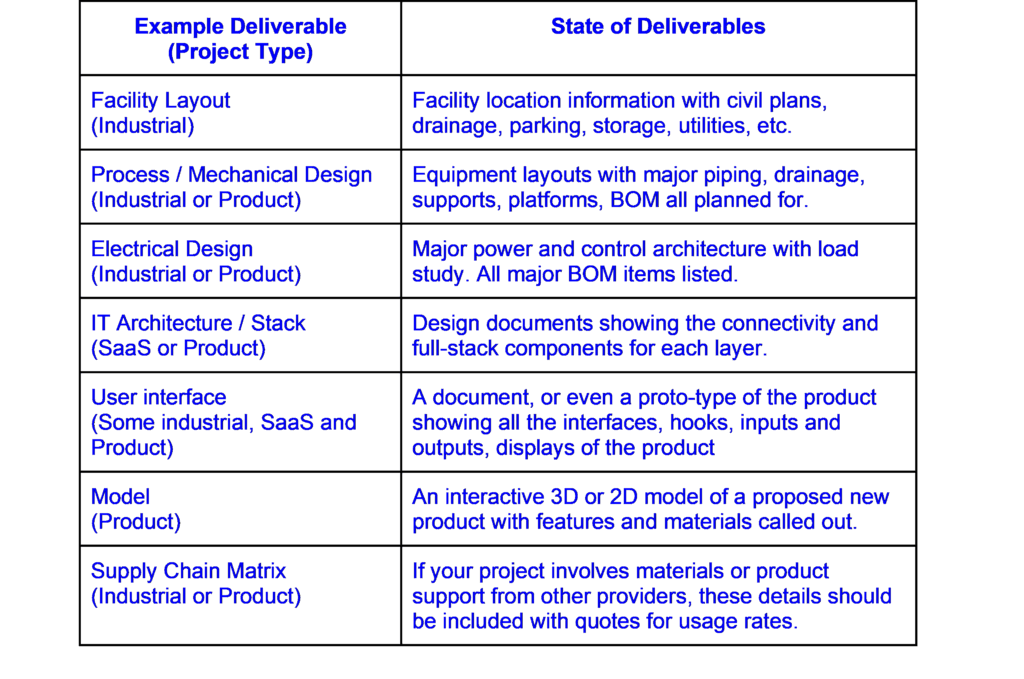
An additional essential function that ought to be the focal point of this stage is the establishment of all of the standards and protocols that your project will need to rely on. Despite the fact that it is of the utmost importance to unearth as much information as possible, there is a possibility that part of this information will not be evident until a later time. While we are still in this preliminary phase, it is crucial for department managers to carry out this important responsibility.
To what extent do the standards that your business has developed satisfy all of the essential requirements that must be met in order for the project to be successfully completed? In the event that this is not the case, then it is necessary to make an effort in order to come up with a solution, and the results of this effort should be incorporated into the project’s timeframe as well as its budget.
Technical standard
A formal document that specifies standardized engineering or technical criteria, methods, processes, and practices is known as a technical standard. This document seeks to ensure that different technical systems are consistent with one another and compatible with one another. When it comes to technical systems, technical standards are predetermined norms or requirements that have been created. They are frequently utilized to guarantee that the resources, products, processes, and services in question are suitable for the purpose for which they were designed. They are also able to provide engineers and technicians with a standard language and framework, which helps to promote interoperability and facilitates communication and collaboration.
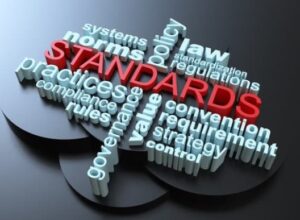 Various Sorts of Standards:
Various Sorts of Standards:
● Public: Accessible to anyone, like international standards.
● Private: Documents that are considered private are those that are exclusively accessible to members of an organization.
● Controller: Documents that are held under control include information that is classified.
Technical standards can encompass various areas, including:
● Product Specifications: These outline the characteristics and requirements of a product.
● Interface Standards: These define how different components interact and communicate with each other.
● Test Methods: These establish procedures for evaluating the performance and quality of products or processes.
● Safety Regulations: These ensure the safe operation of equipment or systems to protect users and the environment.
The use of technical standards helps to ensure that various systems and components are compatible with one another. Through the establishment of unambiguous requirements, standards contribute to the production of products and services of a higher quality. It is possible for standards to establish a fair playing field for innovation, which enables businesses to concentrate on the development of new technologies rather than on the process of reinventing the wheel. Safety requirements are frequently included in standards, which contribute to the protection of both individuals and property.
Last but not least, the development of technical standards often takes place through an accredited consensus-based process that brings together experts and stakeholders from a variety of industries. Although project-specific standards do come up once in a while, standards are usually developed outside the project stage-gate cycle.
Protocols
Within the realm of technology, a protocol is a standardized collection of rules or procedures that regulate the manner in which data is delivered and received. This ensures that devices are able to communicate in an efficient and accurate manner. When computers and other devices communicate with one another over a network, they use protocols, which are similar to a common language. These protocols enable the devices to comprehend and interpret the messages sent by one another. The manner in which data is structured, sent, and received is defined by them. This includes data flow control, error checking, and addressing, among other important elements.
HTTP, which is used for web browsing, TCP/IP, which is used for internet communication, and SMTP, which is used for email, are all examples of common protocols. It does not matter whether the underlying hardware or software is software or hardware; protocols are necessary in order to enable the movement of data across networks in a reliable and efficient manner. You might think of it as a set of rules for a game, in which every player (device) is aware of how to transmit and receive “moves” (data) in accordance with the rules.

Project Budgets
Project failure due to being over budget usually stems from this stage or due to the inadvertence of this stage. Given the circumstances, it is of the utmost significance that the entire project be represented, not just a portion of it or another project. It is essential to give careful thought to the following: processes that occur upstream and downstream, new or expanded utility requirements, activities that are related to information technology or soft technology, and new departmental impacts.
When the stakeholders reach the review of this stage, they will have the opportunity to evaluate the project once more and receive confirmation that the questions they have been asking in the stage before this one have been answered in a manner that is satisfactory to them. In addition to this, it provides the stakeholders with the ability to alter their course of action in the event that it becomes necessary to switch direction.
It is recommended that the costing be more rigorous at this stage of the process, with a focus placed on using accurate data. In addition, it is possible to get in touch with suppliers and contractors in order to obtain basic budget figure quotes that will be of use in supporting the prices. Utilizing your contractors and vendors in this manner is extremely advantageous since they may provide your team with critical information and alerts that they should keep an eye out for while the project is being carried out. This is something that your team should keep an eye out for.
Prioritizing of costs over qualitative factors requires a balanced perspective. It’s essential to acknowledge that while cost management is critical, it should not overshadow other vital elements such as team dynamics, stakeholder engagement, or project alignment with organizational goals. A holistic approach can be advantageous; budgeting can be complemented by qualitative assessments to gauge project feasibility and success. By integrating cost considerations with qualitative metrics, such as risk management and stakeholder satisfaction, project managers can create a more comprehensive evaluation framework that supports informed decision-making without sacrificing broader project objectives.
Stakeholders concerned about potential bias in budget figures from suppliers and contractors bring up valid concerns. There is an inherent risk in relying solely on external sources for financial estimates. To mitigate this risk, it’s crucial to establish a robust verification process, which may include benchmarking against industry standards, conducting independent assessments, and fostering transparent communication with all parties involved. This way, stakeholders can feel reassured that the budget reflects an accurate, unbiased representation of project costs, allowing for more reliable financial planning and resource allocation.
The perspective that some stakeholders might favor a simplified review process over a comprehensive analysis is worth considering, as it can influence project outcomes. While a streamlined approach may save time and resources, it risks overlooking critical details that could impact project success. It’s essential to communicate the importance of thorough analysis—highlighting how in-depth evaluations can uncover potential issues early on, leading to better-informed decisions and long-term benefits. To bridge the gap between preferences for simplicity and the need for depth, a hybrid approach could be developed, integrating key performance indicators into a more straightforward framework, thus ensuring that essential factors are still addressed without overwhelming stakeholders.
Furthermore, due to the fact that the project is becoming more specific, it is possible to update the risk matrix. As the contractors and vendors who will be working on your project become increasingly integrated into your team, it is of the utmost importance to have a thorough understanding of their schedules, workloads, and attributes. A portion of this effort may involve making arrangements for in-person visits to facilities in order to acquire a deeper familiarity with the specific contractor or product lineup.

Case Study 4 – Basic Design
McDonnell Douglas wanted to upgrade their low- and mini-speed wind tunnels with the latest equipment and servo technology. They also wanted a system that provided many different types of programs they could run the test planes through, taking into consideration any process variable, and help orchestrate when the data acquisition system could collect data for their analysis.
To further complicate the project, they wanted structures that could be installed as options or removed. This variability in a control system created some interesting challenges. A basic design drawing showing the architecture of the system was developed for the entire project. This architecture drawing showed all the servo components, connectivity, power requirements, communications (i.e., serial, Ethernet, etc.), and flexible connections. A software interface document was created to explain to the operators how a program could be developed using a table of instructions and downloaded into the controller for each test.
During the early stages of the project, these two documents were key for the project team and stakeholders. Detail drawings were not created until after the architecture and interface manual were thoroughly reviewed, understood, agreed upon, and signed off. These documents allowed the team to execute the later stages with little interaction from the client but create highly detailed and project-conforming designs.

Exercises 4 – Communicating Ideas
Group Size: Split into four even groups

Course Manual 5: Acceptance Criteria
At this point in time, when your project has reached the conclusion of the basic design phase, there will be a clear grasp of the project success measurements, important design aspects, functions, and interaction. For the time being, this will serve as the basis for your acceptance criteria, which will be used to seed the contractual documents that will be generated between you and your vendors and contractors that will be working with you. The establishment of sophisticated contractual contracts for the purpose of purchasing machinery, methods, or techniques ought to be postponed until this stage of the process. In point of fact, these purchases should be delayed until the basic stage is complete. However, it is advantageous to have conversations with your subcontractors and vendors during the process of developing the basic design. This is done in order to collect information and ensure that the project will be successful.
Acceptance Criteria can also be client-driven, where the client will be the one to determine the criteria, which may include manufacturing rates and quality points. In light of the fact that some of these are developed at an earlier stage in the sales or concept stage, it could be advantageous to document additional evidence that supports them with the client as the project moves forward. As an illustration of this, consider a scenario in which the client desires to keep a specific amount of minimal waste for a new package that is cut from cardboard by the manufacturer. There exists a potential that the project concept may have suggested a certain pattern or design; but during the phase of basic design, this may have been modified in order to either enhance the quantity of waste or guarantee that the amount of trash is attainable. After that, this new pattern would become something that the client would want to agree upon in order to give the project team permission to continue with their development without any further interference.
When it comes to the acceptance criteria, another crucial component is the manner in which your business will arrive at a consensus regarding the quality of the work, the performance of the project, and the production rates of both your team and the contractors. The speed with which something executes, the degree to which it safeguards or backs up data, the degree to which it eradicates pathogens, and the degree to which it aligns with other project goals are all examples of criteria that can be used to characterize anything. In the course of the engagement process, it is advantageous to formulate these into agreements with the members of your project management team as well as the vendors.
It can be argued that setting specific acceptance criteria too early in a project may hinder adaptability, particularly as new insights or requirements surface during the development process. However, it is suggested that having a baseline for acceptance criteria is crucial for aligning the project objectives with the stakeholders’ vision. While it’s important to remain adaptable, clear criteria can serve as a framework that guides design decisions and helps ensure that any changes made are in line with the overall goals. Regularly revisiting and, if necessary, revising these criteria as the project progresses can help strike a balance between structure and adaptability.
When it comes to acceptance criteria defined by clients, there’s a valid concern that these may not fully encompass the technical or operational needs of the project. Clients may have specific goals in mind, but without a comprehensive understanding of the underlying systems and processes, their criteria could overlook essential functionality or usability aspects. Engaging in collaborative discussions that involve key technical teams and stakeholders can help clarify any gaps and ensure that the acceptance criteria encompass both the client’s vision and the realistic capabilities of the project. Additionally, incorporating feedback loops where client expectations are continually aligned with actual project capabilities can create a more successful outcome. The development, or enhancement of this criterea is an important function of the stage-gate process which is being discussed here.
Postponing significant purchases until a particular design phase is complete might seem like a risk management strategy, but it could potentially backfire by causing delays or missed opportunities, especially if critical components have long lead times. To address this concern, it’s essential to engage in proactive planning and risk assessment during the initial stages of the project. By identifying key components that are critical for the project’s success early on, it may be advantageous to source these items even before finalizing the design. This approach allows for a smoother transition into the design phase and can prevent bottlenecks that may arise from waiting too long. Additionally, maintaining an ongoing dialogue with suppliers and understanding their timelines can provide a clearer picture of the purchasing landscape and help mitigate potential delays.
 There is also the possibility of using acceptance criteria that are driven by standards. If you were to hire an electrician, you need to make sure that they adhere to the local or regional code, such as the National Electrical Code (NEC) or the International Electrical Code (IEC) 60364. In order to guarantee that a newly manufactured vessel is in accordance with the specifications of a specific ASME section or division, the manufacturer of the vessel would be required to consult with an impartial inspector. In addition to providing your project teams with knowledge that is both enlightening and beneficial, these organizations and standards are in place to offer support to the industry as a whole.
There is also the possibility of using acceptance criteria that are driven by standards. If you were to hire an electrician, you need to make sure that they adhere to the local or regional code, such as the National Electrical Code (NEC) or the International Electrical Code (IEC) 60364. In order to guarantee that a newly manufactured vessel is in accordance with the specifications of a specific ASME section or division, the manufacturer of the vessel would be required to consult with an impartial inspector. In addition to providing your project teams with knowledge that is both enlightening and beneficial, these organizations and standards are in place to offer support to the industry as a whole.
Codes, Specifications, Regulations & Standards
What exactly is a code?
A set of regulations that serves as generally acknowledged principles that are advised for the industry to follow is referred to as something called a code. It is for the goal of ensuring safety, quality, or some other advantage that they exist. E.g., electrical rules are in place to guarantee the dependability of the system and to protect the people who live in the building from the dangers of electric shock.
A code is not a law that must be followed on its own; nevertheless, it can be adopted into a law or included in a business contract without being a law in and of itself.
According to each code, the minimum acceptable requirements for an electrical process or for the performance of the finished system itself are specified. Existing standards or specifications, which will be covered further down, may be incorporated into codes or referred to within of them.
Is it obligatory to maintain compliance with a code?
Although it is not necessary to adhere to a code on its own, compliance is frequently considered to be the best practice. It is the purpose of a code to be applicable to a wide range of industries, which will make it simple for local governments to adopt and modify the code to meet their needs. After that, it is necessary to adhere to the codes that have been approved by a municipality, state, or nation.
It is possible for local governments to carefully examine a code in order to ascertain whether or not it is appropriate and applicable to the region. The process of adopting a code might have a duration of several years.
Key Electrical Code
Almost all of the local codes in the United States have either completely embraced the NFPA 70 standard as the National Electrical Code (NEC) or have based their own criteria on it from the beginning. Practices that are required for all elements of residential and commercial electrical installation are outlined in the National Electrical Code (NEC). The National Electrical Code (NEC) is amended every three years, 2023 being the latest, and adoption can be difficult due to the fact that local authorities have the last say on whether or not each edition is legislation.
Where Can I Find a Regulation?
A government agency is the one that imposes a rule or regulation, and it is the law that people in the sector are required to comply with it. In addition to being able to integrate codes or standards, the rule may also be generated entirely on its own. The implementation of a rule, in contrast to the implementation of a code or standard, does not necessarily involve the participation of any industry consensus or expert organization.
How Do You Define a Specification?
Specifications, in contrast to codes and standards, which may be applied to a wide range of industries and regions, provide an outline of the requirements that are specific to a particular company or product. The materials, components, or services that are utilized in an application are subject to certain requirements that are outlined in a product specification. There are situations when a specification will also specify a standard installation or design arrangement of the components in question. It is possible for the requirements of a specification to exceed the requirements of the code or the standard.
It is possible for a single firm to produce requirements for a particular project or common installation. These standards may include recommendations for the materials, and sometimes even the particular brand that is desired for the project. Another possibility is that a standard will be embraced and put into practice across a wide variety of projects. For instance, a grounding system that was developed specifically for a certain purpose might be adequate for the majority of circumstances. It is possible that a grounding specification will describe additional procedures to improve site results in the event that certain sites require additional measures to achieve the specification using the standard layout.
What Exactly Is a Standard?
A standard is typically described as “a more detailed elaboration, the nuts and bolts of meeting a code,” as stated by the National Fire Protection Association (NFPA). While a code will tell you what you need to accomplish, a standard will inform you how to carry out the need.
Standardization is beneficial not only to the end user but also to the contractors and engineers who utilize them. While a code specifies requirements for the items (such as the degree of material performance) and processes (such as the methodology of the design) involved in the installation process, standards are beneficial to both parties. The nature of a standard, which is how-to it:
● Produces a standardized language for use within the industry for a certain process.
● This document contains the requirements that must be met for items, processes, procedures, or operations.
● Instills confidence in the users regarding the product’s quality and safety.
● As a result of the standardization of requirements, the cost of production is reduced.
In general, there are two categories that standards fall into: First, some standards are voluntary. One kind of voluntary standard is put in place by a body that operates in the private sector and is made accessible to individuals or organizations, whether they are public or private, for the purpose of utilization. Other types of standards that are deemed optional include those that are referred to as “industry standards” or “consensus standards.” When a voluntary standard is used, referenced, or adopted in OSHA’s rules, or when it is invoked in contracts, purchase orders, or other commercial instruments, for instance, the Occupational Safety and Health Administration (OSHA) has the authority to make the standard mandatory.
Secondly, rules that must be followed. Compliance with an obligatory standard is required because of a government statute or regulation (which will be described further down), an internal policy of an organization, or an obligation imposed by a commercial contract. In the event that the criteria of a mandatory standard are not adhered to, there may be legal consequences.
IEEE Standard 142 is a significant electrical standard that is widely used. The fundamentals of grounding theory are presented in this standard, which is applicable to commercial and industrial power systems. The standard then goes on to give the in-depth knowledge that is required to assist in the development of efficient grounding systems.
Electrical safety requirements for employee workplaces, also known as NFPA 70E, served as the foundation for the National Fire Protection Association’s (NFPA) standards for electrical safety, which were adopted as rules in 1990. The majority of this standard outlines the necessary safety measures that must be followed in order to protect electrical workers from the dangers of shock, electrocution, arc flash, and arc blast.
The following is a synopsis of the codes, regulations, specifications, and standards:
In order to ensure that the electrical protection of a facility is adequate, it is essential to adhere to the norms, standards, specifications, and regulations that are either recommended by the government or mandated by the law.
As a quick review, the following has been defined, that sets of regulations that are commonly accepted and that inform you what you are required to do are called codes. “How to” instructions for executing programs are provided by standards. In contrast to regulations or standards, specifications provide a description of the requirements that must be met by a particular company or product. Regulations, which may include codes and standards, are prescribed by a government entity and are by law required to be adhered with. Regulations can also include codes and standards.
Specialized Databases
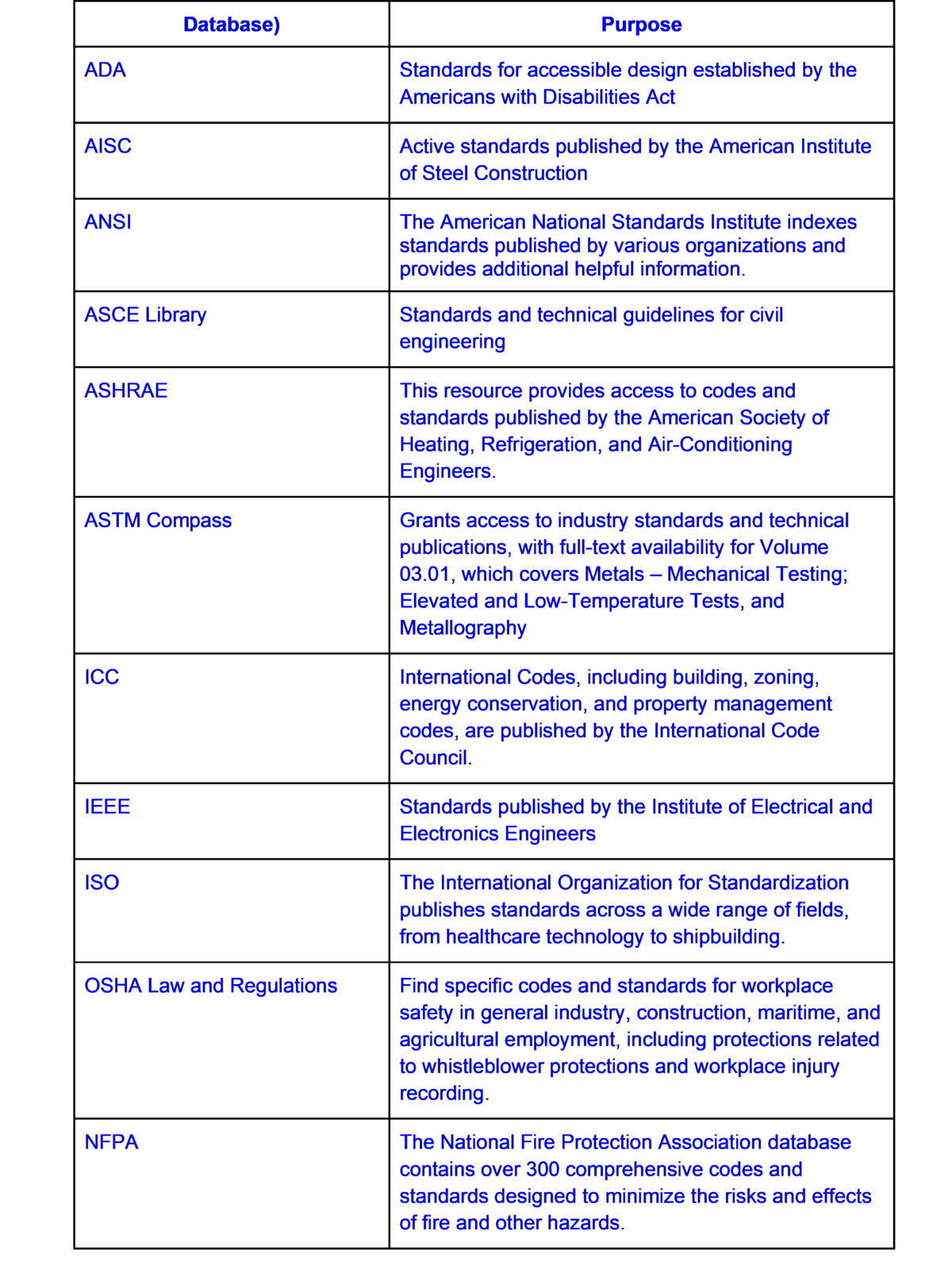
Here is a list of some possible standards or publications that might fit into your project; this is NOT an exhaustive list nor represents a globally aligned list.
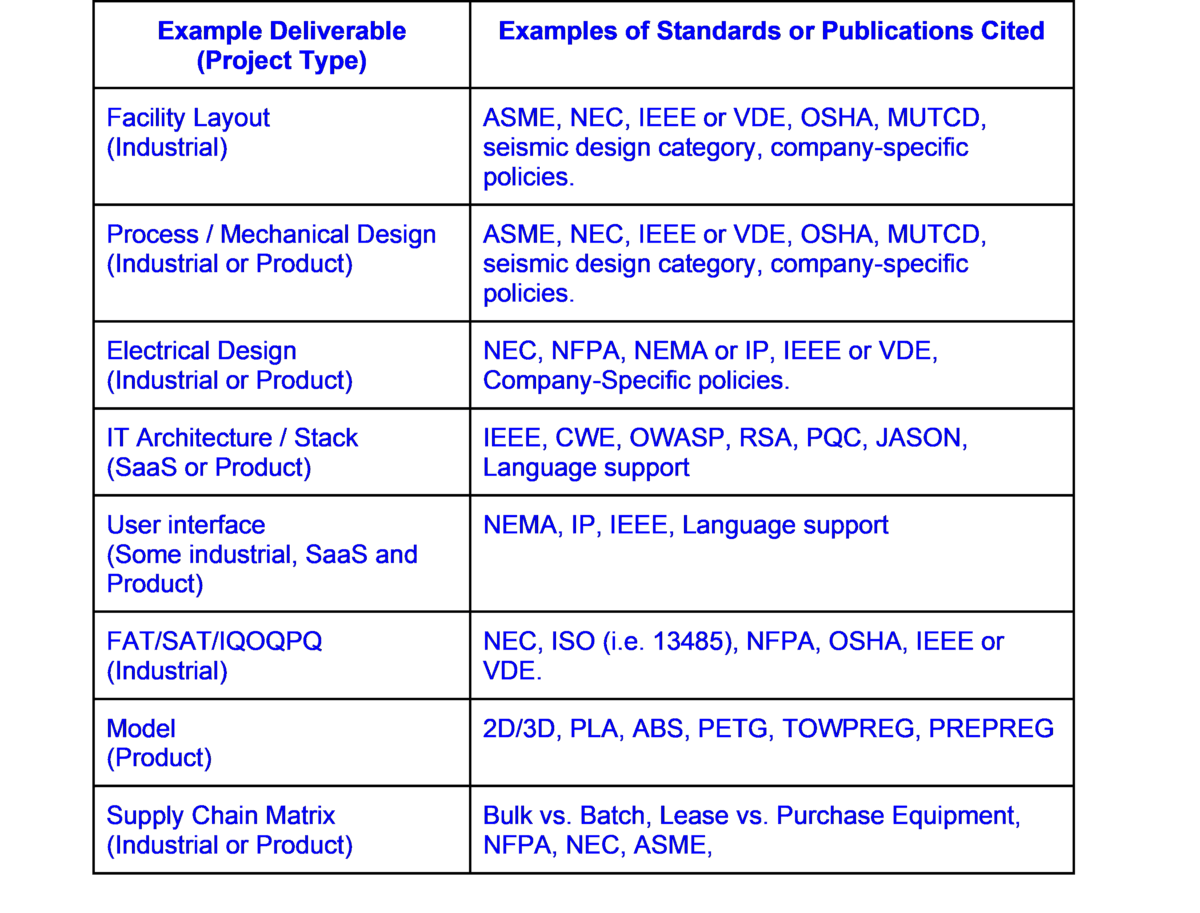
By utilizing company publications or references, it is possible to communicate acceptance criteria to the target audience. The document that you use to create your contract might, for example, make a reference to a business publication that addresses Process Safety Management (PSM), lockout-tagout-tryout (LOTOTO), or other safety standards. For the purpose of obtaining approval from the department, it is possible to produce these documents just once. It is possible to incorporate references into the boilerplate information that is included in your contract documents. Incorporating project-specific criteria into the primary body of the contract agreements for addition is a straightforward process that can be easily accomplished.
As a consequence of this, acceptance criteria are considered to have originated from a wide range of sources that are accountable for driving the project. Through the incorporation of these codes & standards, safety, project-specific, and client requirements into the project, it is possible to exercise control over the workmanship, scope, and pricing connected to the project. The criteria can also play a role in limiting the expansion of the project’s scope by defining targets to keep the team’s concentration and, as a result, reduce the amount of confusion regarding the project’s purpose.
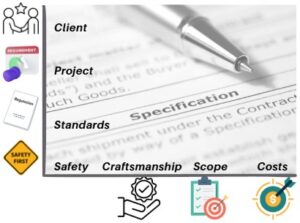 Moreover, the criteria must be concise and easily available so that they may be evaluated. One of the best examples of this is the quality of a product that has just been released to the population. As a result of the fact that operators and/or instruments are able to measure thickness and/or hardness, a product quality criterion can be evaluated in relation to a standard measurement of either of these qualities. However, the likeness of the product would leave room for interpretation and assumptions, and it would not provide the stakeholders with the valuable information that is required for the project to be successful. This would be a limitation of the certain criteria.
Moreover, the criteria must be concise and easily available so that they may be evaluated. One of the best examples of this is the quality of a product that has just been released to the population. As a result of the fact that operators and/or instruments are able to measure thickness and/or hardness, a product quality criterion can be evaluated in relation to a standard measurement of either of these qualities. However, the likeness of the product would leave room for interpretation and assumptions, and it would not provide the stakeholders with the valuable information that is required for the project to be successful. This would be a limitation of the certain criteria.
The following are some suggestions for individuals who are interested in writing acceptance criteria. Although this appears to be apparent, it is usual for teams to forget that acceptance criteria are written prior to implementation. This is despite the fact that this is something that is commonly known. It is necessary, at the absolute least, for there to be a single acceptance criterion for each and every feature that the customer has requested. The possibility exists that each acceptance criterion could be tested independently of the others. In order to satisfy the prerequisites for acceptance, there must be a clear differentiation between passing and failing.
If you write phrases that are lengthy and difficult to understand, you are putting yourself at risk. When it is appropriate to do so, it is important to incorporate both functional (i.e. speeds and rates) and non-functional (i.e. paint colors and finish) factors into the evaluation process. It is the responsibility of the product owner to make certain that the acceptance criteria that were drafted by the team in charge of project management are accurate. This demonstrates that the team and the owner have a common understanding of the project, which is a significant accomplishment.
When it comes to the criteria, it is of the utmost importance that they consist of a set of objectives that will define when the project is complete. This may be of the utmost value to a project team for a number of reasons, two of which are the elimination of uncertainty and the supply of a measurement of progress. When it comes to the accomplishment of the project, the criteria also serve as a benchmark for the company’s stakeholders, operators, and customers.
The project management team will benefit greatly from the criteria. In addition to supplying the members of the team with essential information, these metrics also serve as a representation of what the customer desires and what they are willing to pay for. Everyone in the organization feels a great degree of comfort when they are aware of what the expectations are and how success will be measured. This is because the entire organization is aware of what the expectations are. As a consequence of this, it is directly responsible for the construction of procedures and organizations that produce a minimal amount of chaos.

Case Study 5 – Acceptance Criteria
For the same Anheuser Busch (AB) expansion project talked about in Course 2 earlier, it involved no less than every department of the company, four large design firms, a major software group, and many vendors and field contractors operating from many locations. A large project like this had entire teams working separately on aspects of the project completely isolated from other teams.
 AB had a very mature set of standards to rely on. Everything from building codes and methods to process electrical standards, software coding and documentation norms, along with instrumentation and wiring standards. Even site safety was well established, allowing these teams to work efficiently. Project and departmental controls were well entrenched, gluing everything together.
AB had a very mature set of standards to rely on. Everything from building codes and methods to process electrical standards, software coding and documentation norms, along with instrumentation and wiring standards. Even site safety was well established, allowing these teams to work efficiently. Project and departmental controls were well entrenched, gluing everything together.
Regular project and departmental meeting structure allowed information to be shared, prioritized, and acted up on by stakeholders before it became an issue. Built into the system were regular progress reviews looking at the design, construction, and schedule, providing rich information for the middle managers to act upon and coordinate with other groups.

Exercise 5 – Identifying Issues

Course Manual 6: Detailed Design
The step that requires the most time to finish is the detailed design stage, which comes before going on to the building phases. This may comprise a wide variety of designs, computations, papers, validated computer code, procedures, and standards that are specific to the project. This is something that might vary depending on the types of projects that are being undertaken. During the stage of detailed design, the goal is to produce a package that can be constructed and consists of a collection of deliverables that can be examined to decide whether or not they are complete.
 The objective is not to end up with a design that is one hundred percent done; rather, the goal is to end up with an infrastructure that is one hundred percent thought through. The fact that this is the case indicates that all of the requirements for utilities, space, consumption and production rates, quality, connectivity, safety, and security are satisfied. When discussing what can be left out of the comprehensive design, it would be much simpler to do so if we used some uncomplicated examples, which are presented below. There are just a few exceptions that make sense, and this is due to the fact that they do not have any influence on the categories that were described earlier.
The objective is not to end up with a design that is one hundred percent done; rather, the goal is to end up with an infrastructure that is one hundred percent thought through. The fact that this is the case indicates that all of the requirements for utilities, space, consumption and production rates, quality, connectivity, safety, and security are satisfied. When discussing what can be left out of the comprehensive design, it would be much simpler to do so if we used some uncomplicated examples, which are presented below. There are just a few exceptions that make sense, and this is due to the fact that they do not have any influence on the categories that were described earlier.
It is possible that large-scale initiatives will involve a high number of devices, for example, when it comes to automation. However, it is possible to leave all wire and terminal details, including any necessary spares, until the finalization stage, which takes place after the reviews have been completed. This is despite the fact that it is essential to make certain that each instrument is sized, scoped, planned for in the input/output system, and listed in the Bill of Materials (BOM).
One further piece of evidence of this would be the building of a relational database for a new supply system that includes a database of parts for a new client’s sales portal. In spite of the fact that it would be important to include a significant number of part samples that provide all of the necessary features, code snippets, interfaces, and options, it is possible that it will not be necessary to enter every item in the database until after reviews have been completed. This is despite the fact that it would be necessary to include all of the necessary functional characteristics. At some point over the course of the solution’s existence, it is realistic to predict that new ones will be added and deleted.
 The team that is working on each of your projects can benefit from the fact that the concept of infrastructure completeness gives them advantages. To begin, it reduces some of the pressure that is associated with having one hundred percent of a design ready for review, and it enables the members to concentrate on what is most important. As a result of the fact that they are able to look for false negatives or uncover something that ought to be but is not, this cultural thought process will be of assistance in detecting more significant issues with architectural designs. When designs are printed on paper or included in a box, it is much simpler to study them; however, it is substantially more difficult to find the components that are missing from the design.
The team that is working on each of your projects can benefit from the fact that the concept of infrastructure completeness gives them advantages. To begin, it reduces some of the pressure that is associated with having one hundred percent of a design ready for review, and it enables the members to concentrate on what is most important. As a result of the fact that they are able to look for false negatives or uncover something that ought to be but is not, this cultural thought process will be of assistance in detecting more significant issues with architectural designs. When designs are printed on paper or included in a box, it is much simpler to study them; however, it is substantially more difficult to find the components that are missing from the design.
Critics who believe in prioritizing certain elements over achieving a fully polished design raise important warnings about potential issues during construction. It’s crucial to recognize that while innovations and priorities may temporarily shift focus, maintaining a clear understanding of the overall vision is key. Project management practices can help mitigate risks by integrating thorough planning and contingencies for unforeseen challenges. Moreover, involving experienced professionals in the design and planning phases can lead to solutions that address both efficiency and quality, reducing the likelihood of encountering significant issues when the project moves into construction. A commitment to iterative feedback and open communication can further smooth the path forward.
The notion that striving for infrastructure completeness might compromise creative and innovative design solutions is a concern worth investigating. However, fostering creativity within structured parameters is not only possible but can also yield exceptional results. By setting clear goals for both infrastructure integrity and design innovation, teams can explore novel ideas that don’t sacrifice practicality. Encouraging a culture that embraces experimentation while still maintaining focus on the project’s core objectives allows for the intersection of creativity and functionality. Additionally, showcasing successful case studies where innovative designs enhanced infrastructure projects can serve as inspiration, demonstrating that it’s indeed feasible to achieve both comprehensive infrastructure and exceptional design.
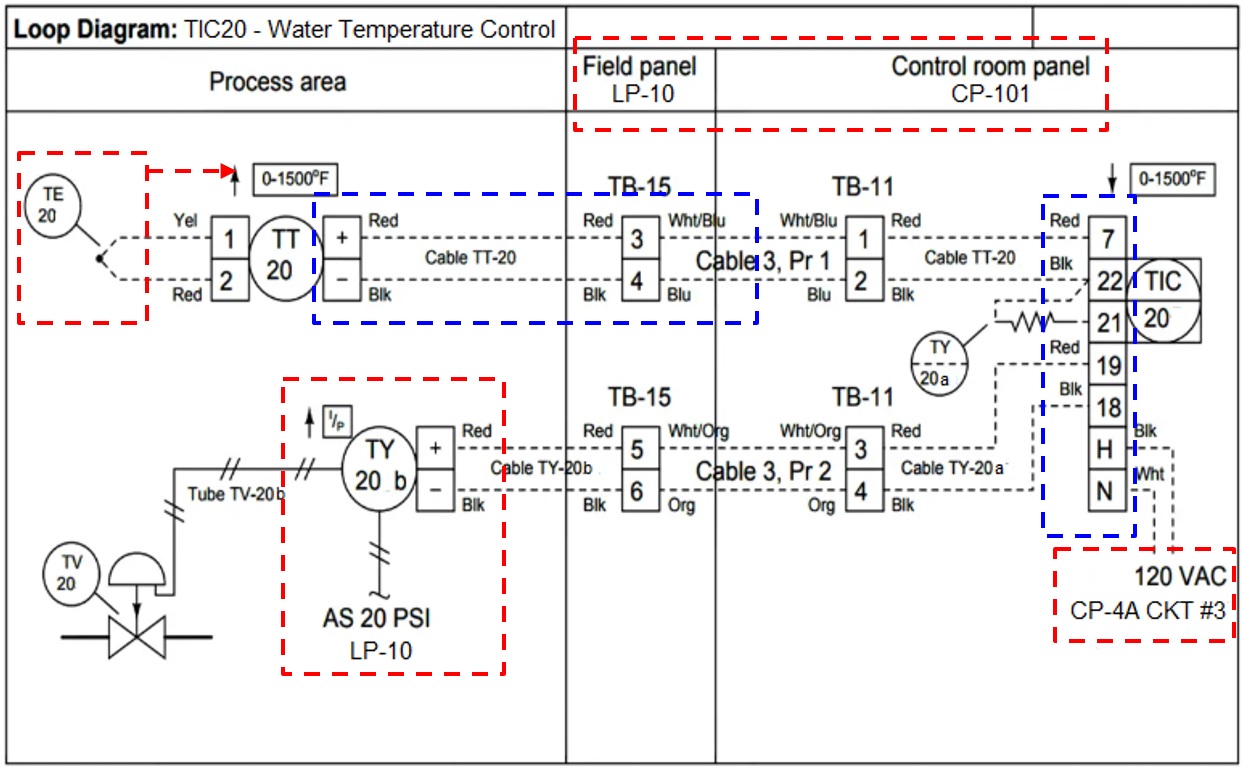
Example Industrial Loop Diagram
To work through an example of this, we shall leverage a classic loop as shown above. A loop diagram is one of a hundred types of drawings and figures that may involve a new project. In this case, this is depicting a temperature control for a water source and is named TIC20 (Temperature Indicating Control). It is not essential to understand the purpose of the loop for this small example; however, note all the information provided in this diagram. It shows round bubbles with labels such as TY 20b, TIC|20, TT20, and more. It also includes wiring information with terminal numbers and callouts. It even informs us about where specific components and sources of power come from, leveraging panel numbers such as LP-10, CP-101, and more.
Included in this example diagram are six colored boxes of two colors, blue and red. Being “infrastructure complete,” detailed design stages should focus on making sure all of the red boxes are complete. We need to know where sources of power are coming from, what cabinets will house what, what instruments are needed, how many, and what their functional ranges are. In this case, the temperature range of the measurement and control is 0-1500`F. Areas in blue indicate the detail that could be left blank because the engineering team has not completed this. These areas just denote terminal numbers, cable numbers, and so forth and have no bearing on the infrastructure of the project and thus could be left for later stages.
From Lab to Production
The production of pharmaceuticals is a multifaceted process necessitating extensive knowledge and skill to ensure the creation of safe, effective, and high-quality goods. A crucial phase in medication manufacturing is technology transfer, which entails conveying the information, techniques, and methodologies established during research and development (R&D) to the production team and facility.
An organization employs a specialist in Chemistry Manufacturing Control (CMC) for drug product production, whose primary responsibility is to supervise the technology transfer from the Research and Development (R&D) team to the Contract Manufacturing Organization (CMO) team and facility. What is the significance of technology transfer in the manufacturing of drug products?
Technology transfer is an essential phase in the drug development process since it guarantees that the product is produced in accordance with the defined protocols and requirements. The process entails conveying the knowledge and skills acquired throughout the drug product’s development and optimization to the production team. Inadequate technology transfer may hinder the production process from replicating the product quality attained during research and development, resulting in discrepancies in quality, safety, and efficacy.
Besides guaranteeing the quality of the pharmaceutical product, technology transfer is also helpful in expediting the market introduction of new pharmaceuticals with more efficiency. Transferring the technology to the CMO enables the R&D team to concentrate on new product development while the CMO can prioritize the production of existing items.
There are a number of essential processes involved in the process of technology transfer, all of which need to be managed with great care in order to guarantee a successful transfer. Included in these steps are:
>> The process of planning and preparation starts with the creation of a comprehensive strategy for the transfer of technology, followed by the determination of the important process parameters and the articulation of the roles and responsibilities of the teams that will be involved in the transfer. It is essential that the strategy for the transfer of technology incorporates timeframes, deliverables, and milestones in order to guarantee that the transfer will be finished on time.
>> The process of developing and optimizing the manufacturing process entails ensuring that the process is resilient, reproducible, and achieves the intended product quality criteria. This is done in order to optimize the manufacturing process for production at a larger scale. During the process of scaling up, the CMO team should collaborate closely with the R&D team in order to gain an understanding of the process and identify any potential problems that may occur.
>> Designing and Validating Analytical Procedures: This process entails designing and validating analytical procedures in order to guarantee that the product satisfies the needed quality criteria. For the purpose of monitoring and controlling the quality of the product while it is being manufactured, analytical methods are utilized. Additionally, the CMO team ought to collaborate closely with the R&D team in order to guarantee that the analytical procedures are appropriate for the manufacturing process.
>> The process of generating and reviewing all of the necessary paperwork, including process validation reports, analytical method validation reports, and batch records, is referred to as “documentation and reporting.” In order to guarantee that the transfer is adequately recorded, the documentation must be exhaustive and precise.
>> Training and Transfer Execution: This entails providing the manufacturing team with training on the new process and carrying out a trial transfer in order to guarantee that the process is functioning as anticipated. It is important to keep a close eye on the trial transfer in order to spot any potential problems that manifest themselves during the process.
Addressing critics who argue that the emphasis on technology transfer might overshadow other critical aspects of pharmaceutical development requires a balanced approach. It’s essential to acknowledge that while technology transfer is a key element in the process, it should not eclipse other crucial factors like regulatory compliance and ethical considerations. Pharmaceutical development is a multifaceted endeavor, and ensuring that products meet regulatory standards is vital for patient safety and efficacy. Ethical considerations, including transparency during the development process and considerations for patient impact, must also be at the forefront. Therefore, striking a balance between efficient technology transfer and maintaining a strong focus on compliance and ethics is fundamental to fostering a holistic development environment.
The possibility of gaps in communication between the R&D and CMO (Contract Manufacturing Organization) teams is indeed a significant concern that can lead to inefficiencies in the technology transfer process. Such gaps could result in misinterpretations of research findings, inconsistencies in product specifications, and misunderstandings regarding timelines or requirements. These issues can compromise the quality of the final product and ultimately affect market performance and patient safety. To mitigate this risk, it’s crucial to establish robust communication strategies, such as regular meetings, shared documentation systems, and integrated project management tools that facilitate real-time collaboration. Encouraging a culture of openness and feedback can also help bridge any communication divides and ensure that both teams are aligned in their objectives and expectations.
In response to claims that reliance on technology transfer may hinder innovation and adaptability to evolving market needs, it’s important to recognize that technology transfer should not be viewed as a static, one-time event. Instead, it can be integrated into a broader innovation strategy that encourages ongoing development and flexibility. By fostering an environment where technology transfer is accompanied by continuous improvement initiatives and iterative feedback loops, organizations can remain responsive to changing market demands. It’s also vital to invest in R&D to explore new methodologies and formulations actively while developing the technology transfer process. This concurrent focus on innovation alongside efficiency can empower companies to enhance their offerings while still adhering to the best practices of technology transfer.

There is a possibility that the project could gain a significant amount from the verification of process models or computations. In order to support all of the effort that has been put in up to this point, as well as the effort that will be put in during the later stages and the subsequent building phases, it would be more helpful to have validated math that is being relied upon. This would be the case since it would be considered most beneficial and would drive confidence up for the stakeholders. Additionally, in the event that it is viable, this should be achieved during the earlier idea stage; but, in the absence of specifics regarding the process design, it is possible that producing a quality model at that time will not be achievable. At this stage in the review process, it is important to evaluate and validate any and all estimates that are considered extremely significant. Furthermore, models should be completed and approved, and samples should also be completed and confirmed before being considered complete.
There is a potential that in order to accomplish a more comprehensive goal it will be necessary for different projects to collaborate in order to complete difficult projects. There is a potential that one project will include confirming the market with a new product, while another project will involve working on boosting the manufacturing capacity. Both of these projects are possible. It is assumed that the project team working on the market validation project is determining product specifications and client acceptance criteria. Meanwhile, the project team working on the at-scale production is working on information that has been provided by the other team. According to the criteria, these efforts are connected to one another, and if they are not managed in an acceptable manner, they have the ability to influence the outcomes of individual initiatives.
As the number of projects and the complexity of those projects both increase, the importance of interproject communication, which is sometimes referred to as information exchange, becomes increasingly significant. During these moments, the organization and business processes of your firm will once again become key resources that you will be able to rely on. While it is possible that more information could be better, it is necessary for the entire community to have some context of the communications in order to comprehend the quality of the information. It is important for organizations to take care of the manner in which information is disseminated, and it is also possible that more information could be better. As a result, the members of your project management team should be the ones to communicate pertinent information to persons who are not a part of the project team. This is the case regardless of the circumstances.
When addressing someone who argues that complex projects may not benefit from increased interproject communication due to the risk of information overload, lets first acknowledge the point. Information overload can indeed lead to confusion and inefficiencies if not managed properly. However, we should emphasize the importance of establishing clear communication channels and protocols that prioritize the relevance and clarity of shared information. By implementing strategies such as summarizing key points, utilizing targeted communication, and creating structured updates, teams can mitigate the risks of overload while still reaping the benefits of collaborative insights and shared knowledge.
In response to the concern that relying solely on project management teams for communication might limit diverse perspectives and insights from other stakeholders, lets highlight the value of inclusivity in communication processes. Engaging a broader range of stakeholders—such as end-users, subject matter experts, and even external partners—can lead to richer discussions and more innovative solutions. I would suggest creating forums for regular input and feedback from these diverse voices, allowing project management teams to harness this wealth of knowledge. By incorporating a wider variety of perspectives, we can challenge assumptions, spark creativity, and ultimately enhance project outcomes.
To critics who claim that an emphasis on structured information exchange could inhibit creativity and spontaneity within teams, a balanced approach is always best. Structured communication does not necessarily equate to rigidity; it can serve as a framework within which creativity can flourish. By having established channels for sharing information, teams can allocate more time and mental space for brainstorming and innovative thinking. Moreover, fostering an environment that encourages open dialogue and the sharing of ideas—within those structured parameters—can actually boost creativity. Lets encourage teams to build flexibility into their processes, allowing space for free-thinking and exploration while maintaining the clarity that structured communication provides.
Completing the Stage
Following the completion of the detail stage, the team that was working on the project as well as the stakeholders should conduct a thorough evaluation of the detailed design package. It is strongly suggested that this review be somewhat extensive and exhaustive and that it include the entirety of the approach. It is required to take any number of procedures, including keeping action item logs, carefully checking and marking up drawings, and even getting them signed off by departments that are in agreement with the change. It would have been preferable to conduct interdepartmental reviews before the occurrence of this event in order to prevent any surprises, gaps, misrepresentations, or inaccuracies from occurring. Affixing dates and signatures to the review sets is the next step, after which the sets should be permanently saved in the document centers of your organization.
Key justifications for the importance of design reviews

The elimination of any doubt or barriers that your business might have in the last stages of the project is the objective of this endeavor, which aims to complete the project more efficiently. It is possible that projects that are driven by innovative research or technology will be particularly difficult to complete, provided that the science or technology in issue has not been verified to the extent that it can be scaled up to satisfy the objectives of the project. The practice of prudence is of utmost importance with regard to matters that have the potential to bring about challenges for the project and may necessitate additional design, confirmation, or even prototypes. As a result of the fact that it is vital at this point to actively seek out and eliminate these obstacles before moving on to the next level, the review process needs to be interactive and accessible.

Case Study 6 – Detailed Design
As companies adopted the new Aluminium bottle, upgraded lines were necessary that could handle the newer style bottles. With these projects, line upgrades always came with new equipment and standards. On once such project for a world-class brewer, the project also required some challenging process upgrades to support the various products the new line was required to handle.

For this particular project, a complex mix of delivery systems needed to work together to provide the steady stream of beer to the new upgraded line. Involving seven different systems and platforms, the integration for the project was very extensive and detailed.
However, as the detailed design was created and reviewed, the complexities of the integration were not understated nor ignored. Decisions that improved the reliability and function of the integrated process were taken over the ease and cost of construction. Necessary connectivity was put in place to ensure all the various options work seamlessly.

Exercise 6 – How many details does it take
Group Size: Split into groups of two

Course Manual 7: Construction Phases
There is a lot of excitement associated with moving on to the building phase of a project after the design portion of the project has been completed. On the other hand, the corporation has to be adhering to a standard operating procedure, and if it is carried out with attention to details, it will result in enormous benefits for your organization. In spite of the fact that the project can go through some subsequent phases with designs that are not yet finished, the organization ought to be adhering to the script. It is feasible for this building phase to easily overlap and blend into your other phases, as is the case with the majority of phases; nevertheless, this should not confuse the process but rather emphasize the reasons why the process should be kept to in a severe manner for the reasons that have been stated.
 Even if the project is being carried out using resources that are already in place, the scope of work (SOW) should be made clear before any work is done. It is conceivable for general contractors to take on the obligation of employing subcontractors; however, these agreements are often more administrative in form than they are technical in nature. Consequently, it is of the utmost importance to have a strong understanding of the distinctions that exist between the two. The screenplay, on the other hand, does not change; the only things that are altered are the characters and the flow of money.
Even if the project is being carried out using resources that are already in place, the scope of work (SOW) should be made clear before any work is done. It is conceivable for general contractors to take on the obligation of employing subcontractors; however, these agreements are often more administrative in form than they are technical in nature. Consequently, it is of the utmost importance to have a strong understanding of the distinctions that exist between the two. The screenplay, on the other hand, does not change; the only things that are altered are the characters and the flow of money.
General Contractors
A general contractor is a construction manager who works for a customer, typically on the architect’s or engineer’s recommendation. In addition to being primarily in charge of project coordination, general contractors can also serve as building designers and construction foremen, who oversee a team of workers.
The scope of work (SOW) and project-specific documentation must be evaluated first by a general contractor. A site visit is necessary for renovations in order to gain a better understanding of the project. The general contractor will provide an estimate, cost-plus pricing, or a fixed price bid or proposal, depending on the project delivery method. In order to give the owner with a project price, the general contractor takes into account the cost of personnel, materials, equipment, general circumstances, and home office overhead.
Drawings, project manuals (including general, supplemental, or special conditions and requirements), and addenda or amendments released before proposal or bidding and created by a design expert, like an architect, are examples of contract papers.In addition to managing the project and taking on legal and financial risks, the general contractor may also take on the responsibilities of a construction manager.Risks can take many different forms, including as cost overruns, delays, and liabilities resulting from safety or contract violations.
The general contractor a customer chooses to give a contract to before a formal appointment is frequently referred to as a “preferred contractor.”
Duties
A general contractor is in charge of supplying all the supplies, labor, machinery (including large machinery and tools), and services required for the project’s construction. Specialized subcontractors are frequently employed by general contractors to complete all or parts of the building project. The general contractor is in charge of monitoring the caliber of all work done by all employees and subcontractors while using them.
Prioritizing safety on the job site is best practice for general contractors, who are typically in charge of making sure that work is done in accordance with safe procedures.
Applying for building permits, advising the person who hired them, protecting the property, providing temporary utilities on site, supervising staff on site, providing site surveying and engineering, disposing of or recycling construction waste, keeping track of schedules and cash flows, and keeping accurate records are just a few of the duties that a general contractor may have.
Certain aspects of the design, known as the “contractor’s design portion,” may fall under the purview of the general contractor.
Usage in Asia and the United States
When referring to small local businesses that do residential construction, the terms “prime contractor,” “main contractor,” and “general contractor” (or just “contractor”) are frequently used interchangeably in the US and Asia. Trade associations like the NAHB represent these businesses.
Usage in Australia, the Commonwealth, and the United Kingdom
Throughout the early 20th century, builders gradually replaced the term “general contractor” in the UK, Australia, and some British Commonwealth nations. The term ‘general contractor’ became obsolete except in large organizations where the top manager is the main contractor and a general contractor shares responsibilities with professional contractors. This was the term used by major professional, trade, and consumer organizations when they issued contracts for construction work.
“Builders” is a common term used to describe general contractors who work for government organizations. This phrase is also used when the customer’s immediate general contractor is allowed to subcontract or when there are likely to be situations when subcontracting to specialized operators is necessary, such as in a variety of public services.
Construction Packages
At the beginning of the script, the conditions of delivery and the construction statement of work are being finalized. A statement of work is also being constructed. The “Construction Package” is the document that is distributed when all of the design review comments from the detailed design stage have been resolved. In spite of the fact that it is feasible for subcontractors to examine and start working on their proposals for the work on the pre-reviewed design package, it is essential to keep in mind that they are able to review any changes before submitting their bids. On the other hand, the construction package is the document that is utilized during the process of signing the agreement.
The Statement of Work (SOW) is the large document that acts as the foundation for the drawings and numerous details. It contains all of the specifications, standards, acceptance criteria, and metrics that will be used to manage the project. These are all contained in the SOW. As a result of the fact that contractors have a great deal of experience with this particular type of written scope, they will not have any issues adopting it.
When it comes to the vast majority of enormous projects, the components of the building package can be broken down into smaller portions that are easier to manage. In the industrial sector, the technique of separating the task into logical construction sequencing, or for reasons connected to production or craft, is a common and widespread practice. Although even the general contractors will want that each component of the package be broken down for them, this is something that is acknowledged on a company level with relation to the engineering process that they use.
After the organization has completed the process of assessing all of the SOW and packages and has distributed offers, it will have the choice of either carrying out the execution as planned or looking for ways to minimize costs. For a variety of reasons, it is true that going over budget at this stage occurs more frequently than we would want to recognize; the reasons for this are numerous; nonetheless, if there were no mechanism in place, the situation would only become more grave. The fact that you have a dependable technique enables you to go deeper into the designs, ask significant questions, bring the statement of work and packages up to date, and ask for requotes or changes. All of these things are possible because you have the ability to inquire about these things. Furthermore, it is of the utmost importance to initiate collaboration with your contractors at this very moment. Regardless of whether or not the proposals are accepted, it is absolutely necessary to make certain that they have a comprehensive comprehension of the project’s scope and deliverables.
The contracts are drafted during the procedure that comes after the proposal has been submitted. However, now is the time for your company to issue paper in order to get the contractors to begin their work. We will cover the many forms of contracts and agreements in the future part; however, in the meantime, we will discuss the various types of contracts and agreements. The day-to-day operations of these contractors are the responsibility of a construction manager, who is responsible for managing these operations once the workers have commenced their shifts. In spite of the fact that this work can be carried out in-house or by the project manager, there is an increase in the risk that is involved.
When it comes to the construction sector, construction managers are well-versed in the protocols, protocols, codes, and standards that subcontractors are expected to comply to. Additionally, they are aware of the obstacles that are involved with construction, such as staging, work safety, the delivery and administration of equipment, and other difficulties that are related to the construction industry. In order to guarantee that the work is of a good quality, the order in which the work is performed is also of the utmost importance. A straightforward illustration of this would be to make ensure that the conduits and pipes that are buried underground are laid down prior to the laying of the concrete floor.
It is possible for a contractor to suggest modifications to the design either directly prior to the construction phase or during the construction process itself. It is encouraging to see that your contractor is excited about working with you as a customer and is interested in improving the design. This is a positive indication. In spite of the fact that the modification may be less complicated and more cost-effective for the contractor, this typically leads to improved craftsmanship and efficiency in the majority of circumstances. Once more, the contractors will be impressed by the organization and processes of your company, which will assist you in developing a strong relationship with them.
Types of Projects
Bulk sum (fixed price) contracts, cost-plus contracts, time and materials contracts, unit price contracts, design-build contracts, and guaranteed maximum price (GMP) contracts are some of the most frequent types of construction contracts. The precise requirements of the owner and the kind of project that is being carried out are taken into consideration when determining the advantages and disadvantages that are associated with each of these different types of contracts.
 Contracts with a lump sum (fixed price): Regardless of actual costs, a set, fixed fee is agreed upon for the duration of the project. Ideal for projects with a clear scope and little chance of change. Predictable expenses and a well-defined budget are the advantages of this kind, although contractors may be at risk if unanticipated problems occur.
Contracts with a lump sum (fixed price): Regardless of actual costs, a set, fixed fee is agreed upon for the duration of the project. Ideal for projects with a clear scope and little chance of change. Predictable expenses and a well-defined budget are the advantages of this kind, although contractors may be at risk if unanticipated problems occur.
Cost-plus contracts: Include a fixed charge or percentage for the contractor’s profit and overhead in addition to the owner’s payment of the actual costs of labor, materials, and other expenses. Perfect for big or complicated projects whose scope isn’t quite clear up front. This type’s advantages include the contractor’s incentive to finish the job quickly and the flexibility to adapt to adjustments. Less cost certainty for the owner and the possibility of cost overruns are the drawbacks.
Contracts for Time and Materials: Under these agreements, the contractor gets compensated for the labor hours actually spent on the project as well as the cost of the materials utilized, at predetermined hourly rates and material costs. Ideal for ongoing initiatives or projects with an ambiguous scope. This type’s advantages include comparable adaptability to changes and an incentive for the contractor to finish the job quickly. Cons include less cost certainty for the owner and the possibility of expense overruns.
Unit Price Contracts: Under these contracts, the contractor receives payment at a set rate for each completed unit of work, such as square feet, linear feet, or cubic yards. Ideal for projects that include recurring tasks or where it is possible to estimate amounts with a good degree of accuracy. This type’s advantages include cost transparency and better progress and cost tracking. Less flexibility for projects with substantial scope modifications may be a drawback.
Design-Build Agreements: A single organization manages a project’s design and construction stages. simplifies the procedure and may result in a project that is completed more quickly. A single point of accountability, quicker project completion, and lower expenses are advantages of this kind. These kinds, however, might not be as adaptable for projects with intricate or changing design specifications.
Contracts with guaranteed maximum prices (GMPs): Include aspects of fixed-price and cost-plus agreements. The owner is responsible for paying the full cost of the project plus a predetermined charge, while the contractor guarantees a maximum price. This type’s advantages include adaptability to changes and incentives for contractors to finish projects quickly while giving the owner cost stability. But administering these can be more difficult.
Scheduling
When it comes to ensuring that everyone is on the same page throughout the course of the building phases of the project, particularly as the project draws to a close, the timeline becomes an increasingly important factor. Though it is vital for the team in charge of project management to have a timetable in order to monitor progress, the objective shifts to controlling what could be described as “organized confusion.” This expression was conceived of and produced as a response to a situation that is described as being one in which there is a great degree of confusion combined with positive consequences. There is another item that can be referred to by this term, and that is a state of orderly progression that takes place inside a plan.
There is also the possibility that construction will require essential tie-ins, which will need to be finished in conjunction with the employees of the facility. Everyone should be involved in the connection that joins data centers throughout the whole of the connectivity path, and careful attention should be given to what would take place during the connection and in the immediate aftermath of the connection. Prior to the implementation of these kinds of tie-ins, crucial performance testing will likely be required.
Because there are so many moving parts, people, and tasks that are all striving toward the same goal for the same reason, the phrase “disorganization” is easily confused with the scenario. This is because there are so many moving individuals, tasks, and aspects. Your project management team, on the other hand, will be able to comprehend all that is taking place and the reasons behind it if they make use of robust methods. In addition to this, they will become the only person or group that is capable of effectively conveying what is happening to the company and the people who have a stake in it.
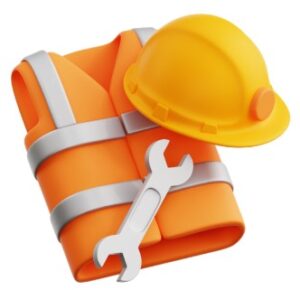
Working Safely
Safety managers uphold construction safety. It results from proper equipment use, worker protection, site inspections, and risk assessments. Compliance with regional safety and health requirements is crucial to construction safety.
Improving construction safety may initially be to comply with workplace safety and health laws, but it also reduces safety dangers and occurrences. Safety hazards and events damage the company’s reputation with industry professionals and regulatory bodies and can cost it a lot of money.
Medical and legal fees are other direct costs of occurrences resulting in injuries or illnesses. Indirect costs include training replacement or substitute workers, repairs to damaged equipment or property, lost productivity, and reduced worker morale.
Prioritizing construction safety strengthens confidence between workers, managers, and executives. Trust improves workplace communication, reducing misunderstandings and conflicts. Construction safety practices boost worker productivity and efficiency. When companies train and safeguard workers, they can work safely and successfully. Construction site induction is a good time to do this.
10 Common Construction Safety Risks
Construction is one of the most dangerous sectors and involves high-risk tasks; thus, construction safety managers may need to know what to watch out for to keep workers safe. Construction safety managers can use a mobile construction site inspection app with risk-specific checklists.
1. Falls, Slips, Trips
Fall, slip, and trip accidents are typically linked to ladders and operating at heights. As a top ten OSHA violation, ladder safety is crucial to preventing such tragedies. Pre-shift ladder inspections are required by OSHA. A mobile inspection software can help construction safety managers meet this OSHA requirement by detecting hazards that could cause falls, slips, and trips.
2. Moving Gear
Scaffolds and ladders are dangerous, although some are immovable, limiting their risk to bystanders. Construction machinery, transportation equipment, and load-lifting equipment pose larger safety risks than scaffolds and ladders. Construction safety managers should ensure workers follow safety protocols when moving or lifting equipment to prevent similar incidents. Construction safety managers must also meet regional standards.
3. Height Work
Construction work at 2 meters or higher is called working at heights. One of the leading causes of preventable job injuries and deaths worldwide. Whenever possible, avoid working at heights, yet most construction work may need it. Download and use these four free digital templates to help construction safety managers reduce height risks.
Due to the widespread usage of scaffolds, construction safety managers must provide reliable scaffold inspections every 7 days after installation by a scaffold-qualified person. Construction safety managers can give this person this template to help them understand OSHA scaffolding safety regulations.
4. Handle manually
Manual handling involves lifting, lowering, carrying, and moving goods at work. In addition to hand-arm vibration, high-risk manual handling involves repetitive, persistent, intense, or sudden force, movement, posture, and whole-body vibration. Manual handling hazards must be assessed to prevent musculoskeletal problems such HAVS, epicondylitis, and rotator cuff injuries.
5. Noise
Noise as a construction safety problem may seem strange, but facts show otherwise. People get hearing problems from workplace noise every year. Noise risk evaluations, especially in construction, can identify sources and how they effect worker health and safety.
6. Electricity
Electrocutions, the deadliest construction safety issue, are due to electricity. Lack of fundamental electrical safety understanding when handling electrical equipment is a primary cause of construction worker electrocutions, according to the Center for Construction Research and Training. Construction safety managers should perform periodic electrical inspections and maintenance to prevent electrocutions and other electricity-related injuries. This also helps construction organizations meet OSHA electricity rules.
7. Hand-arm vibration
Hand-arm vibration syndrome (HAVS) affects hand nerves and blood vessels permanently. Construction workers are most at risk of HAVS from using vibrating tools like concrete breakers, hammer drills, and grinders.
8. Falling Trenches
Trench is a narrow underground excavation. OSHA warns that collapsing trenches or cave-ins are the most dangerous excavation-related occurrences, resulting in most worker deaths. Construction safety managers should do daily excavation risk assessments to ensure workers enter trenches after sloping, benching, shoring, and shielding.
9. Dust
Blasting, cutting, drilling, grinding, and polishing bricks, tiles, concrete, and mortar creates silica dust. Silica dust can cause lung cancer, silicosis, and COPD if exposed excessively. In 2014-2015, the US age-adjusted COPD death rate was 39.7 per 100,000, according to the CDC.
10. Asbestos
Asbestos-related diseases kill 12,000–15,000 Americans annually, while occupational asbestos exposure kills over 200,000 worldwide. Construction safety managers should remember that failing to install controls may result in a visit from the regional enforcement agency. Not conducting asbestos inspections may result in hefty penalties for non-compliance.
How should we address someone who argues that compliance with safety regulations alone may not significantly reduce workplace injuries without a culture of safety embedded in the organization? Addressing this perspective requires acknowledging the importance of both compliance and culture. We might begin by recognizing that while compliance with safety regulations is critical, it is often viewed as the minimum standard rather than a comprehensive solution. Without a culture of safety, regulations might be seen as checkbox items rather than fundamental values integrated into daily operations.
To ensure a true reduction in workplace injuries, fostering a culture that promotes safety at all levels—from leadership to employees—encourages personal responsibility and proactive safety measures, creating an environment where everyone feels accountable for their own safety and that of their colleagues. Moreover, those organizations that successfully entwine safety into their core values often see enhanced morale, productivity, and overall performance.
What would we say to someone who believes that investing in safety practices might be viewed by management as an unnecessary expenditure rather than a vital investment in the workforce’s well-being? It’s important to frame the conversation around safety investments in terms of return on investment (ROI). While some management teams may initially perceive safety practices as an added expense, emphasizing that these practices are critical to workforce wellbeing could change that perspective.
Providing data that illustrates the costs associated with workplace injuries—such as medical expenses, lost productivity, and potential legal repercussions—can support the argument that investing in safety is not only prudent but necessary. Moreover, by cultivating a safe work environment, companies enhance employee morale and engagement, which can lead to improved performance and lower turnover. You might suggest that companies conduct a cost-benefit analysis to demonstrate how even a modest investment in safety training and equipment can yield significant long-term savings and benefits, reinforcing that the wellbeing of the workforce should be viewed as an integral part of the company’s success.

Case Study 7 – Construction Phases
A large personal care products company needed to upgrade a production line to reduce waste and increase product efficiencies. The project called for a new machine that had never been built nor tested before but represented the latest technology with precision robotics, sensors, and controls. The project management team produced painstakingly detailed designs and developed a schedule on how the machine would be built, tested, and put into production.
 Since the current running production machine occupied the same location as the new machine (no alternate was possible), the new machine needed to ramp up fast with production demands. Most electro-mechanical machines are built in factories and tested prior to shipment, but this project employed a quality measure before it could ship out of the factory. Hence, more time was spent testing and validating at the factory during the Factory Acceptance Tests (FAT) than with most projects.
Since the current running production machine occupied the same location as the new machine (no alternate was possible), the new machine needed to ramp up fast with production demands. Most electro-mechanical machines are built in factories and tested prior to shipment, but this project employed a quality measure before it could ship out of the factory. Hence, more time was spent testing and validating at the factory during the Factory Acceptance Tests (FAT) than with most projects.
The dividends paid off during the construction phase. Once the unit was operating satisfactorily, it was broken down and shipped to the site. A contracted onsite crew took three days to unload, assemble, and power up the components, allowing production to resume on the fourth day. With some pre-staging of finished goods prior to the shutdown, the production plant never was short of production goals.

Exercise 7 – Confessions
Group Size: Entire group

Course Manual 8: Commissioning Stages
The implementation of the concept, which will result in the production of some product or service, will begin when the construction is getting closer and closer to being finished. Despite the fact that your project might not involve any hardware or electromechanical components, the methods that are necessary to commission your system, production line, or service are generally equivalent. This is because the steps involved in commissioning are similar. The procedures that are necessary will be compatible with the majority of projects because your firm is using the Stage-Gate approach as its primary engineering process. Furthermore, despite the fact that this course does not discuss research projects, the majority of the material that is given here is still highly applicable to those as well.
It is becoming increasingly vital to make use of the right commissioning procedures as the complexity of the system continues to expand. When your team is trying to ramp up production on a system that is experiencing problem after problem and not producing the quality product at the rate that is needed, this is absolutely the last thing that they would want. Consequently, commissioning is not a straightforward procedure that involves turning something on; rather, it is a methodical approach that involves ensuring that the design, craftsmanship, safety, and, last but not least, the science that lies behind it all work together to produce something.
Working Safely Redux
Worker safety, often known as safe working conditions, is not something that an individual is responsible for ensuring. It is true that the individual is required to acknowledge and adhere to the regulations of the company and the project; nonetheless, the policy of the organization should be to allow no room for discretion. There are many different disciplines and dangers involved in industrial initiatives, and not all personnel are familiar with them. From the beginning of the construction process, it may be necessary to hold daily safety meetings in order to keep personnel informed about what is going on.
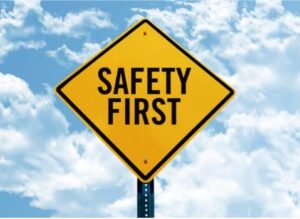 During commissioning, there is even more risk because energy sources are being turned on and tested by different resources at different times. It is important for project management teams to emphasize the importance of safety during each meeting, and stakeholders should conduct safety inspections of work areas to ensure that they are safe.
During commissioning, there is even more risk because energy sources are being turned on and tested by different resources at different times. It is important for project management teams to emphasize the importance of safety during each meeting, and stakeholders should conduct safety inspections of work areas to ensure that they are safe.
Falls, being struck by items, electrocution, and being caught in the middle are the four most prevalent causes of worker fatalities on construction sites. These four reasons are commonly referred to as the “fatal four,” and they are the most common causes of worker fatalities. According to the Bureau of Labor Statistics of the United States of America, the deadly four were responsible for more than half (57.7%) of the fatalities that occurred among construction workers in the United States in 2013. Workplaces that are safe have the potential to improve morale and productivity while also reducing the financial and human costs associated with accidents.
While personal accountability is crucial, it often exists within a broader organizational context that shapes safety culture and practices. Organizations establish guidelines and policies that are meant to protect employees, and these frameworks can significantly influence individual behavior. It’s not solely on the individual to navigate the landscape of risks and hazards; rather, there should be a collaborative effort where both personal responsibility and organizational commitment work hand-in-hand to ensure a safer environment. Encouraging personal responsibility can be beneficial, but it should not absolve organizations from their duty to provide adequate training, resources, and support.
Regarding a perspective that some organizations may lack the resources to implement stringent safety measures consistently, it’s essential to recognize that resource limitations can create significant challenges. However, safety should be viewed as a critical investment rather than a mere expense. Organizations, regardless of size or budget, can prioritize safety measures that are appropriate for their specific circumstances. This might mean taking incremental steps toward improvement or focusing on the most high-risk areas first. Encouraging discussions around resource allocation, potential partnerships, and leveraging technology can make safety more accessible, even for organizations facing financial constraints. It’s also vital for stakeholders to advocate for adequate funding and support from larger entities or the government to enhance the overall safety culture.
In response to a claim that safety regulations can be overly bureaucratic and hinder project efficiency, it’s worth considering the balance between regulation and practicality. While some regulations may appear cumbersome, they are often established based on data, past incidents, and the goal of protecting workers. It’s crucial to engage with stakeholders to continually assess and refine these regulations to ensure they meet safety needs without becoming a barrier to productivity. Open communication between regulators and organizations can help streamline processes and find ways to make compliance more efficient. Encouraging a culture that views safety as an integral part of project success, rather than a hindrance, can promote innovative solutions that satisfy both safety and efficiency objectives.
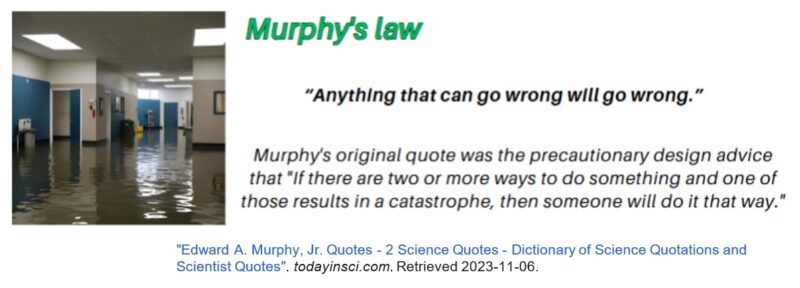
Commissioning is one of those events where even good organization, coordination, and communication may break down easily, creating dangerous safety issues for everyone involved and around the event. Here are some situations you can think about that developed over the years of one person’s past:
During the commissioning phase of an upgraded coal plant, the workers experienced flooding and debris as the new control system code was tested. Since this was a ‘Jig’ plant, the coal material, being cleaned and separated, was suspended across the facility’s three main levels with large amounts of liquid. If there was some kind of fault, common during early commissioning phases, the plant had to fail properly; otherwise, all the material and liquid would just crash down onto the ground. The workers had to clean up the mess more than a couple of times.
During the early testing of an alcohol blender, the blender had to pump to totes instead of the finished product bulk tank. When the tote became full, someone had to switch the hose to another tote. If the timing and coordination between the testing crew were not sharp, someone could get washed down with flavored alcohol.
Overcommunication during commissioning is vital. Five formal communication methods exist: verbal, nonverbal, written, listening, and visual, and all of these are vital during commissioning. Perfecting these is highly suggested, but most importantly, the right mix is essential. For example, when coordinating a plan involving a small team, it is recommended that the team get together and discuss the plan and sequencing using the verbal, nonverbal, listening, and visual methods. This will not only help all members of the team but also provide reinforcement. On the other hand, trying to coordinate a large group from different departments and/or companies, the team approach is great, but larger, complex plans require a written follow-up for reinforcement and documentation.
Tips for effective communication include concision and clarity, which prevent misunderstandings, so use language that is clear and succinct. Request input to find areas where you may enhance your communication approach. Also,be aware of your tone and delivery, be mindful of your non-verbal clues and voice tone. Engage in active listening by concentrating on comprehending the viewpoint of the other person. Finally, think about your audience and adapt your message to the needs of the target audience.

Layers
In order to study any project, let us first examine it in the form of the layers that it is dependent on. At the same time that it is necessary for buildings to be placed on a solid foundation, it is also necessary for the soil to be in good shape. In order for an electromechanical system to operate well, it is essential to have a foundation and utilities that are able to deliver the required power. In order for a software system to be successful, it may be important to have a background database that is able to deal with the demand. Similarly, in order for a telecommunications product to be successful, it is necessary to have a robust protocol in addition to diagnostic facilities.
Sublayers are actually contained within each of these layers, as a matter of fact. Taking the example of an electrical control system, wires and cables are utilized in order to make connections between the brain, or controller(s), of the system and the field instruments that are utilized by the system. Terminals or plugs are the points at which this assemblage of wires and cables reaches its conclusion. In order to guarantee that the wire does not have any connections that are not secure, the terminals need to be easily accessible, they need to supply an adequate amount of tension, and they need to periodically provide stress relief. As an extra illustration, take into consideration the layers that are a part of any network system that consists of servers, endpoints, applications, and connections.

Security Layers
During the process of commissioning these kinds of systems, methodologies that are either bottom-up or central-to-outer are applied during the process. Beginning with the foundations of the project, each component of the project ought to be evaluated and checked for errors before adding or permitting subsequent layers. This should be done before any other layers are added or permitted. During the initial stages of the project, both the critical performance indicators (KPIs) and the acceptance criteria were established. Even if the key performance indicators (KPIs) might not be useful until the top outer layers of your project are operational, the foundations of the project are dependent on vital metrics and standards. This is the case despite the fact that the KPIs might not be relevant just yet. These should be thoroughly inspected, tested, and documented before moving on to the next step in the process. It is also important to provide a summary of any outstanding issues, along with the actions, priorities, and deadline dates that are associated with each issue. Consequently, this results in the establishment of your punch list, which is a document that is generated during the commissioning phases (assuming that it was not already made during the construction phase).
Does focusing too much on foundational layers overlook critical real-time adaptations needed during implementation? Engaging with such a perspective requires recognition of the importance of flexibility in project management. While a strong foundation is essential for sustainability and long-term success, it’s also crucial to remain agile and responsive to changes that may arise during the implementation phase. I would argue that a balance can be struck where foundational elements provide a sturdy framework, while also allowing for iterative adjustments and real-time feedback. The key is to integrate mechanisms that enable adaptability without compromising the integrity of the initial structure.
What about the possibility that an emphasis on rigorous initial evaluations might lead to delays that affect the project’s overall timeline and efficiency. This is a valid concern that highlights the potential trade-off between thoroughness and pace. While initial evaluations are vital for identifying risks and setting a clear direction, there is indeed a danger that overemphasis on this stage could stall progress. In addressing this, let us advocate for a streamlined evaluation process that prioritizes essential data and insights, thereby preventing bottlenecks. Moreover, implementing phased evaluations could allow for quicker decision-making, enabling the project to maintain momentum while still gathering critical information for informed choices down the line. Discussing strategies for balancing thoroughness and efficiency would be beneficial.
Construction Work Completing as Commissioning Ramps Up
In order to ensure that they will be able to fulfill the needs of the schedule, workers are often concerned with ensuring that they are able to produce quality work at scale when they are engaged in the construction process. Work of a high volume can be completed by using teams of workers that are well-balanced in order to achieve the goals that have been set. Whenever the construction is getting near to being finished, the craftsmen rely on individuals who have more experience to finish the project. To ensure that every aspect of the building is thoroughly investigated, they work in conjunction with the commissioning resources to bring the structure to a successful conclusion.

When it comes to the final push to finish the project, these lists go from being significant to being critical. It is possible to consider this document to be the de facto control document between the members of the team, the contractors, and the management of the project. It will continue to fulfill this function throughout the entirety of this phase and into the phase that is dedicated to commissioning. The lists must be brought to the forefront and kept in the center of attention throughout project meetings, and there ought to be regular evaluations and updates. Following the conclusion of the meetings, the lists ought to be distributed to the full team in addition to the involved parties.
Up to the point where all components of the project have been checked and tested, it is not feasible to state that construction is finished. It is likely that even subjecting a system to stress testing is required in order to ensure that the production rates and utility levels are sufficient. It is not permissible for subcontractors and contractors to depart the project until there is nothing left on the punch list for them to do. Until the list is complete, it is essential that even internal resources be held accountable through this process. This particular document will function as the control document that your group of project managers will leverage in order to make decisions.
 One might argue that while a punch list serves as a crucial tool for identifying and rectifying outstanding tasks, an overemphasis on it might hinder the ability to pivot when unexpected challenges arise. The construction environment is dynamic, and sticking rigidly lists might prevent teams from addressing real-time issues as they develop. Project managers and stakeholders can leverage the priorities to promote the importance of each item while remaining open to new items that have much more importance. Such adaptability not only fosters a more responsive approach but also encourages collaboration among team members to find practical solutions to unforeseen challenges.
One might argue that while a punch list serves as a crucial tool for identifying and rectifying outstanding tasks, an overemphasis on it might hinder the ability to pivot when unexpected challenges arise. The construction environment is dynamic, and sticking rigidly lists might prevent teams from addressing real-time issues as they develop. Project managers and stakeholders can leverage the priorities to promote the importance of each item while remaining open to new items that have much more importance. Such adaptability not only fosters a more responsive approach but also encourages collaboration among team members to find practical solutions to unforeseen challenges.
Should we considered that focusing on documenting problems might distract from the need for innovative solutions to overcome challenges in the construction process? Yes, that is a valid concern. The emphasis on documenting problems through a punch list can sometimes lead to a reactive mindset where teams concentrate solely on fixing issues rather than actively seeking innovative avenues for improvement. This could stifle creativity and the potential for developing more efficient methods or techniques. Instead, it may be more effective to foster an environment that encourages proactive problem-solving and brainstorming sessions, allowing team members to contribute ideas that could enhance productivity and quality. An example of this is having a public board or area for anyone, on the project or not, to add comments and concerns of their own. A more balanced approach where documentation does not overshadow problem-solving and innovation will yield more effective results in the long run.
What would you say to someone who argues that the emphasis on the punch list may not adequately account for on-site realities and unforeseen complications that arise during project completion? Let us acknowledge that this is could be a significant consideration. The punch list represents an idealized version of project completion, focusing on a checklist of tasks that may not fully capture the complexities and nuances of the project environment. On-site realities can change rapidly, and unexpected complications can arise that require immediate attention and flexibility. It’s important to supplement the punch list with ongoing communication and real-time assessments of the project. Engaging in regular site meetings, with stakeholders, to discuss challenges and adjustments can help ensure that the team is responsive and equipped to handle issues that fall outside the parameters of the punch list. This approach promotes a more holistic view of project completion, balancing checklist tasks with the adaptation needed for a successful outcome.
In Summary
Generally, during construction, the crews are concerned about performing quality at-scale work to meet the schedule demands. Volume work is completed by leveraging balanced teams of workers to achieve the goals. As construction nears completion, the crafts lean on more experienced members to complete the project, making sure details are checked, and work with commissioning resources to finalize the construction.
Commissioning is not a turn-it-on exercise; it is a methodical means to ensure the design, craftsmanship, safety, and, finally, the science behind it all work well together to produce something. During this period, the punch list is populated with areas of concern, incomplete items, failed quality tests, and more. Overcommunication is also vital.
Layers:
A building requires a solid foundation to build on, which itself requires good soil. An electromechanical system relies on a foundation and requires utilities that can deliver to run properly. A software system may require a background database with enough performance to meet demand, and a telecommunications product requires a strong protocol along with diagnostic tools to be successful.
Working Safely:
Management of safety ensures that construction sites are safe. Inappropriate use of equipment, worker protection, site inspections, and risk assessments are the factors that lead to this conclusion. In order to ensure the safety of construction projects, it is essential to comply with regional safety and health regulations.
The confidence of workers, managers, and executives in the construction industry is increased when safety is prioritized. Building trust in the workplace helps increase communication, which in turn reduces misunderstandings and fights. Safety procedures in the construction industry increase the productivity and efficiency of workers. Providing workers with training and protection allows them to perform their jobs in a secure and productive manner. This should be done throughout the induction process at the construction site.
Punch Lists:
Items found on common punch lists include minor repairs, such as scratches, chips, or dents in walls, flooring, or fixtures, which are frequently written on punch lists. Touch-ups such as paint, grout, or caulk that are not quite finished are also included. Other aspects involve building features that do not perform as promised or installations that are improper. Any bugs with software or its functioning components, as well as data or interface issues that occur, are noted as well. Additionally, alarms or faults that are not true, and items such as missing finishes, like cabinet hardware or trim, are examples of missing items. Electrical concerns, including issues with plugs, switches, or lighting, and plumbing system problems, such as dripping connections or other plumbing issues, are also common. Lastly, components that were not incorporated into the initial project specifications are included in punch lists.
The use of punch lists has a number of advantages, including the fact that they assist and ensure a higher quality final output by identifying and fixing problems at an earlier stage. It is possible to save both time and money by addressing problems throughout the project rather than after it has been completed. Punch lists are a useful tool that can help speed up the process of completing a project by ensuring that all lingering issues are resolved. Additionally, punch lists make it easier for the contractor, the manager, and any other stakeholders associated with the project to communicate clearly about the current status of the project.

Case Study 8 – Commissioning Stages
A world-class brewer needed to commission a new line involving a new plastic bottle. The project involved several contractors providing equipment and services to the brewer to make it all happen. Involved with the new bottle were some particular new properties of the bottle requiring new solutions not tested in the field. The project also involved a complex network and upgraded processes to ensure proper production rates.
 Prior to the bottling line production ramp, the back-end beer processes needed to be upgraded and recommissioned. Even as this activity was nearing completion, the punch list involved some priority items that would affect the project production KPIs and great attention. As the other parts of the project started commissioning and production ramp-up exercises, key pieces presented more problems for the team.
Prior to the bottling line production ramp, the back-end beer processes needed to be upgraded and recommissioned. Even as this activity was nearing completion, the punch list involved some priority items that would affect the project production KPIs and great attention. As the other parts of the project started commissioning and production ramp-up exercises, key pieces presented more problems for the team.
The project management team focused certain members of the large team on tasks and maintained daily reporting on status and progress. The project even had some priority items evolve into new projects addressing issues unforeseen during the design stages. These smaller projects went through the standard stage-gate process and were managed until completion.
In the end, the new production line met production rates, handled the new bottle well, and was one of the largest producing lines in the system.

Exercise 8 – Team Coordination
Group Size: Split into four groups

Course Manual 9: Acceptance Stage
Separate and distinct from the commissioning stage, this stage of the project is known as the acceptance stage. The ability of the customer to make use of and run the new system, in addition to the quality of the product that the system generates, are the key objectives of this part of the process. It is possible that this will also include actions for final validation, which will help to solidify the commissioning phase before the start of using the system to produce a product that is available for purchase. This is dependent on the product’s use in the market.
The projects that include the manufacturing of some form of product or service have been the subject of discussion during the entirety of this course. It is possible that the project itself is a design that is developed by a third party; yet, even in these kinds of scenarios, the product ought to go through some sort of acceptance stage by the owner before major production runs are ordered. It is also likely that the customer will be required to be brought in during the process of placing big orders to provide confirmation that they have accepted the product.
 For the project management team, this stage of the project will involve the larger company and additional resources. It is expected that at this stage, the entire organization will operate the system in the manner that was intended for it to be managed. This will involve the utilization of business resources to staff and manage the system, and the ownership of the system will be transferred to the stakeholders. Because of this, some preliminary planning ought to have been done in order to ensure that the team(s) were ready to take on these tasks and carry out the operations plan.
For the project management team, this stage of the project will involve the larger company and additional resources. It is expected that at this stage, the entire organization will operate the system in the manner that was intended for it to be managed. This will involve the utilization of business resources to staff and manage the system, and the ownership of the system will be transferred to the stakeholders. Because of this, some preliminary planning ought to have been done in order to ensure that the team(s) were ready to take on these tasks and carry out the operations plan.
Here is the general set of steps for this stage:
Pre-Planning – In a previous statement, it was stated that before entering the acceptance stage, the corporation should have planned for people and operations of the new system, and that this planning should have been done independently of the project team. Despite the fact that stakeholders and corporate representatives were present during the design phases and certain construction phases in order to share their ideas, this pre-planning step is not a function that is done by the project management team. This is the case despite the fact that they might have been present.
When it comes to being comfortable with the system, it takes time for staff members, particularly new employees, to become accustomed to it. This is something that may be achieved throughout the duration of the project with the participation of members of the project team; however, in order for it to be successful, it should be arranged during a later time, such as the early construction phases. If the knowledge is delivered too early, it will change, it will not be mature enough, or it will be forgotten by the time it is required. If the knowledge is delivered too late, it is possible that the squad will be rushed into operations.
 There are a variety of training methods that can be utilized, including simulated systems, training with prototypes or floor models at off-site locations, and hands-on training with the actual components of the new system. An approach that incorporates training the trainer is always the ideal option, based on the personnel requirements that are being satisfied. To the extent that it should, this guarantees that the owner will continue to have control over the information that is required to operate the system. Also, this is the period of time to start building standard operating procedures (SOP) for the full crew.
There are a variety of training methods that can be utilized, including simulated systems, training with prototypes or floor models at off-site locations, and hands-on training with the actual components of the new system. An approach that incorporates training the trainer is always the ideal option, based on the personnel requirements that are being satisfied. To the extent that it should, this guarantees that the owner will continue to have control over the information that is required to operate the system. Also, this is the period of time to start building standard operating procedures (SOP) for the full crew.
Addressing any argument that early training can facilitate faster adaptation to the system, it’s important to acknowledge the potential benefits of such an approach. Proponents often point out that with initial training, team members might develop a foundational understanding of the system, which can streamline the onboarding process and ultimately lead to quicker adoption down the line. However, it’s equally critical to recognize that while this early training offers a head start, it may also create a scenario where users become accustomed to one way of working, which could result in resistance to necessary adjustments later. Adapting to new requirements or changes in the system might require unlearning established practices, which can be a significant hurdle. Therefore, a balanced approach that combines early training with ongoing support and flexibility may provide the best outcomes. This becomes a balancing act for the stakeholders, whether to provide additional training on systems or leverage the personnel at their current productive positions.
Engaging the operations team, even just part of them, in the entire stage-gate process brings numerous advantages, particularly in fostering a sense of ownership among team members. When team members actively participate in the design stages, they are more likely to feel invested in the project’s success, as their ideas and concerns are taken into account. This collaborative effort can lead to a more comprehensive understanding of the diverse operational needs and stakeholder perspectives, ultimately resulting in a more seamless integration of operations. Such engagement also facilitates open communication channels, making it easier to identify potential challenges and address them proactively, thus increasing the likelihood of project success.
When decisions are made independently of the operations team, there is a risk that vital insights and feedback from various stakeholders are overlooked, potentially leading to gaps in the planning that could hinder the project’s overall success. This exclusion can result in feelings of disenfranchisement among those stakeholders, which may impact their buy-in and commitment to the project. To mitigate this, it’s essential to implement inclusive planning strategies that encourage participation from all relevant parties. This can involve regular updates, open forums for discussion, and mechanisms for stakeholders to voice their thoughts. By creating an inclusive environment, we enhance collaboration and ensure that everyone’s input is valued, thus leading to a more robust and well-rounded planning process.
Validation – If you operate in the medical or high security industries, it is probable that you may be required to validate the system in order to meet with state reporting standards. This is because the state requires that you submit and maintain certain information. There is a chance that this will include more intricate IQOQPQ processes, which will make the process more time-consuming and will have structures that are less adaptable.
However, if the system does not require these special processes, there are still rigid processes required to ensure the system is ready for prime time production. The operations team should walk the system, check functions against SOP, and execute test production runs for quality to validate on. Yes, some of these exercises can and are executed during the commissioning stage, but that stage is not production-focused; it is function-focused.
Safety systems should also be challenged. During commissioning, the engineering team tests functions of these systems, but the validation team should make a focused effort to challenge and get comfortable with the safeties of the new system to leave no doubt. Overcommunication here is again key.
A Funny but Serious Side Story
During the startup of an improved beverage line at a major US brewery, the operations team was attempting to run test production, but still early, there was an unassociated mechanical unit problem with part of the line, separate from the project. The facility maintenance, trying to adjust and fix the unit worked with the operations team on this. However, one of the new upgrades the project delivered was new variable frequency drives. These drives allowed better control and stoppage of the large beverage packaging system.
When problems arose with the unassociated mechanical unit, the operations team would push the emergency stop on the main platform where they were positioned. However, due to the new drives, the system would not stop immediately as before the project; now it took several seconds to slow down to a stop. Although the safety system worked as planned, the ‘new slow down feature’ spooked the operations team in believing they had to run over to another emergency stop a few feet away to get the system to stop. The timing of them pushing the e-stop on the platform and then running over to the other e-stop because the system did not stop on a dime was perfect. Once the operator pushed the second e-stop when they had reached it the system finally stopped reinforcing the belief the platform e-stop was not working.
This caused a lot of confusion and consternation for several days between all the teams operating on the different shifts. Not until someone tapped off and put an out-of-service tag on the second e-stop did everyone get comfortable that the platform e-stop was working as it should. The second e-stop was put back into service a few days later.
Sometimes verbal communications do not work as planned; it was necessary to leverage non-verbal methods to resolve the confusion.
IQOQPQ Processes
The three procedures that must be completed on machinery and equipment as part of the validation of manufacturing processes are known as Installation Qualification (IQ), Operational Qualification (OQ), and Performance Qualification (PQ). If these procedures are not completed, the manufacturing processes will not be considered production-capable.
As the last phase of the commissioning process approaches, the initial intelligence gathering procedure is actively carried out in conjunction with representatives from the project management team. On the other hand, the OQ and PQ phases could entail the participation of operating staff members who are accountable for operating the different pieces of equipment. On occasion, there could be a contractual necessity for a subcontractor to demonstrate how well the system is functioning. On the other hand, it is essential to keep in mind that these demonstrations might or might not provide the OQ or PQ validations that are necessary for state reporting.
Hand-Off – The procedure of handing off the system is carried out in a manner that is both rapid and not unduly formal. This occurs as soon as the operations team has assumed control of the system and given it their approval. It is at this time that the team that is responsible for project management and the contractors take a step back and allow operations to take charge of the system.
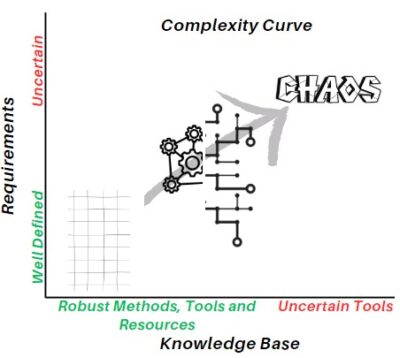 Production Ramp-Up – Increasing productivity on the system could take a little bit longer than anticipated, provided that the amount of complexity of the system is taken into consideration. According to what was stated earlier, this is the point at which the rewards for the entire process become materialized. In the event that the process is carried out in a methodical and precise manner, it is possible that anarchy will be averted, and the production ramp will proceed without any problems.
Production Ramp-Up – Increasing productivity on the system could take a little bit longer than anticipated, provided that the amount of complexity of the system is taken into consideration. According to what was stated earlier, this is the point at which the rewards for the entire process become materialized. In the event that the process is carried out in a methodical and precise manner, it is possible that anarchy will be averted, and the production ramp will proceed without any problems.
However, when, not if, chaos wants to reign, rely heavily on this process and have faith that it will bring value to your organization.
A valid point could be made here that the speed of a hand-off might affect the thoroughness of system control. However, it’s crucial to find a balance between efficiency and effectiveness. We can implement structured protocols that ensure essential checks and reviews are conducted without unnecessary delays. Additionally, leveraging technology to streamline communication and documentation during hand-offs can help maintain thoroughness while still achieving timely transitions. We should also encourage ongoing feedback to continually refine our processes, ensuring they support both speed and thorough system oversight.
Also, rushing the production ramp-up can have serious repercussions on system quality. If we prioritize speed over careful transition planning and resource allocation, we risk overlooking critical quality assurance measures. It’s important to establish a well-defined ramp-up strategy that allows for sufficient testing, training, and iteration. Involving cross-functional teams in the planning phase can help identify potential pitfalls and ensure that we maintain high-quality standards. Ultimately, a thoughtful approach to ramp-up phases can prevent costly setbacks down the line and enhance overall system reliability.
Product Quality – Undoubtedly, the success of both your client and your organization is directly linked to the quality of the end outcome. This is a fact that cannot be disputed. In spite of the fact that this course is centered on the execution of projects or the quality of projects through the employment of superior engineering methods, this does not, in the end, guarantee that the result will be of a high grade. In spite of this, the quality of the end outcome is intrinsically linked to the project itself at this point in time.
Business.com writes, “Product quality can make or break your brand’s success and profitability. In fact, when Deloitte surveyed consumers on why they purchase from a specific brand, “quality” was cited among the top three reasons up to 86 percent of the time.
Product quality describes a product’s capability to meet user standards. However, what defines “quality” often depends on the type of product, according to Jennifer Garrett, senior vice president of product development and design at JEM Accessories.
‘If it’s a simple product with no user interface tech, then it’s definitely in the materials that make the most [impact on] product quality,’ Garrett told us. “But if it’s … a smartphone or a tech product, then it’s definitely the user interface.’
Sammi Caramela. Elevating Expectations: 6 Ways Product Quality Affects Your Brand. business.com. Published December 10, 2015. Accessed January 12, 2025. Link
When faced with the argument that the definition of quality is subjective and varies across consumer demographics, let us acknowledge that while perceptions of quality can indeed differ based on cultural, social, and personal factors, there are overarching principles that define quality across most contexts. These principles often hinge on reliability, durability, performance, and value for money. For example, while a luxury item may be perceived as high quality in one demographic due to brand prestige, other consumers may prioritize functionality and longevity as their markers of quality. Thus, while subjective elements exist, there remains a universal recognition of quality that transcends demographic differences, especially in mission-critical domains like healthcare, safety, and food production.
On the viewpoint that marketing and brand reputation can outweigh product quality in consumer purchasing decisions, while effective marketing can create demand, it cannot sustain a product in the long run if the product itself does not meet quality expectations. Consumers today are more informed and connected than ever, and online reviews, social media, and word-of-mouth can rapidly amplify the opinions about a product’s quality. Therefore, while marketing can initially attract consumers, it is ultimately the quality of the product that drives repeat business and brand loyalty. A strong reputation built on consistent quality can elevate a brand, but if the product fails to deliver, that reputation can quickly deteriorate.
When considering the argument that even high-quality products can fail in the market due to factors like poor timing or adverse economic conditions, yes, external elements can significantly influence market success. For instance, a revolutionary, high-quality product may not find its audience if launched during an economic downturn when consumers are more budget-conscious. However, I would emphasize that in the long-term, quality is a significant differentiator that can lead to recovery and success. Additionally, those high-quality products that do manage to mitigate external challenges often adapt and innovate, reinforcing the idea that quality is a critical asset that lends itself to resilience in various market conditions. Quality-oriented brands typically have an edge in recovering from downturns, as consumers are ultimately more likely to trust and return to products they perceive as high quality, regardless of market fluctuations.
Continuous Production – Your company will enter the period of continuous production once it has completed the process of ramping up on the new system and has reached a position where it is comfortable with the operations and quality of the system. The process of operating and maintaining the system requires a substantial amount of effort; nevertheless, the project management team and the stakeholders have the ability to shift their attention away from the project and embark on different initiatives.
 Continuous manufacturing should include the monitoring of key performance indicators (KPIs) on a daily basis as well as the measurement of overall equipment effectiveness (OEE). There are a lot of wonderful instruments suitable for this purpose that can be found in manufacturing and even service providers; some of these instruments are more difficult than others. However, the most fundamental way for estimating OEE is to measure the entire intake and total output over a period of time. This is the method that gives the most accurate results. Therefore, if your system was scheduled to manufacture 10,000 10oz widgets using 2,500 50oz sheets of materials during a shift, and it created 9,500 widgets using 2450 sheets of materials, then the overall efficiency of the system (OEE) measurement would be 95%, but the yield would be 77%.
Continuous manufacturing should include the monitoring of key performance indicators (KPIs) on a daily basis as well as the measurement of overall equipment effectiveness (OEE). There are a lot of wonderful instruments suitable for this purpose that can be found in manufacturing and even service providers; some of these instruments are more difficult than others. However, the most fundamental way for estimating OEE is to measure the entire intake and total output over a period of time. This is the method that gives the most accurate results. Therefore, if your system was scheduled to manufacture 10,000 10oz widgets using 2,500 50oz sheets of materials during a shift, and it created 9,500 widgets using 2450 sheets of materials, then the overall efficiency of the system (OEE) measurement would be 95%, but the yield would be 77%.
In the event that your software as a service (SaaS) offering does not fall under the purview of OEE controls, it is likely that the uptime of your service would be affected. To put it another way, the uptime of a system should not only reflect whether or not the servers are operational, but it should also indicate whether or not the application functions are being carried out in a timely manner. This is essentially the same thing. It is anticipated that the performance of these kinds of systems will be between 99 and 99.99%, and they require higher levels of performance.
Addressing the concern that focusing solely on Key Performance Indicators (KPIs) and Overall Equipment Effectiveness (OEE) might oversimplify performance evaluation, let us acknowledge that while these metrics are crucial for quantifying efficiency and productivity, they do not capture the entire picture. Performance evaluation is inherently complex and should include qualitative assessments and contextual considerations. Metrics like KPIs and OEE provide tangible data that can help identify trends and areas for improvement, but they should be complemented with a deeper analysis of underlying processes, employee engagement, and customer satisfaction. A balanced approach, which incorporates both quantitative and qualitative insights, enables a more comprehensive understanding of system performance.
To the claim that monitoring KPIs daily could promote a reactive rather than proactive approach to system management; while there is some validity in that concern, the effectiveness of KPI monitoring largely depends on how the data is used. Daily tracking can indeed highlight immediate issues, but it shouldn’t lead to hasty decisions without further analysis. A proactive strategy involves understanding trends over time, which can be facilitated by regular monitoring. By analyzing daily data in the context of broader objectives and long-term goals, organizations can respond dynamically while still anticipating challenges and opportunities, thereby fostering a proactive culture of continuous improvement.
It is also important to recognize the potential pitfalls of over-reliance on quantitative metrics while overlooking qualitative factors. Metrics can provide objective insights into performance, but they may lack the nuance needed to fully understand the human and emotional aspects of an organization. For instance, employee satisfaction and customer feedback can significantly influence productivity and loyalty, yet they are often harder to quantify. An example of this is a minor product change due to feedback which, if not understood or integrated properly with the engineered system, could cause upsets and productivity issues. Ignoring these qualitative elements can result in a misaligned strategy that fails to engage employees or meet customer needs effectively. Therefore, integrating both quantitative and qualitative assessments provides a more holistic view that can drive better decision-making and enhance overall system performance. Balancing hard data with soft insights can lead to a healthier organizational culture and ultimately better outcomes.
Project Close Out – As a result of the completion of the punch list in its entirety and the assumption of production by operations, the moment has come to bring the project to a successful conclusion. In addition, a detailed description of the costs has been prepared, and there are no accounts receivable or payable that are related to the project. It is recommended that a post-project review and lessons learned session be organized whenever it is thought essential to do so. You may strengthen and make your engineering business process more bulletproof by taking advantage of these sessions, which provide you with the opportunity to document and alter your process. This will allow you to strengthen and make your process more bulletproof.
When addressing someone who argues that post-project reviews can be seen as redundant and potentially wasteful of time and resources, it’s important to acknowledge their concerns while emphasizing the value of these reviews. While it may seem like an additional task, post-project reviews serve as a crucial opportunity for reflection and learning. These reviews are also a great time to bring the team together and celebrate the accomplishments, this can be an important worker appreciation event for the stakeholders to engage in. They also help identify what worked well and what didn’t, which can significantly enhance the efficiency and outcome of future projects. Additionally, the time invested in these reviews can lead to greater cost savings and improved performance down the line, as lessons learned can lead to refined processes and better decision-making in subsequent projects. Ultimately, the insights gained from these reviews often outweigh the time spent, as they prevent the repetition of mistakes and promote continuous improvement.
In response to someone who claims that the lessons learned from one project may not be applicable to different types of projects in the future; let us highlight that while some specifics may differ, many foundational principles of project management and team dynamics remain consistent across various projects. The process of examining challenges, successes, and team dynamics can yield insights that are universally relevant, such as communication strategies, risk management approaches, and stakeholder engagement techniques. By keeping the focus on the underlying principles and frameworks, teams can adapt these lessons to fit the unique context of future projects, potentially leading to more innovative solutions and improved outcomes.

Case Study 9 – Acceptance Stage
General Mills, the owner of TNT Crust, wanted to provide partially cooked pizza crusts for the fast food business. Having a mechanism for buyers of these crusts to rely on a consistent high-quality base for the pizza’s lowered the need for the businesses to manage it themselves, taking up time and limiting the production rates of their businesses.
TNT Crust created several projects that involved placing production lines in the US mid-west. The projects involve large dough-making equipment, dough-rise ovens, and ‘par’ cooking ovens, along with packaging equipment. Project teams executed the onsite projects with the idea that several different products would be sold from the several lines.
 Once the lines were commissioned and during some final punch list activities, TNT Crust needed to validate the parcooked crusts with their clients. Clients took samples and tested with them and came back with desired changes prior to accepting the crusts at scale. The stakeholders and project management team anticipated this step and made sure the production lines had the capability to operate with multiple recipe alternatives and operating changes.
Once the lines were commissioned and during some final punch list activities, TNT Crust needed to validate the parcooked crusts with their clients. Clients took samples and tested with them and came back with desired changes prior to accepting the crusts at scale. The stakeholders and project management team anticipated this step and made sure the production lines had the capability to operate with multiple recipe alternatives and operating changes.
By 2033, the par-baked bread market in North America is projected to be worth $7,140.69 million USD. From 2023 to 2033, a CAGR of 4.0% is anticipated. By 2025, the regional market was predicted to be valued at more than US$5,100 million. The market is mostly driven by elements like this bread’s affordability, quality, and ease of use. Retailers and food service businesses may provide freshly baked bread without having to have a full-scale bakery on-site, thanks to par-baked bread.

Exercise 9 – Fluid motion
Group Size: Entire group
Group Size: Entire group
Project Studies

This session introduced you to the stage-gate process and considerations for conducting engineering projects within your company. Regardless if you are a product vendor, service provider, or engineering firm, this process will provide clear results. Prior to the next session, your team should execute the following:
Project Study (Part 1) – Process Mapping
The purpose of this section is to begin an engineering standards document or outline.
Start a master ‘Engineering Excellence’ document for your company. Make sure to include:
● Company Logo
● Title Page and Table of Contents
● Page Numbers
● Revision Control Box
● Signature Page
● Body Formatting
Start a boilerplate contract document set. Usually broken into disciplines (i.e., civil, mechanical, and electrical)
Stakeholders should get together, discuss, and document decisions to these concerns:
1. Projects teaming.
2. Steering committee participants.
3. Company deliverable types & completeness required.
4. Types of projects this standard will cover.
5. Minimal deliverables for the basic stage, representing an entire project.
6. Lists of standards, protocols, or publications that might be required.
7. Include a list of boilerplate contract documents and sections.
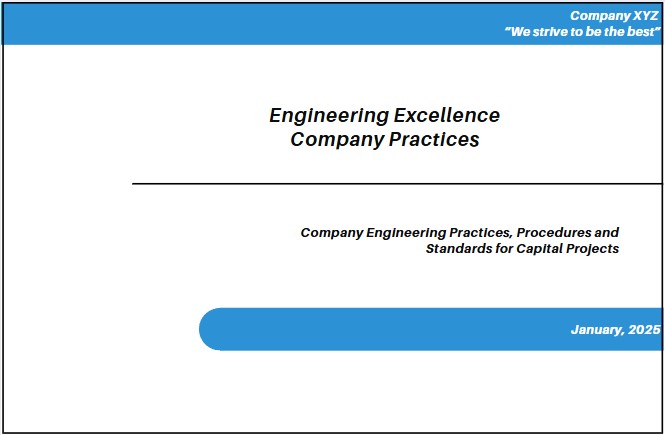
Project Study (Part 2) – Process Analysis
Roles and responsibilities should be made clear in your Engineering Excellence document for all the different players. A high-level business process should be created and included to show the flow of projects within your company. Recognizing your company may have several types of projects, think through the different scopes and requirements of each. Making a separate path is acceptable as long as the start and end points remain the same.
Project Study (Part 3) – Process Resources
Here are some appropriate subject matter resources for your study.
Bell R. Capital Program Management: Best Practices and Strategies. Oracle.com. Published August 7, 2024. Accessed January 25, 2025.Link
Successful capital project delivery The art and science of effective governance. PWC.com. Published 2012. Link
Accounting systems geared toward project management. Wikipedia.org. Published 2021. Accessed January 29, 2025. Link
ISO – Standards. ISO. Published 2015. Accessed January 25, 2025. Link
Blackline Safety. 10 Safety Incidents You Shouldn’t Overlook. Blacklinesafety.com. Published February 8, 2016. Accessed January 25, 2025. Link
IQ/OQ/PQ: The Exact Definition Of What It Is. Stendard. Published January 14, 2022. Accessed January 25, 2025. Link
What Is OEE (Overall Equipment Effectiveness)? | OEE. Oee.com. Published 2024. Accessed January 25, 2025. Link

Project Study (Part 4) – Process Communications
Communicating this new business process will be paramount to its success. How, when, and what you communicate is vital to think through to make sure the subject is understood. Authorization of these processes should also coincide with the communications.
Complete and authorize the initial draft of the engineering excellence document, then disseminate it throughout the organization. Update the schedule to show all the progress.
Project Study (Part 5) – Process Review & KPI
Start an action item log for this endeavor and plan on review sessions for the product(s) of this course. Are there any KPIs that make sense to list for the team? How will these be measured and tracked?
Program Benefits
Management
- Predictable Outcomes
- Process Driven
- Effective Leadership
- Transparency
- Resilient Organization
- Increased Flexibility
- Strong Accountability
- Actionable Intelligence
- Increased Enthusiasm
- Increased Engagement
Production
- High Quality
- High Yields
- Lower Costs
- Team-Based
- Great Analytics
- Improved Reporting
- Lower Waste
- Less Risk
- Improved Supply-Chain
- Increased Utilization
Finance
- Increased Certainty
- Highly Granular
- Improved Analytics
- Actionable Intelligence
- Strong Relationships
- Improved Reporting
- Increased Engagement
- Improved Returns
- Team Driven
- Higher Satisfaction
Client Telephone Conference (CTC)
If you have any questions or if you would like to arrange a Client Telephone Conference (CTC) to discuss this particular Unique Consulting Service Proposition (UCSP) in more detail, please CLICK HERE.
